1815 |
JAMAICA LETTER |
|
Kingston, Jamaica
September 16th 1815
 |
| Portrait of Simón Bolívar by Pedro José Figueroa (Colombia) |
No other figure in Latin American history has had a more profound effect on the concept of Inter-American unity and cooperation than Simón Bolívar. He was the first to express forcefully the idea of Inter-American organization and take action to form one. On September 16th 1815, during his self-imposed exile in Jamaica, Simón Bolívar wrote his famous manifesto for Pan-American unity and independence, the Carta de Jamaica (Jamaica Letter). In it, he examined the historical successes achieved up until that point in the struggle for independence of the Americas and the justifications and causes of the movement. The most powerful message underscored in the letter, was Bolívar’s determination to achieve a union of the countries of the Americas, a conviction that he would have for the rest of his life and that would see its first expression at the Congress of Panama.
RELEVANT DOCUMENTS
|
1823 |
MONROE DOCTRINE |
|
City of Washington, United States
December 2nd 1823
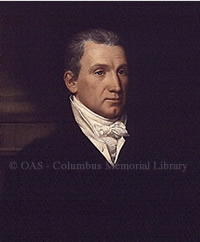 | 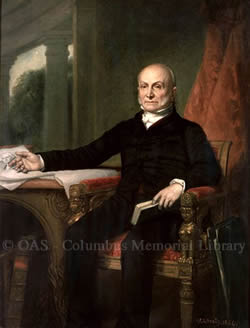 |
| Portrait of James Monroe by John Vanderlyn, Oil on canvas, 1816 National Portrait Gallery, Smithsonian Institution | Portrait of John Quincy Adams by George Peter Alexander Healy, 1858 |
The Monroe Doctrine was a cornerstone of U.S. foreign policy introduced by President James Monroe in his Seventh Annual State of the Union address to Congress on December 2nd 1823. The Monroe Doctrine emphasized three main points: separate spheres of influence of the Old World and New World, non-colonialism, and non-intervention. The United States would not intervene in the disputes or internal affairs of the European powers. Furthermore, the United States recognized and would not interfere in the existing colonies of the Western hemisphere. European powers were not to further colonize or interfere with the States of the Americas; doing so would be considered an act of aggression requiring US intervention. The Monroe Doctrine has been reinterpreted numerous times since its introduction.
RELEVANT DOCUMENTS
|
1826 |
THE CONGRESS OF PANAMA |
|
Panama City, Panama
June 22nd -July 15th 1826
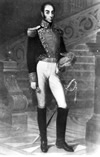 |
|
Bolívar, the organizer of the historic Congress of Panama, ushered in some of the region’s first peace-based tools.
|
The Congress of Panama was a convention organized by Simón Bolívar in 1826 with the aim of bringing together the Latin American countries and developing a unified policy towards Spain. Bolívar envisioned a united Americas able to cement and protect the newly independent republics. Held in Panama City from June 22nd to July 15th 1826, the meeting proposed the creation of a League of American Republics, with a common military, mutual defense pact, and a supranational parliamentary assembly. It was attended by representatives of four American States - Mexico, the United Provinces of Central America (Guatemala, El Salvador, Honduras, Nicaragua, and Costa Rica), Gran Colombia (comprising the modern-day nations of Colombia, Ecuador, Panama, and Venezuela), and Peru.
The "Treaty of Union, League, and Perpetual Confederation" drawn up at that Congress would have bound all parties to mutual defense and to the peaceful settlement of disputes. Even though the Treaty never became effective, it is significant as it set the precedent for the International Conferences of American States. ¹

RELEVANT DOCUMENTS
- Letter of Invitation by Simón Bolívar English | Español
- Colombia’s Reply to Bolívar’s Invitation English | Español
- Treaty of Union, League and Perpetual Confederation English | Español
- Views on the Congress of Panama (from an unpublished manuscript in the “Archives of the Liberator” - Caracas) English | Español
- Delegates to the Congress Español
- Original Circular Invitation Español
- Original Treaty of Union, League and Perpetual Confederation Español
SPEECHES
- Address of the President of the Congress of Panama on the installation of the assembly English
- Address of Don Manuel Lorenzo de Viduarre English
¹ G. Pope Atkins. Encyclopedia of the Inter-American System. (Westport, Connecticut and London: Greenwood Press, 1997) 6-9.
|
1847 |
CONGRESS OF LIMA |
Lima, Peru
December 11th 1847 - March 1st 1848
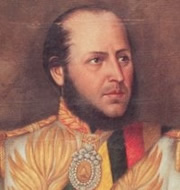 |
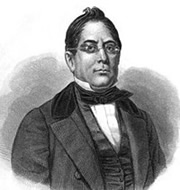 |
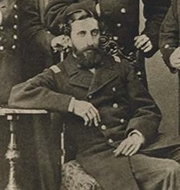 |
| Señor Don José Ballivián (May 5, 1805 – October 6, 1852) 11th President of Bolivia |
Diego José Benavente Bustamante (Concepción, Chile, 1790 - Santiago, Chile, 1867) Chilean politician and prominent figure in the era of independence |
Señor Don Manuel José Ferreyros
(1833-1876) Prominent Peruvian Captain Commander Lieutenant |
With the threat of a possible Spanish re-conquest of the Andean States of South America, five countries: Bolivia, Chile, Ecuador, Colombia and Peru, met at the “American Congress” to safeguard their national sovereignty and strengthen alliances. Two treaties and two conventions were signed, the most important of which was the Treaty of Confederation between the Republics of Peru, Bolivia, Chile, Ecuador and New Granada (Treaty of Lima), signed on February 8th 1848. The Treaty of Lima set up a confederation of signatory nations with the aim of bolstering relations between the countries, combining their resources; and arranging for the peaceful settlement of disputes. The congress forbade the use of force and called for the use of good offices and mediation.
RELEVANT DOCUMENTS
- Tratado de Confederación entre las Repúblicas del Perú, Bolivia, Chile, Ecuador y Nueva Granada. Español
|
1856 |
CONTINENTAL CONGRESS OF SANTIAGO |
Santiago, Chile
September 15th 1856
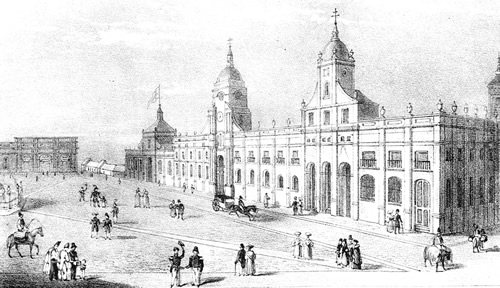
The Continental Congress was held in Santiago, Chile on September 15th 1856 and was attended by Chile, Peru and Ecuador. It was brought about by the concern over US interests due to the activities of William Walker and other US adventurers in Central America and also the US British rivalry over a possible future inter-oceanic route. The Delegates signed the Treaty of Alliance and Reciprocal Assistance (Continental Treaty) which stated that in case one or more of the countries party to the contract were under threat, all would unite in defense. The threat subsided and the Treaty was never ratified but it served to further broaden the concept of reciprocal assistance and laid the foundation for the Treaty of Alliance and Confederation, signed that same year at the Congress of Washington.¹
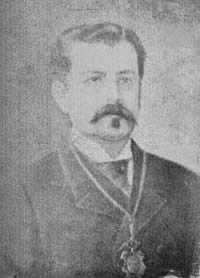 |
| Senor Don Félix Cipriano Coronel Zegarra (Revista "El Derecho", 1897) Peruvian diplomat and historian |
RELEVANT DOCUMENTS
- Continental Treaty of Alliance and Reciprocal Assistance. Español
¹ O. Carlos Stoetzer, The organization of American States (Westport, Connecticut and London: Praeger, 1993 ed.) 9-10.
|
1856 |
CONGRESS OF WASHINGTON |
City of Washington, United States
November 9th 1856
The diplomatic representatives of Costa Rica, El Salvador, Guatemala, Honduras, Mexico, New Granada (Colombia), Peru and Venezuela met at the Congress of Washington on November 9th 1856 and signed a new Treaty of Alliance and Confederation, building upon the Continental Treaty signed earlier that year in Santiago.
The treaty amplified the concept of reciprocal assistance to include acts of private persons, irrespective of whether they were citizens of the targeted country. The signatories agreed to prevent hostile activities on their soil directed against any of them, including those committed by foreigners or political exiles.
|
1864 |
SECOND CONGRESS OF LIMA |
Lima, Peru
November 14th 1864 - March 13th 1865
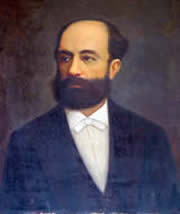 |
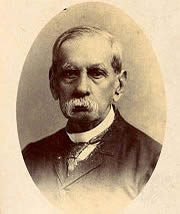 |
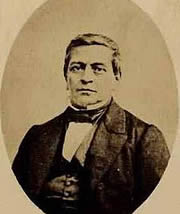 |
| José Gregorio Paz Soldán, Peruvian diplomat and politician |
Justo Arosemena, Colombian & Panamanian diplomat and politician |
Manuel Montt, Chilean diplomat and politician |
The Second Congress of Lima was prompted by the French occupation of Mexico, the Spanish return to Santo Domingo and the Spanish war with Chile and Peru. Argentina, Bolivia, Chile, Colombia, Ecuador, El Salvador, Guatemala, Venezuela and Peru met from November 14th 1864 through March 13th 1865 and signed the Treaty of Union and Defensive Alliance and the Treaty for the Preservation of Peace between the Contracting American States. The delegates committed themselves to arbitration in cases where the contracting parties were not able to resolve a dispute. Although these treaties were never ratified, they were a reaffirmation of the principles of Inter-American unity and peace.
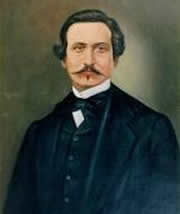 |
 |
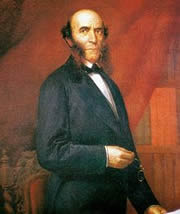 |
| Vicente Piedrahíta Carbo, Ecuadorean diplomat and politician |
Pedro Alcántara Herrán, Salvadorean diplomat and politician |
Antonio Leocadio Guzmán, Venezuelan diplomat and politician |
RELEVANT DOCUMENTS
- Tratado de Union y Alianza Defensiva Entre los Estados de America Contratantes Español
- Tratados Sobre Conservacion de la Paz Entre los Estados de America Contratantes Español
|
1877 |
THE JURIDICAL CONGRESS OF LIMA |
Lima, Peru
December 13th 1877 - March 27th 1880
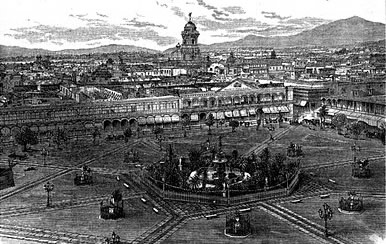
The Juridical Congress of Lima was attended by representatives of Argentina, Bolivia, Chile, Costa Rica, Ecuador, Guatemala, Peru, Uruguay, and Venezuela. Cuba was in the process of fighting against Spain to gain independence so it was represented and participated but was not formally recognized. The meeting produced two treaties:a treaty establishing uniform rules in matters of private international law which was signed by Peru, Argentina, Chile, Bolivia, Ecuador, Venezuela, and Costa Rica; and a treaty on extradition, which was signed by those countries as well as Guatemala and Uruguay.
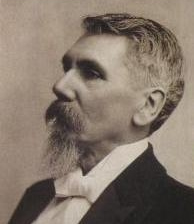 |
 |
| José E Uriburu, Argentine lawyer and politician |
Antonio Arenas Merino, President of Peru |
RELEVANT DOCUMENTS
- Tratado Para Establecer Reglas Uniformes en Materia de Derecho Internacional Privado 1877 Español
- Tratado de Extradicion Español
|
1889 |
FIRST INTERNATIONAL CONFERENCE OF AMERICAN STATES |
Washington, DC, United States
October 2nd 1889 - April 19th 1890
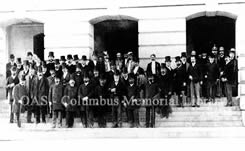 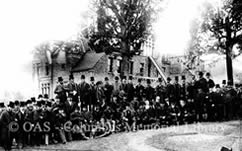
The First International Conference, held in Washington DC, from October 2nd 1889 - April 19th 1890, was dedicated principally to laying the foundations for economic cooperation between the American States and to establishing a plan of arbitration for the peaceful settlement of disputes that might arise among them. All the existing republics, except for the Dominican Republic, were represented.
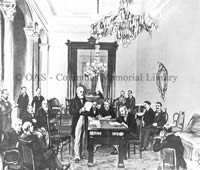 An association entitled “The International Union of American Republics” was created as well as an organ to represent this union, called “The Commercial Bureau of American Republics” which marked the beginning of the regional organization of the Americas. This resolution was adopted on April 14th, 1890, a date that continues to be observed as Pan American Day. Although the Treaty lacked the ratifications needed to go into effect, it served as a forerunner and basis for the adoption of similar procedures that would be incorporated in subsequent instruments.¹ An association entitled “The International Union of American Republics” was created as well as an organ to represent this union, called “The Commercial Bureau of American Republics” which marked the beginning of the regional organization of the Americas. This resolution was adopted on April 14th, 1890, a date that continues to be observed as Pan American Day. Although the Treaty lacked the ratifications needed to go into effect, it served as a forerunner and basis for the adoption of similar procedures that would be incorporated in subsequent instruments.¹
RELEVANT DOCUMENTS
NEWSPAPER CLIPPINGS
¹ The Inter-American System: Its Development & Strengthening. (Dobbs Ferry, New York: Oceana Publications, 1966) xx-xxi.
|
1899 |
FIRST PEACE CONFERENCE AT THE HAGUE |
The Hague, The Netherlands
May 18th 1899
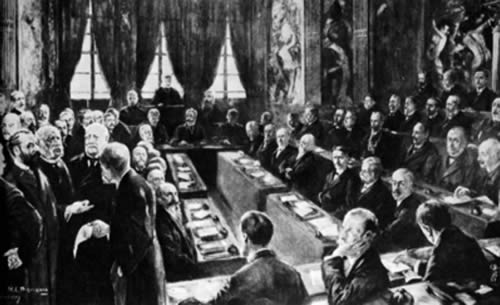
Painting of Delegates at the First Peace Conference at the Hague, from “The Age of Expansion”, 1848-1917 by Marcus Cunliffe. Publisher: Weidenfeld and Nicolson
The First Peace Conference was the initiative of Czar Nicholas II of Russia and Queen Willhelmina of the Netherlands. The Conference was held on May 18th 1899 at the summer residence of the royal family, the Palace Huis ten Bosch. The United States attended. Mexico was the only Latin American country to participate. Brazil had been invited but did not attend. The Conference adopted conventions on investigation and arbitration of conflicts, and called for the voluntary peaceful resolution of controversies. The conference also provided for the creation of a Permanent Court of Arbitration.
RELEVANT DOCUMENTS
- 1899 & 1907 Conventions for the Peaceful Settlement of International Disputes. English

|
1902 |
SECOND INTERNATIONAL CONFERENCE OF AMERICAN STATES |
Mexico City, Mexico
January 20th 1902
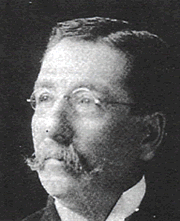 |
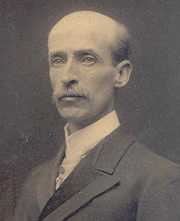 |
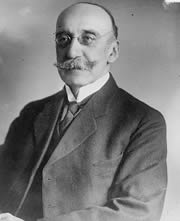 |
| Fernando E. Guachalla, Bolivian Ambassador |
Pablo Macedo Saravia, Mexican politician |
José López Portillo y Rojas, Mexican politician |
The Second International Conference of American States was held in Mexico City, from October 22nd 1901 until January 31st 1902. Twenty American Republics were represented. American nations committed themselves to submit to diplomatic and peace-oriented arbitration to solve disputes.
The Treaty of Compulsory Arbitration was signed on January 29th 1902 by nine states (Argentina, Bolivia, Dominican Republic, El Salvador, Guatemala, Mexico, Paraguay, Peru and Uruguay). It was ratified by six of them and entered into force on January 31st 1903.¹ The Treaty provided that all disputes be submitted to the Permanent Court of Arbitration at The Hague and established procedures of good offices and mediation. Furthermore, it anticipated the establishment of an International Commission of Inquiry.²
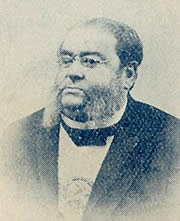 |
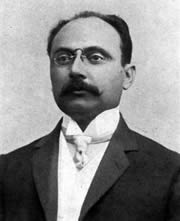 |
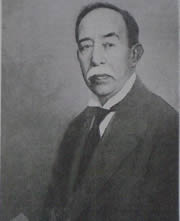 |
| Juan Lindolfo Cuestas, President of Uruguay |
Cecilio Báez González, President of Paraguay |
Antonio Bermejo, Argentinian politician & President of the Supreme Court of Justice |
RELEVANT DOCUMENTS
- Treaty of Compulsory Arbitration. Download: English | Español
- Protocol of adherence to the Conventions of the Hague. Download: English | Español
¹ G. Pope Atkins, Encyclopedia of the Inter-American System (Westport, Connecticut and London: Greenwood Press, 1997) 445.
² O. Carlos Stoetzer, The Organization of American States (Westport, Connecticut and London: Praeger, 1993 ed.) 266.
|
1902 |
PACTOS DE MAYO |
Santiago, Chile
May 28th 1902
 |
First Treaty on the Limitation of Naval Armament “Pactos de Mayo”, May 28, 1902.
Dr. Germán Riesco, Chilean President (left), Dr. José A. Cerry, Plenipotentiary Minister, Argentina (center), Dr. José Francisco Vergara Donoso, Minister of Foreign Affairs, Chile (right). |
Pactos de Mayo or Pacts of May, are four protocols signed by Argentina and Chile on May 28th 1902. The pacts included a Treaty of Arbitration which outlined a framework for resolving territorial disputes and established the present day boundaries between Chile and Argentina in Patagonia. An arms control pact ended the arms race that had ensued between the two countries.
RELEVANT DOCUMENTS
- Tratado General de Arbitraje Español
- Convencion Sobre Limitacion de Armamentos Navales Español
- Protocolo Adicional Sobre Limitacion de Armamentos Navales Español
- Acta Aclaratoria Sobre Aribitraje Y Limtacion de Armamentos Español
- Notas Sobre Interpretacion de la Segunda Parte del Articulo Primero de la Convencion Para Limitar Los Armamentos Navales Español
- Acta Sobre Demarcacion de la Linea Limitrofe Entre Chile y la Argentina Español
|
1907 |
SECOND HAGUE PEACE CONFERENCE |
The Hague, The Netherlands
June 15th - October 18th 1907
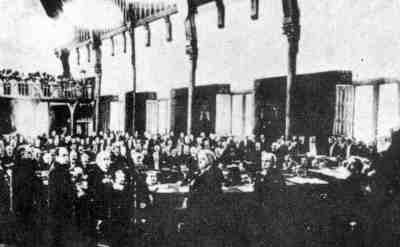
Hall of the Peace Palace
The Second Hague Peace Conference took place at the initiative of President Roosevelt on June 15th 1907 through October 18th 1907 at the Hague Peace Palace. In contrast to the first Hague Peace Conference of 1899, practically the entire membership of the Western Hemisphere; (Republic of Argentina, Bolivia, United States of America, Chile, Colombia, Republic of Cuba, Dominican Republic, Republic of Ecuador, Guatemala, Republic of Haiti, Mexico, Nicaragua, Panama, Paraguay, Peru, Salvador, Uruguay, United States of Venezuela), participated in these deliberations. The conference opened a protocol of adherence to the 1899 conventions and all of the other states became party to the conventions, with the exception of Costa Rica and Honduras. The Latin American countries pushed for non-intervention to be accepted as a principle of international law and placed a strong emphasis on questions of arbitration. The issues tackled at the Hague Conference would feature heavily in future Inter-American meetings to coordinate the hemispheric system.¹
RELEVANT DOCUMENTS
- 1899 & 1907 Conventions for the Peaceful Settlement of International Disputes. English
¹ G. Pope Atkins, Encyclopedia of the Inter-American System (Westport, Connecticut and London: Greenwood Press, 1997) 205.
|
1907 |
CENTRAL AMERICAN PEACE CONFERENCE |
Washington, DC, United States
November 14th – December 20th 1907
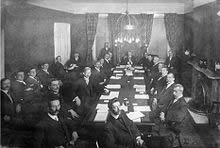 |
|
Opening Session of Central American Peace Conference |
The Central American Peace Conference was held in Washington DC from November 14th - December 20th 1907 and attended by representatives of Costa Rica, Guatemala, Honduras, Nicaragua and El Salvador. Eight conventions were signed, among which a ten-year General Treaty of Peace and Amity, an Additional Convention to the General Treaty outlining the principle of non-recognition of any government coming to power by coup d’état or revolution, and the principle of non-intervention in civil wars. The most significant accomplishment of the Conference was the establishment of the first Permanent Court of Justice, the Central American Court of Justice headquartered in Cartago, Costa Rica.
The Central American Court of Justice was made up of five judges (one each from Costa Rica, El Salvador, Guatemala, Honduras, and Nicaragua). The Conference provided for the Court to deal with cases where individuals of one central American country could raise claims against individuals of another Central American government because of violation of treaties and is noteworthy as it set important precedents on the organization and application of international justice.
RELEVANT DOCUMENTS
- Address by US Secretary of State Elihu Root English
- General Treaty of Peace and Amity English
- Additional Convention to the General Treaty English
- Convention for the Establishment of a Central American Court of Justice English
- Bulletin: Inauguration of Central American Court of Justice, Pan-American Union Bulletin 1908 English
|
1908 |
LAYING OF THE CORNERSTONE OF THE INTERNATIONAL BUREAU OF AMERICAN REPUBLICS' BUILDING |
Washington, DC, United States
May 11th 1908
 John Barrett, Director General of the International Bureau of American Republics John Barrett, Director General of the International Bureau of American RepublicsA few of the new building's prominent features were described in the Bulletin of the International Bureau of American Republics, as follows: "The front elevation of the building interprets the two grand geographical divisions of the Americas. Sculptor Isidore Konti has typified the spirit of the Southern half of the Western continent is represented by a sculpture of a woman. The woman's figure, of heroic size, crowned by the Condor of the Andes, symbolizes wisdom, protection, and peace accorded to the spirit of progress expressed in the figure of youth at her side, holding in his outstretched hand the winged globe of advancement. One arm of the central figure is flung protectingly around the youth and the other rests upon a warlike shield, though the hand bears an olive branch. The lineaments of the two faces follow the characteristic Latin outlines, and in the palm branch and the parrot are shown the representative flora and fauna of South America. The bas-relief, forming one of the two panels in front of the building, also by Isidore Konti, depicts the memorable scene between San Martin and Bolivar at Guayaquil in 1822. The other panel is formed by a bas-relief by artist, Gutzon Borglum, and represents the historic scene so familiar to North Americans; Washington's farewell to his generals. The design of the building recalls the Spanish, Portuguese, French and English origins of many of the people constituting the Pan-American union, while the patio, pavement, and fountain are dedicated to the advanced civilizations of the early Peruvians, the Mayans, the Zapotecans, the Toltecs, and the Aztecs. Symbolic figures, around the pillar of the electric fountain in the center of the patio, represent the three ancient Mexican races-Aztec, Zapotecan, and Mayan. They were designed and executed by Gertrude Vanderbilt Whitney. The feathered serpent of Uxmal has been reproduced in the Hall. Bronze friezes by Sally James Farnham of New York, ornament the room of the Governing Board, and illustrate some of the early struggles and decisive events in the history of the 'new world'. On the front elevation, above all the significant ornamentation, are the birds of North and South America regarding one another with expressions of mutual admiration, confidence and respect".
RELEVANT DOCUMENTS
- Newspapers with notice of ceremony of laying of corner-stone. English
SPEECHES
Bulletins of the International Bureau of the American Republics:
ARTICLE EXCERPTS
- Collier’s May 23rd 1908, “A Capitol for the Two Americas” by Samuel E. Moffat English
- Review of Reviews, June 1908 English
- Editorial written by Jules Meulmans, Director & Editor in Chief of “La Revue Diplomatique” of Paris, May 17th 1908 English
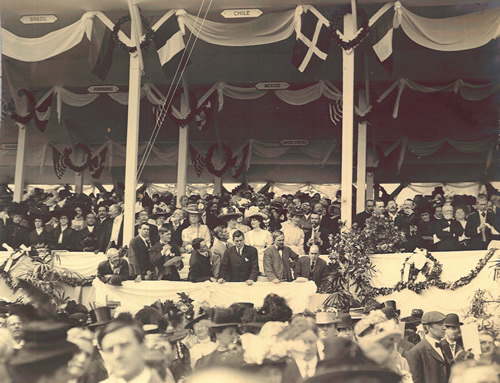
International Bureau of American Representatives Ceremony of Laying of the Cornerstone. 1908
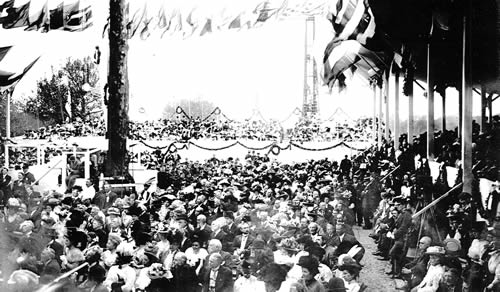
View of the rear, showing flags
|
1910 |
INAUGURATION OF HOUSE OF THE AMERICAS AND PLANTING OF THE PEACE TREE |
Washington DC, United States
April 26th 1910
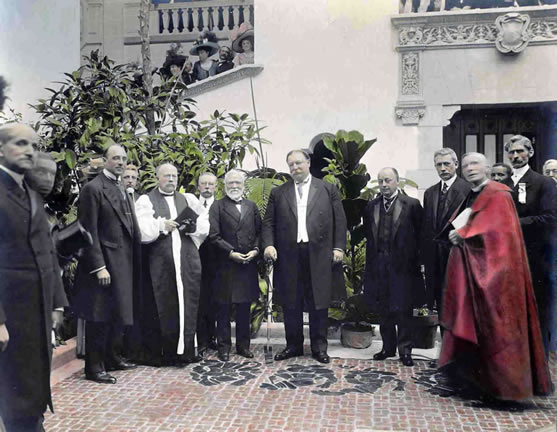
Planting of the Peace Tree. From left to right: Mr. John Barrett, Director General of the International Bureau of American Republics; Bishop Harding; Amb. de la Barra; Mr. Andrew Carnegie; US President William Taft; US Secretary of State, Philander O. Knox; Senator Elihu Root; James Cardinal Gibbons; Frederick D. Owen.
On April 26th 1910, United States President William Taft inaugurated the House of the Americas with a ceremony in which he planted the “Tree of Peace” in the central patio of the new building. The House of the Americas was built on land donated by the US government, with two-thirds of the funds ($750,000) contributed by philanthropist Andrew Carnegie, who dubbed it ‘Temple of Peace of the Americas’. The buiding was designed by Architects Paul Cret and Albert Kelsey and conceived to represent the diverse history, cultures and values of the Americas. It became the headquarters of the International Bureau of American Republics, later Pan American Union and present Organization of American States, and a famous DC landmark.
SPEECHES
- Invocation by Cardinal Gibbons English
- Philander C. Knox, United States Secretary of State address English
- Director John Barrett address English
- Architect Albert Kelsey’s statement on behalf of himself and Architect Paul Cret English
- United States Senator Elihu Root Address English
- Mexican Ambassador, Mr. F.L. de la Barra address English
- Andrew Carnegie Address English
- President Taft Address English
- Benediction by Right Reverend Bishop Alfred Harding English
 
Inauguration of the new building - 1910
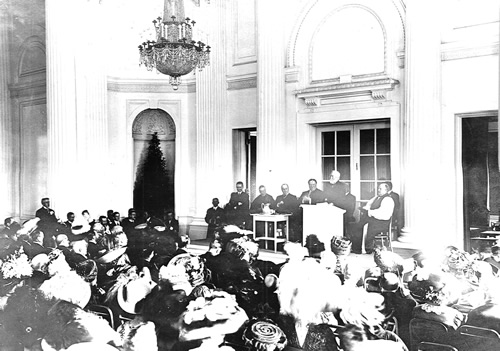
Mr. Andrew Carnegie speaking, President William H. Taft, John Barrett, Director General Pan American Union, Bishop Harding, James Cardinal Gibbons, International Bureau of American Republics The dedication of the new building of the Pan American Union, April 26th 1910

Breaking of the rope of roses by President William H. Taft at Opening of new Pan American building, August 26, 1910

Arrival at the opening of the new building of the Pan American Union

|
1910 |
FOURTH INTERNATIONAL CONFERENCE OF AMERICAN STATES |
Buenos Aires, Argentina
July 12th - August 30th 1910
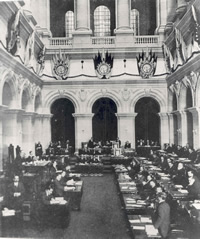 |
| Palace of Justice, Buenos Aires, where the 4th International Conference was held |
In 1910, the Fourth International Conference changed the name of the International Union of American Republics to Union of American Republics, while the Commercial Bureau of American Republics received the name Pan American Union. The conference also resolved to recognize Andrew Carnegie for his generous gift towards the cost of the new building of the Pan American Union and his contributions to the Pan American cause. To this end, the conference resolved to hold a Special Session of the Governing Board of the Union to present a medal to Andrew Carnegie as a symbol of the American republics’ gratitude.
RELEVANT DOCUMENTS
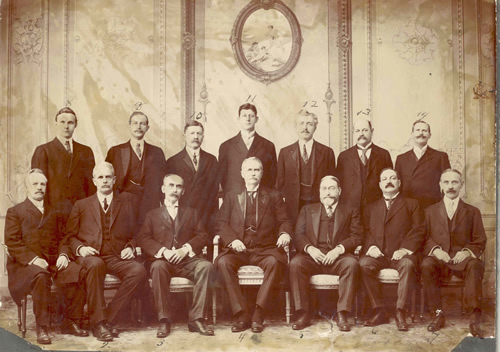
Delegates of the 4th International Conference
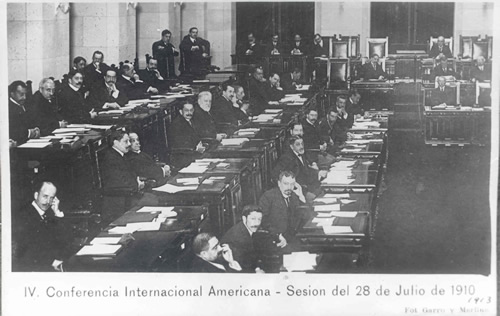
Delegates seated during the Conference
|
1911 |
SPECIAL SESSION OF THE GOVERNING BOARD OF THE PAN AMERICAN UNION TO HONOR ANDREW CARNEGIE |
Washington DC, United States
May 9th 1911
On May 5th 1911, in accordance with a resolution adopted at the Fourth International Conference of American States, a Special Session of the Governing Board of the Union was held to honor Andrew Carnegie and express the American Republics’ gratitude for his vast contributions to the Pan American cause and for his generous gift towards the cost of the new Pan American Union building, House of the Americas. A large audience of distinguished guests, numbering over 1000, gathered in the Hall of the Americas. The Ambassador of Mexico, Senor Don Manuel de Zamacano e’ Inclan, in the presence of the US President and Secretary of States, members of the diplomatic corps, senators, congressmen and Supreme Court judges, presented Andrew Carnegie with a gold medal, engraved with Benefactor of Humanity.
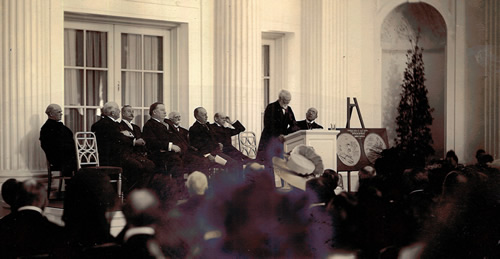
Andrew Carnegie accepting the Medal
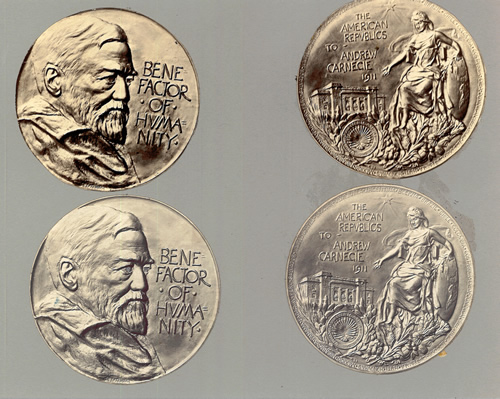
Medal presented to Andrew Carnegie, Benefactor of Humanity
SPEECHES
- Address by Right Revereand William T. Russell English
- Address by Philander C. Knox English
- Address by Ambassador of Mexico, Senor Don Manuel de Zamacano e’ Inclan English
- Address by Andrew Carnegie English
- Address by US President Taft English
|
1914 |
PAN AMERICAN UNION, MEETING OF THE GOVERNING BOARD |
Washington DC, United States
December 8th 1914
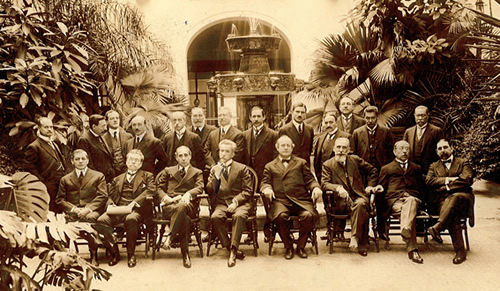
Delegates of the Meeting of the Governing Board sitting in the courtyard of the House of the Americas
Member countries met at the Pan American Union on December 8th 1914 to consider questions of neutrality in the European War. This was considered one of the most important international meetings held in Washington. The Governing Board resolved to create a special commission consisting of nine members, of which Secretary of State of the United States would form part, acting as Chairman thereof, ex officio. These were: US Secretary of State, Hon. William J. Bryan, Chairman; Señor Domicio da Gama, Ambassador from Brazil; Señor Don Eduardo Suárez Mujica, Ambassador from Chile; Señor Dr. Rômulo S. Naón , Ambassador from Argentina; Señor Dr. Carlos María de Pena, Minister from Uruguay, Señor Don Federico Alfonso Pezet, Minister from Peru; Señor Dr. Alberto Membreño, Minister from Honduras, Señor Dr. Carlos Manuel de Céspedes, Minister from Cuba, Secretary. The Special Committee was tasked with studying the problems of the war in Europe and submitting suggestions to the Governing Board. For any questions technical in nature, the Committee was to consult the Board of Jurists. Each Government could submit such plans or resolutions.
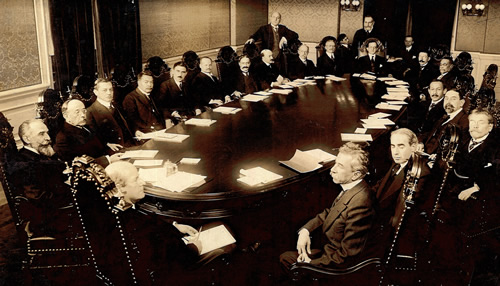
Governing Board members at round table.
|
1923 |
FIFTH INTERNATIONAL CONFERENCE OF AMERICAN STATES |
Santiago, Chile
March 25th - May 3rd 1923
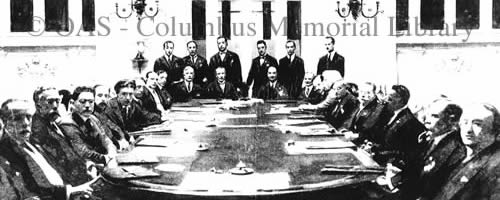
Meeting of the Presidents of the Delegations to the 5th International Conference of American States
The Fifth International Conference of American States, held March 25th to May 3rd 1923 in Santiago, provided signatories with recourse to investigatory and conciliatory measures to resolve a controversy.
The Gondra Treaty, proposed by statesman Manuel Gondra of Paraguay, was created to avoid or prevent conflicts between the American States.
The Gondra Treaty, “Treaty to Avoid or Prevent Conflicts between the American States” provided that all controversies and disputes should be submitted for arbitration in cases where diplomacy had failed, and to investigation by two five-member commissions, one in Washington DC and another in Montevideo, Uruguay. The role of the commissions was to receive requests for inquiries, investigate the controversies and issue a report within one year in each case. The parties agreed to make no preparations for war from the time the commission first convened, until 6 months after it issued its report. In essence, the treaty provided a cooling off period for the parties involved. The Treaty entered into force after being ratified by twenty countries in 1924.¹
The Gondra Treaty is significant because it was the first positive effort to establish, on a contractual basis, a procedure for preventing conflicts.
| TRANSITIONS OF THE GONDRA TREATY |
Gondra Treaty
(1923) |
Inter-American General Convention Of Conciliation
(1929)
|
Saavedra Lamas Agreement
(1933) |
Pact of Bogota
(1948) |
| Investigatory Commission; conciliatory offices in Washington DC and Montevideo; nonaggression during commission. |
Commissions of Inquiry better defined; adding wide powers of conciliation. |
Treaty of Non-Aggression and Conciliation; putting an end to the Chaco war between Paraguay and Bolivia. |
To refrain from the threat or the use of force, or from any other means of coercion for the settlement of their controversies, and to have recourse at all times to pacific procedures, including an investigative commission. |
RELEVANT DOCUMENTS
- “Gondra Treaty”
Treaty to avoid or prevent conflicts between the American States
Download: English | Español
NEWSPAPER CLIPPINGS
¹ G. Pope Atkins, Encyclopedia of the Inter-American System (Westport Connecticut and London: Greenwood Press, 1997) 446.
|
1928 |
SIXTH INTERNATIONAL CONFERENCE OF AMERICAN STATES |
Havana, Cuba
January 16th to February 20th 1928

Closing session of the International Conference of American States on Conciliation and Arbitration
The Sixth International Conference, held at Havana from January 16th to February 20th 1928 adopted the Convention on the Rights and Duties of States in the Event of Civil Strife. The Convention was the first modern attempt to deal with the issue of collective security. The contracting parties agreed that hostile forces should be prevented from going from the territory of one American state into that of another for the purpose of starting or promoting civil strife and were bound by four rules: 1) Prevent all inhabitants in their territory (nationals or aliens) from participating in or promoting civil strife, 2) disarm and apprehend rebel forces crossing their boundaries, 3) forbid the traffic in weapons or war materials destined for rebels whose cause has not been recognized, and 4) prevent the equipping of any crafts intended to operate in favor of civil strife.¹
The Additional Protocol to the Convention on Rights and Duties of States in the Event of Civil Strife was signed in 1957. The Conference also resolved to meet within the year in Washington DC, to convene a conference of conciliation and arbitration.
RELEVANT DOCUMENTS
- Convention on the Duties and Rights of States in the Event of Civil Strife. Download: English | Español
- Protocol to the Convention 1957 English | Español
- Resolution of Arbitration and Conciliation Conference English | Español
NEWS CLIPPINGS
- The Evening Star, January 13th 1928. English
- The Evening Star, January 18th 1928. English
- The Sunday Star, January 22th 1928. English
¹ G. Pope Atkins Ecyclopedia of the Inter-American System (Westport, Connecticut and London: Greenwood Press, 1997) 101.
|
1928 - 1929 |
THE SPECIAL INTERNATIONAL CONFERENCE OF AMERICAN STATES OF CONCILIATION AND ARBITRATION |
Washington DC, United States
December 10th 1928 - January 5th 1929

The Special International Conference of American States of Conciliation and Arbitration was held in Washington DC, from December 10th 1928 - January 5th 1929, in accordance with a resolution adopted at the 6th International Conference of American States. All the American republics were present, with the exception of Argentina. The Conference addressed conflict resolution and was called specifically to sign three instruments on the peaceful settlement of disputes:
1) The General Convention of Inter-American Conciliation obligated all disputes to be submitted to the procedure of conciliation, using the Gondra Treaty’s two commissions. It entered into force in 1929 and was ratified by eighteen countries. (Brazil, Chile, Colombia, Cuba, Dominican Republic, Ecuador, El Salvador, Guatemala, Haiti, Honduras, Mexico, Nicaragua, Panama, Paraguay, Peru, United States, Uruguay, and Venezuela).
2) The General Treaty of Inter-American Arbitration stated that once a decision had been reached, there was no possibility for appeal. The treaty was ratified by sixteen countries, (Brazil, Chile, Colombia, Cuba, Dominican Republic, Ecuador, El Salvador, Guatemala, Haiti, Honduras, Mexico, Nicaragua, Panama, Peru, United States, and Venezuela) ten of which did so with reservations. The treaty entered into force in 1929.
3) The Protocol of Progressive Arbitration proposed to extend the field of arbitration by eliminating the reservations attached to the earlier General Treaty of Inter-American Arbitration. Ten countries ratified the Protocol, (Chile, Dominican Republic, Ecuador, El Salvador, Guatemala, Haiti, Honduras, Mexico, Nicaragua, and Venezuela).¹
RELEVANT DOCUMENTS
¹ G. Pope Atkins, Encylopedia of the Inter-American System (Westport, Connecticut and London: Greenwood Press, 1997) 293.
|
1933 |
SEVENTH INTERNATIONAL CONFERENCE OF AMERICAN STATES |
Montevideo, Uruguay
December 6th - 26th 1933
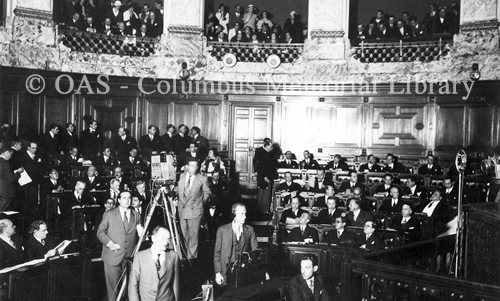
The Seventh International Conference was held in Montevideo, Uruguay from December 3rd - 26th 1933 and was attended by delegations from all the American states except Costa Rica (a provision was made for Costa Rica to later sign the conventions and treaties presented at the conference). Of the eight instruments signed at the conference, the Convention on the Rights and Duties of States was the most important as it was the first inter-American instrument to establish the principle of non-intervention in American international law. It was signed by twenty states and ratified by sixteen. *See General Information of the Treaty.
The Conference also opened for signature the Additional Protocol to the General Convention of Inter-American Conciliation of 1929. It was ratified or acceded to by ten states and entered into force on March 10th 1935.
Argentine Foreign Minister Carlos Saavedra proposed a resolution calling for those states, which had not yet done so (six states had already signed in Rio de Janeiro on October 10th 1933) to adhere to his Anti-War Treaty of Non-Aggression and Conciliation and several other peace instruments. The Anti-War Treaty called for the peaceful settlement of disputes, condemned aggression and stipulated that signatories could not recognize territorial arrangement brought about by force. The remaining thirteen republics as well as the United States signed the treaty. The conference also addressed the Chaco War being fought between Bolivia and Paraguay and through efforts of mediation managed to negotiate a temporary truce.
RELEVANT DOCUMENTS
- Convention on Rights and Duties of States English and Spanish
- General Information of the Treaty English
- Additional Protocol to the General Convention of Inter-American Conciliation, signed December 26, 1933 English | Español
- Saavedra Lamas Pact-Anti War Treaty of Non-Aggression and Conciliation English
|
1936 |
INTER-AMERICAN CONFERENCE FOR THE MAINTENANCE OF PEACE |
Buenos Aires, Argentina
December 23rd 1936
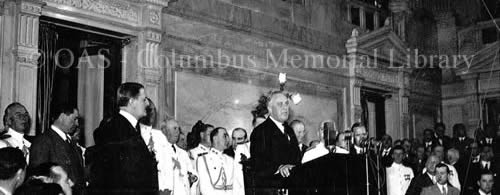
The Inter-American Conference for the Maintenance of Peace was held in Buenos Aires, on December 23rd 1936. Events occurring at the time, such as the Germany’s rearmament, Japan’s aggression in China and Italy’s invasion of Ethiopia had alarmed the American States and prompted them to hold a conference to reaffirm the American Republics’ commitment to non-intervention and their pledge to consult together in the event of any threat to the peace of the Americas.¹
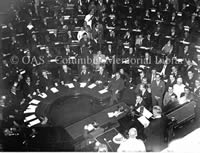 The Convention for Maintenance, Preservation and Re-establishment of Peace, “Consultative Pact”, inaugurated the procedure of consultation in case of threat to peace and led to the three Meetings of Consultation of Foreign Ministersthat took place during World War II (the first in 1939, the second in 1940 and the third in 1942). These principles were later incorporated into the OAS Charter of 1948. The Convention was ratified by seventeen countries and entered into force in 1937. The Convention for Maintenance, Preservation and Re-establishment of Peace, “Consultative Pact”, inaugurated the procedure of consultation in case of threat to peace and led to the three Meetings of Consultation of Foreign Ministersthat took place during World War II (the first in 1939, the second in 1940 and the third in 1942). These principles were later incorporated into the OAS Charter of 1948. The Convention was ratified by seventeen countries and entered into force in 1937.
The Additional Protocol Relative to Non-Intervention reiterated the principle of non-intervention, that no state had the right to intervene in the internal or external affairs of another, and declared that violation would lead to mutual consultation. The Protocol was ratified by sixteen countries and entered into force in 1937.
The Treaty on the Prevention of Controversies created mixed, bilateral commissions, which would serve as a preventative system, specifically to study and work to prevent any future controversies that might arise and to suggest lawful measures to promote the regular application of treaties, and good relations. These Commissions were to be composed of representatives of the signatory governments and would be constituted at the request of any of them. The meetings would be held, alternatively, in the capital city of one and the other Governments represented in each of them.
The Inter-American Treaty on Good Offices and Mediation outlined that Parties can turn to the good offices or the mediation of an eminent citizen of one of the American countries, who will be selected from a list which is composed of eminent citizens that American countries have elected.
The Convention to Coordinate, Extend and Assure the Fulfillment of the Existing Treaties Between the American States reaffirmed the obligation to settle all controversies of an international character by pacific means. It was ratified by fourteen countries and entered into force in 1938.
Also adopted was the Declaration of Principles of Inter-American Solidarity and Cooperation, which stated that any act capable of disturbing the peace of America, affects each of the countries and justifies the initiation of the process of consultation.
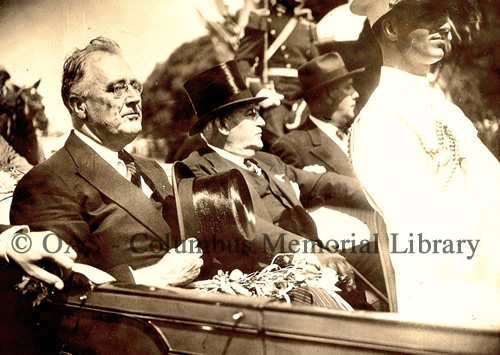
RELEVANT DOCUMENTS
- The Convention for Maintenance, Preservation and Re-establishment of Peace, “Consultative Pact” English | Español
- The Additional Protocol Relative to Non-Intervention English | Español
- Treaty on the Prevention of Controversies English | Español
- Inter-American Treaty on Good Offices and Mediation English | Español
- The Convention to Coordinate, Extend and assure the Fulfillment of the Existing Treaties Between the American States English | Español
- Declaration of Principles of Inter-American Solidarity and Cooperation English
¹G. Pope Atkins, Encyclopedia of the Inter-American System (Westport, Connecticut and London: Greenwood Press, 1997) 235-236.
|
1938 |
EIGHTH INTERNATIONAL CONFERENCE OF AMERICAN STATES |
Lima, Peru
December 9th - 27th 1938
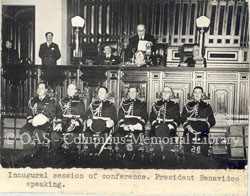 |
| Óscar Benavides, President of Peru, speaks at the inaugural session of the Eighth International conference of American States |
The Eighth International Conference of American States (ICAS) met in Lima, Peru from December 9th – 27th 1938. No treaties or conventions were adopted, only resolutions, the most important of which was the Declaration of the Principles of the Solidarity of America, commonly known as the “Declaration of Lima”. In light of world events and increasing fear of international conflict, the Declaration aimed to ensure the maintenance of the peace and solidarity of the region.¹
The signatories agreed to coordinate their response to foreign threats through the procedure of consultation, which had originated in 1936 at the Inter-American Conference for the Maintenance of Peace. To this end, the Eighth ICAS created the Meetings of Consultation of Ministers of Foreign Affairs. The Conference also adopted Resolution CVII, “Improvement in the Procedure of Consultation”, extending the scope of consultation to include any issue of common interest to the American states.²
I Meeting - Panama, Panama - September 23 - October 3, 1939
When hostilities broke out in Europe, it was suggested that that the situation might disrupt the peace of the Americas. (Pursuant to agreements adopted at the Inter-American Conference for the Consolidation of Peace (Buenos Aires, 1936) and the VIII International Conference of American States (Lima, 1938))
II Meeting - La Habana, Cuba - July 21 to 31, 1940
International repercussions of the war in Europe resulted in new problems for the American republics (European possessions in the Americas). Pursuant to agreements adopted at the Inter-American Conference for the Consolidation of Peace (Buenos Aires, 1936) and the
VIII International Conference of American States (Lima, 1938)
III Meeting - Rio de Janeiro, Brazil - January 15 to 28, 1942
Convened at the request of the Government of Chile, in connection with the Japanese attack on the United States on December 7, 1941.
IV Meeting - Washington, D.C., United States - March 26 to April 7, 1951
Risk of international communist aggression. resolution adopted by the OAS Permanent Council on December 20, 1950, after taking note of the note from the United States requesting convocation of the Meeting of Ministers of Foreign Affairs. Articles 30 and 40 of the OAS Charter (1948)
V Meeting - Santiago, Chile - August 12 to 18, 1959
Integral coordination of efforts to resolve the situation in the Caribbean area (draft resolution presented by Brazil, Chile, United States, and Peru, adopted by the Permanent Council on July 13, 1959). Article 39 and 40 of the OAS Charter (1948)
VI Meeting - San José, Costa Rica - August 16 to 21, 1960
To consider the interventionist and aggressive acts by the Government of the Dominican Republic against the Government of Venezuela, which led to an attempt on the life of the President of Venezuela. Convened at the request of Venezuela. resolution convening the Meeting of Consultation adopted by the Permanent Council on July 8, 1960. Article 6 of the Rio Treaty
VII Meeting - San José, Costa Rica - August 22 to 29, 1960
Requested by Peru to consider hemispheric partnership requirements and defense of the regional system and the democratic principles of the Americas against potential threats. resolution convening the Meeting of Consultation adopted by the Permanent Council on July 18, 1960. Articles 30 and 40 of the OAS Charter (1948)
VIII Meeting - Punta del Este, Uruguay - January 22 to 31, 1962
Convened at the request of Colombia to consider potential threats to the peace and political independence of the American states from intervention by powers outside the Hemisphere intended to fracture the solidarity of the Americas. resolution convening the Meeting of Consultation adopted by the Permanent Council at its meeting of December 4, 1961. Articles 6 and 11 of the Rio Treaty
IX Meeting - Washington, D.C., United States - July 21 to 26, 1964
Convened at the request of Venezuela to consider measures that should be taken to address the interventionist and aggressive acts by the Government of Cuba affecting the territorial integrity and sovereignty of Venezuela and the effectiveness of its democratic institutions. resolution convening the Meeting of Consultation adopted by the Permanent Council at its meeting of December 3, 1963. Article 6 of the Rio Treaty
X Meeting - Washington, D.C., United States - May 1, 1965 to March 6, 1970
Grave situation resulting from armed conflict in the Dominican Republic (convened at the request of Chile in a resolution adopted by the Permanent Council at its meeting of April 30, 1965). Articles 39 and 40 of the OAS Charter (1948)
XI Meeting - (First meeting) Washington, D.C., United States - January 24 to February 1, 1967; (Second meeting) Buenos Aires, Argentina - February 15 to 26, 1967; (Third meeting) Punta del Este, Uruguay - April 8 to 14, 1967)
To decide whether to hold a meeting of heads of state to strengthen the Alliance for Progress and to decide new measures for hemispheric cooperation to facilitate Latin American economic integration. resolution convening the Meeting of Consultation adopted by the Permanent Council at its meeting of September 19, 1966. Articles 39 and 40 of the OAS Charter (1948)
XII Meeting - Washington, D.C., United States - June 19 to September 24, 1967
OAS member states are faced with a grave situation resulting from the posture of the current Government of Cuba. Convened at the request of the Government of Venezuela in a resolution adopted by the Permanent Council at its meeting of June 5, 1967. Articles 39 and 40 of the OAS Charter (1948)
XIII Meeting - Washington, D.C., United States - June 26, 1969 to November 17, 1980
The Government of Honduras denounces the armed aggression of the military forces of the Government of El Salvador and the violation of Honduran air space. Articles 39, 40, and 43 of the OAS Charter (1948)
XIV Meeting - Washington, D.C., United States - January 30, 1971 (Remains open)
An urgent matter of common interest resulting from the use of coercive measures by the Government of the United States (Tuna problem) Article 59 of the OAS Charter
XV Meeting - Quito, Ecuador - November 8 to 12, 1974
Requested by Colombia, Costa Rica, and Venezuela to consider the altered circumstances of 1964 and to decide on the advisability of nullification of the provisions of resolution I of the Ninth Meeting of Consultation on application of measures to the current Government of Cuba. Application of the Rio Treaty
XVI Meeting - San José, Costa Rica - July 29, 1975
Requested by the delegations of Colombia, Costa Rica, Ecuador, Haiti, Mexico, Panama, Peru, Trinidad and Tobago, and Venezuela to examine the issue of the freedom of the States Parties to the Rio Treaty to take steps to normalize or conduct relations with the Republic of Cuba at the level and in the manner deemed appropriate by each state. Application of the Rio Treaty
XVII Meeting - Washington, D.C., United States - September 21, 1978 to December 14, 1992
Requested by Venezuela, consideration was given to the events occurring on the Costa Rica/Nicaragua border at special meetings of the Permanent Council held on September 7, 12, 15, and 18, 1978. At the last of these meetings, resolution CP/RES. 251 (342/78) was adopted, convening the XVII Meeting of Consultation of Ministers of Foreign Affairs. Article 59 of the OAS Charter
XVIII Meeting - Washington, D.C., United States - December 30, 1978
The Permanent Council served as Organ of Consultation in connection with complaints made by Costa Rica regarding Nicaragua, which were presented at a special meeting held on November 22, 1978. Article 6 of the Rio Treaty
XIX Meeting - Washington, D.C., United States - February 2 to 4, 1981
Consideration of the Ecuador/Peru border conflict. Articles 59 and 60 of the OAS Charter
XX Meeting - Washington, D.C., United States - April 26, 1982 (Remains open)
Requested by Argentina, in connection with the grave situation in the South Atlantic (Malvinas Islands). Article 6 of the Rio Treaty
XXI Meeting - Washington, D.C., United States - May 17, 1989 to December 14, 1992
Requested by Venezuela to consider the grave crisis in Panama in its international context. Documents for the first to the seventh plenary sessions are available only in Spanish. First part of Article 60 of the Charter
XXII Meeting - Washington, D.C., United States - January 9, 1992 (Did not meet)
Requested by Venezuela, to consider measures that should be taken to address the threat to the region’s democratic institutions from the resurgence of militaristic tendencies in the Hemisphere. First part of Article 60 of the Charter
XXIII Meeting - Washington, D.C., United States - September 19, 2001
In connection with the terrorist acts perpetrated within the territory of the United States on September 11, 2001. Articles 61 to 65 of the OAS Charter
XXIV Meeting - Washington, D.C., United States - September 19, 2001
Convened to agree on measures that should be taken for the common defense and for the maintenance of peace and security in the Hemisphere. Articles 11 and 12 of the Rio Treaty
XXV Meeting - Washington, D.C., United States - March 17, 2008
Convened by the Permanent Council taking into consideration that on the morning of Saturday, March 1, 2008, military forces and police personnel of Colombia entered the territory of Ecuador, in the province of Sucumbíos, without the express consent of the government of Ecuador to carry out an operation against members of an irregular group of the Revolutionary Armed Forces of Colombia who were clandestinely encamped on the Ecuadorian side of the border;
XXVI Meeting – Washington, D.C., United States - December 7, 2010
On December 7, 2010, at the Meeting of Consultation of Ministers of Foreign Affairs of the Organization of American States (OAS), the delegations of the Member States approved Resolution RC.26/RES. 1/10 on the situation between Costa Rica and Nicaragua with 24 votes in favor, two votes against and five abstentions, whereby they called upon the parties to implement, simultaneously and without delay, the recommendations adopted through resolution CP/RES. 978 (1777/10), “Situation in the Border Area between Costa Rica and Nicaragua,” of November 12, 2010.
RELEVANT DOCUMENTS
- Declaration of Principles of the Solidarity of America, known as the “Declaration of Lima”. English | Español
- Perfection and Coordination of inter-American Peace Instruments. English
- Resolution IV Settlement Chaco Controversy English
- Resolution XV Perfection and Coordination of Inter-American Peace Instruments English
- Resolution XVI Defense of Human Rights English
- Resolution XX Lima Declaration in Favor of Women’s Rights English
- Resolution XXV Inter-American Court of International Justice English
- CX Declaration of American Principles English | Español
¹ G. Pope Atkins Encyclopedia of the Inter-American System (Westport, Connecticut and London: Greenwood Press, 1997) 289.
² Ibid, 322.
|
1939 |
FIRST MEETING OF CONSULTATION OF MINISTERS OF FOREIGN AFFAIRS |
Panama City, Panama
September 23rd - October 3rd 1939

Officially titled “First Meeting of the Ministers of Foreign Affairs of the American Republics for Consultation Under the Inter-American Agreements of Buenos Aires and Lima”, the first Meeting of Consultation of Ministers of Foreign Affairs took place in Panama from September 23rd - October 3rd 1939. The meeting focused on questions of neutrality and passed two resolutions, the General Declaration of Neutrality of the American Republics and the Declaration of Panama. The Ministers declared inter-American neutrality and created measures of “continental self-protection”, setting aside a neutrality zone that extended to waters on both sides of the hemisphere. Any hostile acts committed in this zone by a non-American state would warrant a collective inter-American response. The Declaration also created an inter-American Neutrality Committee, composed of seven international lawyers, to be based in Rio de Janeiro.
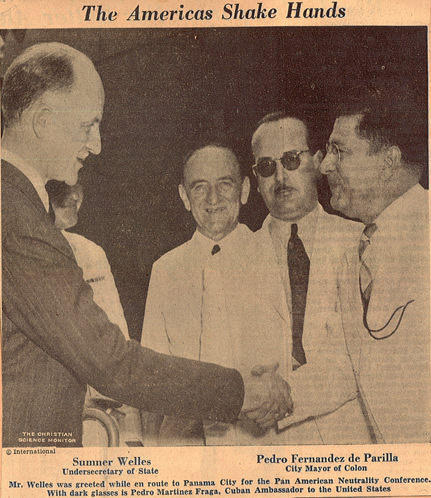
RELEVANT DOCUMENTS
- General Declaration of Neutrality of the American Republics. English
- Declaration of Panama. English
SPEECHES
- Opening address by Sumner Welles, Under Secretary of State, United States English
News Clippings:
- New York Times, September 6th 1939 English
- New York Times, September 24th 1939 English
- New York Herald Tribune, October 3rd 1939 English
- New York Herald Tribune, September 27th 1939 English
- Christian Science Monitor, September 23rd 1939 English
- Christian Science Monitor, September 23rd 1939 #2 English
- New York Times, October 4th 1939 English
- New York Herald Tribune, September 6th 1939 English
- Washington Post, October 1st 1939 English
- New York Times, September 8th 1939 English
|
1940 |
SECOND MEETING OF CONSULTATION OF MINISTERS OF FOREIGN AFFAIRS |
Havana, Cuba
July 30th 1940

The Second Meeting of Consultation of Ministers of Foreign Affairs took place in Havana, July 21st - 30th 1940. The meeting dealt principally with American solidarity against acts of aggression, reciprocal assistance and cooperation for defense, and the procedure of consultation. To this end, the meeting passed three resolutions.
The first resolution was entitled the “Act of Havana Concerning the Provisional Administration of European Colonies and Possessions in the Americas” and declared that if islands or regions in the hemisphere, then under the possession of a non-American power, risked becoming subject of barter or a dispute for change of sovereignty, the American states could take up provisional administration of them. The aim was to protect hemispheric security and the lives of the inhabitants of the territories in question. The second resolution was the Reciprocal Assistance and Cooperation for Defense of the Nations of the Americas, called: “Declaration of Havana” which extended the principle of solidarity to cover any act of aggression or attempt by a non-American state to threaten the sovereignty and political independence of an American state. The third resolution, Reciprocal Assistance and Cooperation for the Defense of the Americas, affirmed that an attack on an American nation would be considered an attack on all the Americas and would require consultation on a cooperative defense strategy. On the issue of the peaceful resolution of conflicts, the meeting passed Resolution XIV, entitled: “Peaceful Solution of Conflicts”, which authorized the creation of a committee to keep vigilance and work to resolve any dispute arising between American states that could threaten regional peace and security. This committee was later named the Inter-American Peace Committee and activated in 1948.¹
RELEVANT DOCUMENTS
- Act of Havana concerning the Provisional Administration of European Colonies and Possessions in the Americas English
- Reciprocal Assistance and Cooperation for Defense of the Nations of the Americas, called: “Declaration of Havana” English
- Resolution XIV – Peaceful Solution of Conflicts English
NEWS CLIPPINGS
- Washington Post, July 29th 1940 Page 1 | Page 2
- Washington Post July 29th 1940 (Cartoon) English
- Washington Post, August 2nd 1940 English
¹ G. Pope Atkins Encyclopedia of the Inter-American System (Westport, Connecticut and London: Greenwood Press, 1997) 326.
|
1940 |
INTER-AMERICAN PEACE COMMITTEE |
|
 The Second Meeting of Ministers of Foreign Affairs adopted Resolution XIV on “The Peaceful Solution of Conflicts,” recommending to the Governing Board of the Pan American Union that it organize a committee entitled “The Inter-American Committee on Methods for the Peaceful Solution of Conflicts” tasked with “keeping constant vigilance to ensure that States between which any dispute exists or may arise, of any nature whatsoever, may solve it as quickly as possible”. It was a permanent, autonomous organ of the Inter-American system, composed of five member states elected by the Pan American Union Council for five-year periods. On December 4th 1940, the Governing Board of the Pan American Union established Washington DC as the seat of the Committee and selected as its members two countries of the north (the United States and Mexico), two of the south (Argentina and Brazil), and one of Central America and the Antilles (Cuba).The Committee was to report on situations and its actions to each Meeting of Consultation of Ministers of Foreign Affairs. It was installed on January 31st 1948. The Second Meeting of Ministers of Foreign Affairs adopted Resolution XIV on “The Peaceful Solution of Conflicts,” recommending to the Governing Board of the Pan American Union that it organize a committee entitled “The Inter-American Committee on Methods for the Peaceful Solution of Conflicts” tasked with “keeping constant vigilance to ensure that States between which any dispute exists or may arise, of any nature whatsoever, may solve it as quickly as possible”. It was a permanent, autonomous organ of the Inter-American system, composed of five member states elected by the Pan American Union Council for five-year periods. On December 4th 1940, the Governing Board of the Pan American Union established Washington DC as the seat of the Committee and selected as its members two countries of the north (the United States and Mexico), two of the south (Argentina and Brazil), and one of Central America and the Antilles (Cuba).The Committee was to report on situations and its actions to each Meeting of Consultation of Ministers of Foreign Affairs. It was installed on January 31st 1948.
On May 24th 1950 the Committee approved the Statutes that it had prepared and which would govern its activities until May 9th 1956, when the Council of the Organization approved new Statutes. It is significant to underscore the impact of the new Statutes on the Committee’s authority. The Statutes of 1950 stipulated that the Committee could take action at the request of any American State when all diplomatic channels had been exhausted. Moreover, when “directly interested” parties presented the case, the consent of the other party was not required in order for the Committee to take action. In contrast, the new Statutes (1956) significantly restricted the Committee’s role by stating that only a state directly concerned in the dispute or controversy could request the Committee to take action and, also, that the Committee could only take up a case with the prior consent of all parties involved. These changes reduced the Committee’s competence and the efficiency of operations. Therefore, at the Fifth Meeting of Consultation in 1959, Resolution IV authorized the Committee to act at the request of governments or on its own initiative. The IAPC made numerous investigations, presented reports to the OAS Council, and on occasion, acted as the third party in established conflict resolution procedures.¹
The IAPC undertook 16 cases:
1) Cuba-Dominican Republic Situation (1948) - On August 13, 1948 the Dominican Republic requested the services of the IAPC to help find a solution to the situation between it and the Government of Cuba. The Dominican Republic accused Cuba of assisting Dominican exiles to organize a revolutionary force against Dominican dictator Rafael Trujillo. The IAPC led an investigation and held several meetings with the representatives of the parties. The IAPC report strongly criticized Cuban action and recommended direct negotiations between the disputants. This was outlined in the document signed on September 9, 1948 by the representatives of the parties and the members of the Committee.
2) Dominican Republic-Haiti Conflict (1949-1950) - On March 24, 1949, the IAPC met to address a request by the Government of Haiti relative to a dispute between it and the Government of the Dominican Republic caused by the activities of Haitian exiles from the Dominican Republic. After the IAPC informed the Dominican government of the request and held several meetings with the disputants, it decided to send a delegation to visit both countries. On returning to Washington, the Committee presented the text of a joint declaration that had been approved by both parties. On June 9, an act was signed by representatives of both parties and members of the Committee in which both governments declared that they would not tolerate any activities directed at disturbing the peace of either of the republics, and that in the future they would have recourse to direct negotiation and, when necessary, to the procedures of pacific settlement.
3) Caribbean Situation (1949) - On August 3, 1949, the Committee met at the request of the representative of the United States to consider the general political situation in the Caribbean. The Caribbean situation had its roots in the conflicts that began in 1948 involving the Dominican Republic, Haiti, Cuba and Guatemala and their disaffected revolutionary exiles. The IAPC addressed a note to the Council of the Organization to inform of the situation and request their respective governments for information and suggestions. In response, the Governments of the United States, Venezuela, Costa Rica, Cuba, the Dominican Republic, Nicaragua, Guatemala and Haiti sent the Committee observations and information. The Committee prepared a set of conclusions that were sent to the United Nations Security Council and approved on September 14, 1949. The IAPC’s conclusions received the express support of the OAS Council, acting provisionally as Organ of Consultation. On April 8, 1950, it declared that it supported the conclusions with the understanding that they were applicable not only in the situation in the Caribbean region but also to all the American states without exception.
4) Cuba-Dominican Republic Situation (1949) - News reports emanating from official agencies in the Dominican Republic, alleged that preparations to launch an attack against the Dominican regime were being made on Cuban territory. On December 6, 1949, the Cuban representative sent a note to the Chairman of the Committee, inviting the Committee to visit the country to see for itself that there were no such movements taking place. After weighing all the factors, the Committee decided not to visit Cuba. In the same month, the Committee expressed serious concern with respect to the granting of special powers for the declaration of war, requested by the President of the Dominican Republic and later authorized by the country’s congress. The Committee voiced its concern to the Dominican Government.
5) Cuba-Dominican Republic Situation (1951) - On November 26, 1951, the Government of Cuba again requested the services of the Committee to help solve the situation that had arisen between it and the Government of the Dominican Republic in connection with the seizure by Dominican authorities of five Cuban sailors. The Committee informed the Dominican Republic which in turn, requested the services of the Committee for assistance in resolving the controversy referred to in the minutes of the Committee’s meeting on September 9, 1948 and Resolution II.4, approved by the Council of the Organization acting provisionally as Organ of Consultation on April 8, 1950. After holding several meetings, the Committee ended its activities in this case on December 25, 1951, when the parties signed the Declaration that appears in the minutes of that meeting.
6) Colombia-Peru Situation (1953-1954) On November 18, 1953, the Committee’s services were requested by the Government of Colombia to find a solution to the dispute between it and the Government of Peru, which had arisen as a consequence of the asylum granted to Mr. Victor Raul Haya de la Torre in the Colombian embassy in Lima. The Committee informed the Peruvian Government and offered its services, which Peru declined. The Committee made a study of the case and approved some conclusions which it submitted to the parties. In its conclusions, the IAPC suggested bilateral negotiations and that the disputants inform the Committee of the results of the procedure.
7) Guatemala Situation (1954) - On June 19, 1954 Guatemala delivered a note to the Chairman of the Committee. The note appealed to the Committee to convoke on an emergency basis so that it could take the necessary measures to resolve the controversy and avert escalation of the dispute. The note cited events that had occurred which, in the opinion of the Guatemalan government constituted acts of aggression against Guatemala by Honduras and Nicaragua. The Committee met on June 19 and transmitted a copy of the Guatemalan note to the Representatives of Honduras and Nicaragua. Guatemala asked the IAPC to visit Guatemala and investigate. The IAPC organized a subcommittee to be sent to Guatemala on the next day, June 20. However, Guatemala then suspended its request, since it had simultaneously submitted its complaint to the UN Security Council, and the Security Council had acknowledged the request. On June 21, the IAPC dropped its consideration of the situation but on June 22, Honduras and Nicaragua asked the Committee to continue its action in order to clear up the Guatemalan accusations. The Committee met again on June 23 and created a subcommittee of confrontation, to visit the three countries and obtain all information possible to investigate the situation. While the subcommittee was on its way to Guatemala, Colonel Carlos Castillo Armas took over the government and sent Jacobo Arbenz Guzman, then President of Guatemala, into exile. Due to these changes, the new government asked the subcommittee to abort their trip. On June 30th, and with the approval of the three countries, the Committee issued a press release saying that the three countries considered the controversy to be over.
8) Cuba-Dominican Republic Situation (1956) - On February 27, 1956, Cuba requested the services of the IAPC to investigate what it charged were threatening activities being carried out by the Dominican Republic against the Government of Cuba and interference in its internal affairs. The Committee informed the Dominican Republic of this request and on March 7, the Dominican Republic representative replied that there was no such conflict and that the Cuban Government had not exhausted the resources of diplomatic channels in order to clear up the situation between itself and the Dominican Government. After deliberations with representatives of both disputants, the Committee met on April 20 and approved a declaration which stated that, after considering all the facts and within the spirit of Article 7 of the Statutes, the Committee hoped that the two countries could take advantage of their diplomatic channels to resolve the matter.
9) Cuba-Haiti Situation (1959) - On August 15, 1959, at the Fifth Meeting of Consultation of Ministers of Foreign Affairs, Haiti lodged a complaint that Cuba had invaded two days before. On August 19, Haiti added that the invading forces had sailed from a Cuban port and that Cuban authorities said they had been unable to stop their departure. Haiti requested that the IAPC investigate the events. The Committee sent a subcommittee to visit Haiti in October 1959. While Haiti did not formally accuse Cuba, it expressed serious concern that Cuba had not taken the necessary measures to stop the departure and mentioned what it considered to be inappropriate acts of intervention by Cuban diplomats in the past. During its visit to Haiti, the subcommittee interviewed five prisoners of Cuban nationality, sole survivors of the invasion force, who stated that they had sailed from the Cuban port but did not know their destination. At the Seventh Meeting of Consultation a year later, the Committee pointed out that although Haiti had expressed serious concern over the possibility of a similar invasion, this had not happened, in great part because of the failure of the 1959 invasion and due to the interest shown by the OAS in the Haitian appeal.
10) Dominican Republic-Venezuela Situation (1959-1960) - On November 25, 1959, the Venezuelan representative to the OAS requested the services of the IAPC to investigate an event that occurred on the night of November 19, 1959. A United States registered aircraft, piloted by two Cuban citizens, had mistakenly dropped leaflets over the Island of Curacao, inciting the army of Venezuela to rebel against the legally constituted authorities of that country. The leaflets were supposed to be dropped over a Venezuelan city. After completing the operation, the aircraft made a forced landing on the island of Aruba where they were arrested by the Dutch authorities. The plane had departed from Miami, stopping in Nassau and Ciudad Trujillo (now Santo Domingo). The IAPC investigated and prepared a report in which it confirmed the facts and concluded that the flight from Ciudad Trujillo, as well as the loading of the leaflets in Ciudad Trujillo, could not have been carried out without the collusion of the Dominican authorities. On February 16, 1960, Venezuela again requested the IAPC to investigate what it charged were the “flagrant violations of human rights by the Government of the Dominican Republic”. The Trujillo regime refused the IAPC’s request to visit the Dominican Republic with the aim of investigating the charges. The Committee decided that it had gathered enough information, and on June 6 it transmitted a report to the OAS Council. In it, the Committee concluded that the Dominican Republic was committing flagrant human rights violations and in so doing, further aggravating the international tensions in the Caribbean region.
11) Caribbean Situation (1959-1960) - The Fifth Meeting of Consultation was convoked under the Charter of the Organization of American States to seek solutions to the increasing tensions and extensive revolutionary activities in the Caribbean region. In June 1959, the Dominican Republic charged that invading forces destined for the Dominican Republic had been organized on Cuban territory with the help of Venezuela. Haiti and Ecuador proposed a Meeting of Consultation to address the matter. Brazil, Chile, Peru and the United States were worried about the series of conflicts of which the Dominican claim was a part and proposed a meeting to address the deteriorating situation in the Caribbean region. The Fifth Meeting of Consultation worked to find a balance between the inter-American commitment to non-intervention and the promotion of democratic progress and social change. The Fifth Meeting adopted Resolution IV which conferred new powers and functions on the Inter-American Peace Committee. The IAPC was directed to study three questions: Methods to prevent external activities to overthrow established governments without compromising the rights and liberties of political exiles; the relationship between the human rights violations or non-exercise of representative democracy and the political tensions that affect the peace of the hemisphere; and the relationship between economic under-development and political instability. Resolution IV authorized the IAPC to act at the request of governments or on its own initiative.
12) Dominican Republic-Ecuador Situation (1960) - On February 24, 1960, Ecuador requested the urgent action of the IAPC to help resolve the situation which had arisen between Ecuador and the Dominican Republic. Ecuador charged that the Dominican Republic had refused to grant the Ecuadorian Embassy in Ciudad Trujillo the facilities it required and of “carrying out repudiable acts to impede the performance of those duties”. Ecuador had granted political asylum to a number of Dominican citizens. On March 8, after two weeks of talks with the IAPC, the Dominican Republic agreed to accept the Committee’s services regarding the embassy but not the asylees, citing the fact that it had previously renounced the conventions on political asylum. The IAPC countered that the two issues could not be separated. The Dominican Republic called for direct negotiation between the two sides, rather than third party mediation. Ecuador disagreed since direct negotiations with the Dominican Republic had failed thus far and instead urged the IAPC to act to settle the dispute. On March 30, the IAPC presented the two parties with a plan under which the asylees could leave the Ecuadorean embassy and exit the Dominican Republic and talks would begin to resolve the embassy’s situation. The Dominican Republic rejected the plan and the IAPC took no further action.
13) Honduras-Nicaragua situation (1961-1962) - The conflict stemmed from a continuing boundary dispute between Honduras and Nicaragua that had its origins in an award of a remote area by the King of Spain on December 23, 1906, which corresponded to Honduras’s claim. Nicaragua refused to accept the decision. When Honduras concluded that oil was found in the area, Nicaragua sent troops to the area, which clashed with the Honduran units. Each accused the other of violating its territory. In 1957, at the request of both states, the Council of the Organization of American States constituted itself to act provisionally as the Organ of Consultation under the Inter-American Treaty of Reciprocal Assistance (Rio Treaty) and appointed an investigating committee which immediately went to the area. After negotiating a ceasefire, the committee put into effect a troop withdrawal plan. The Council recommended that the two governments maintain the troop withdrawal plan until the legal dispute could be resolved. In addition, the Council would form an ad hoc committee to help broker an agreement on the judicial procedures to be taken. If the parties chose not to have recourse to the American Treaty on Pacific Settlement or the Inter-American Peace Treaty, then they would have to go before the International Court of Justice (ICJ). The parties chose to bring their case before the ICJ and agreed that the Court’s decision would be final and binding without right of appeal. The disputants signed the agreement on July 21, 1957. The parties brought their case before the ICJ which determined that the King’s award was binding and that Nicaragua was under obligation to comply with it. On February 16, 1961, Nicaragua requested the services of the Inter-American Peace Committee to provide third party good offices to help resolve any questions about executing the ICJ’s ruling. Honduras agreed to IAPC involvement. In early March, the Committee presented a plan which both parties accepted. It provided that Nicaragua immediately withdraw from the territory and for the creation of a Honduras-Nicaragua Mixed Commission to deal with Nicaraguan settlers in the area and to demarcate the border in question. In March 1961, the IAPC visited both countries, met with the Presidents and installed the Mixed Commission. In January 1962, the IAPC reported to the Eighth Meeting of Consultation of Ministers of Foreign Affairs. The report confirmed that the transfer of all people who wished to go to Nicaragua had been completed and the Commission had fixed the territorial boundaries and declared the dispute settled.
14) Guatemala-Mexico Situation (1961) - On July 21, 1961, the Representative to the OAS Council addressed a note to the Chairman of the IAPC, in which he transcribed a note received from the Minister of Foreign Affairs of Mexico, in which he made reference to a message which the Minister of Foreign Affairs of Guatemala had addressed to the Secretary General of the OAS, informing him that Communist troops located in Mexican territory adjacent to the Guatemalan border, were being trained for an invasion into Guatemalan territory. The Government of Guatemala was worried about impending disorders that might occur and cause it to invoke the Inter-American Treaty of Reciprocal Assistance. The Mexican Foreign Minister requested the services of the IAPC to act immediately and visit the Mexican territory to investigate. The Committee met to hear Mexico’s request and decided to take action on the matter pursuant to Resolution IV. The Committee informed the Representative of Guatemala of this decision and requested any information necessary to carry out the investigation. The Guatemalan representative replied that his government’s position with regards to this said matter had been clearly established in the special meeting of the Council and therefore, there was no need to report any specifics. In the Eighth Meeting of Consultation, the Committee stated that given the positions of the Government of Guatemala and the declarations of the Representative of Mexico, there was no need for the Committee to visit the Mexican territory and make the investigation.
15) Cuba-Peru Situation (1961-1962) - On October 16, 1961, at a special meeting of the OAS Council, Peru made charges against Cuba and requested that the Inter-American Treaty of Reciprocal Assistance (Rio Treaty) be invoked. Peru accused Cuba of committing executions, imprisonment, deportations and other grave violations against its own citizens and foreigners. It also charged that Cuba was serving as an agent of international communism in other American states and that it was using its diplomatic officers and official missions to provoke subversion and revolution against legitimately constituted governments and institutions. The Council decided that the IAPC should deal with the matter. The IAPC invited Cuba to present its case but Cuba refused. The IAPC asked Cuba if it would allow the Committee to visit Cuba and investigate the charges; Cuba declined. Further charges were brought against Cuba. Colombia requested the convocation of a Meeting of Consultation, with strong support from the United States. The Eighth Meeting of Consultation of Ministers of Foreign Affairs met at Punta del Este, Uruguay in January 1962, where the IAPC presented its report to the foreign ministers.
16) Panama-United States situation (1964) - On January 10, 1964, the representatives of Panama and the United States simultaneously requested the services of the IAPC to address the “flag riots” controversy that had arisen between the two countries when US high school students in the Canal Zone refused to allow the flying of the Panamanian flag, which had been agreed to by the two governments. The clashes led to fatalities, sniping and the destruction of property. Panama accused the United States of an unprovoked attack on its sovereignty and severed its diplomatic ties with the United States. Panama called a meeting of the Organ of Consultation under the Inter-American Treaty of Reciprocal Assistance (Rio Treaty) and requested a meeting of the UN Security Council. The IAPC left for Panama and stayed there until January 15. Panama held off its request for invoking the Rio Treaty to give the IAPC a chance to find a solution. The UN Security Council also deferred action and negotiated the appointment of a Mixed Committee on Cooperation, composed of one member of the IAPC as chair and one civilian and one military representative of each of the parties. The Mixed Committee negotiated a solution to the problems of the simultaneous raining of the flags of Panama and the United States in the Canal Zone and of the free transit of people and vehicles. There was disagreement regarding the canal. Panama wanted negotiations while the United States wanted discussions but would not commit to negotiation. These discussions were held until January 29 with no positive results and on that date the Representative of Panama informed the Committee that he would bring the matter to the OAS Security Council and invoke the Rio Treaty. As a result, the IAPC considered its action terminated and on January 30 issued a press release to that effect.
*Its assistance was requested in the 1949 Cuba-Peru situation, but it took no action.
RELEVANT DOCUMENTS
REPORTS
- Report of the Inter-American Peace Committee on the Controversy Between Guatemala, Honduras, and Nicaragua English
- Report of the Inter-American Peace Committee on the Request of Costa Rica, December 6th 1968 Español
- Report of the Inter-American Peace Committee on the Amendment of Its Statutes, submitted to the Second Special Inter-American Conference March 31st 1965 English
- Report of the Inter-American Peace Committee on the Termination of the Activities of the Honduras-Nicaragua Mixed Claims Commission July 16th 1963 English | Español
- Special Report of the Inter-American Peace Committee on the Relationship of Human Rights or the Non-Exercise of Representative Democracy and the Political Tensions that Affect the Peace of the Hemisphere April 14th 1960 English
- Report of the Inter-American Peace Committee on the Case Presented by the Government of Ecuador April 12th 1960 English
- Report of the Inter-American Peace Committee to the Fifth Meeting of Consultation August 6th 1959 English | Español
- Report of the Inter-American Peace Committee on the Case Presented by the Government of Venezuela June 7th 1960 English
- Report of the Inter-American Peace Committee to the Seventh Meeting of Consultation of Ministers of Foreign Affairs English
- Memo September 18th 1959 English
PRESS RELEASES
- October 5th 1959 Committee will visit Haiti English
- May 4th 1960 meeting req by Venezuela sp. English
- March 24th 1961 Honduras Nicaragua dispute. English
- October 20th 1961 IAPC visits Dominican Republic sp. English
- November 9th 1961 Dom Rep oppositionists eng. English
- October 10th 1963 Continental Situation sp. English
- September 22th 1964 Chairmanship of IAPC eng. English
- April 19th 1965 Strengthening of IAPC sp. English
- April 22nd 1966 sp..pdf English
- May 31st 1966 Proposal for withdrawl from DR sp. English
REPORTS
- Original doc sp. English
- Report by IAPC Costa Rica December 6th 1968. English
¹ The Inter-American System: Its Development and Strengthening (Dobbs Ferry, New York: Oceana Publications, Inc., 1966), 83.
|
1942 |
THIRD MEETING OF CONSULTATION OF MINISTERS OF FOREIGN AFFAIRS |
Rio de Janeiro, Brazil
January 15th - 28th 1942

The Third Meeting of Consultation of Ministers of Foreign Affairs was held in Rio de Janeiro from January 15th - 28th 1942 to deal with the Japanese Attack on Pearl Harbor. Several resolutions were adopted on the basis of the principle of solidarity. Resolution I recommended the breaking of relations with Japan, Germany and Italy, and Resolution V recommended the immediate severance of all commercial and financial ties with the signatories of the Tripartite Pact and the territories under their control. Resolution XXIV condemned Japanese aggression.
An Emergency Advisory Committee for Political Defense was established to study, investigate and coordinate measures to counter Axis subversive activities. In addition, the Ministers passed a resolution creating the Inter-American Defense Board to be composed of military and naval officers from all member states to study problems of hemispheric defense and make recommendations on measures to resolve them.¹ The meeting also addressed the Ecuador-Peru border conflict and persuaded Ecuador and Peru to sign the Protocol of Peace, Friendship and Boundaries (Rio Protocol) on January 29th 1942. The agreement was guaranteed by Argentina, Brazil, Chile and the United States.²
RELEVANT DOCUMENTS
¹ G. Pope Atkins Encyclopedia of the Inter-American System (Newport, Connecticut and London: Greenwood Press, 1997), 327.
² Ibid, 164-165.
|
1945 |
INTER-AMERICAN CONFERENCE ON PROBLEMS OF WAR AND PEACE |
Mexico City, Mexico
February 21th - March 8th 1945
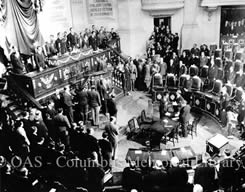 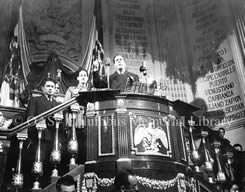
The Inter-American Conference on Problems of War and Peace, also known as the Chapultepec Conference, was held in Mexico City from February 21st - March 8th 1945 to strengthen hemispheric cooperation in the face of World War II. Fearful of interventionism, Latin American nations sought to solidify the previous regional agreements. The Conference recommended the construction of a regional body that could deal with matters relating to peace and security and the social and economic difficulties of Latin America both during and after the transition from war to peace. All of the countries were represented except for the Republic of Argentina. This conference was not one of the regular series of Inter-American Conferences, but rather an extraordinary meeting.¹
The conference adopted two important resolutions. Resolution VIII, “Reciprocal Assistance and American Solidarity”, commonly known as the Act of Chapultepec, which extended the procedure of consultation and referred specifically to mutual security; and Resolution IX, “Reorganization, Consolidation and Strengthening of the Inter-American System”, which drafted a treaty of reciprocal security assistance; an organizational charter to serve as a basic constitution of the regional system; and an agreement on the pacific settlement of disputes.² In addition, the Declaration of Mexico reaffirmed certain inter-American principles and rules of the inter-American peace system.
RELEVANT DOCUMENTS
- Resolution VIII “Reciprocal Assistance and American Solidarity” named Act of Chapultepec. Download: English | Español
- Resolution IX “Reorganization, Consolidation and Strengthening of the Inter-American System”. Download: English | Español
- Resolution XI Declaration of Mexico. Download: English | Español
¹ The Inter-American System: Its Development and Strengthening (Dobbs Ferry, New York: Oceana Publications, Inc., 1966) xxix.
² G. Pope Atkins, Encyclopedia of the Inter-American System (Westport, Connecticut and London: Greenwood Press, 1997) 237-238.
|
1947 |
INTER-AMERICAN CONFERENCE FOR THE MAINTENANCE OF CONTINENTAL PEACE AND SECURITY |
Rio de Janeiro, Brazil
August 15th - September 2nd 1947
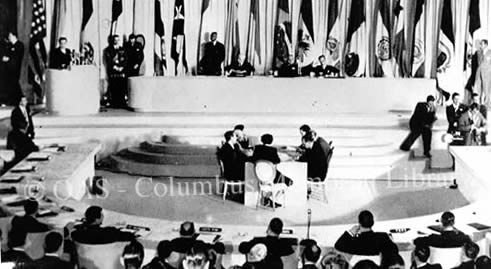
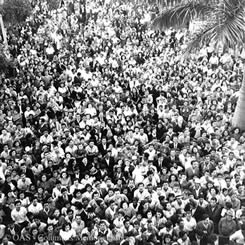 The Inter-American Conference for the Maintenance of Continental Peace and Security was held in Quitandinha, Brazil from August 15th to September 2nd 1947 and in Rio de Janeiro on the closing day. The Conference formulated and approved the Inter-American Treaty of Reciprocal Assistance, often referred to as the Rio Treaty or Rio Pact, which obligated all American states to come to the assistance of any American state subjected to armed attack. In addition, it required the states to consult and act together in cases of actual or threatened aggression, pending action by the Security Council of the United Nations. It was the formalization of the Act of Chapultepec, adopted at the Inter-American Conference on Problems of War and Peace in 1945. The Rio Treaty went into effect on December 3rd 1948 and was the basic instrument regulating mutual security and conflict resolution in the Inter-American system.¹ The Inter-American Conference for the Maintenance of Continental Peace and Security was held in Quitandinha, Brazil from August 15th to September 2nd 1947 and in Rio de Janeiro on the closing day. The Conference formulated and approved the Inter-American Treaty of Reciprocal Assistance, often referred to as the Rio Treaty or Rio Pact, which obligated all American states to come to the assistance of any American state subjected to armed attack. In addition, it required the states to consult and act together in cases of actual or threatened aggression, pending action by the Security Council of the United Nations. It was the formalization of the Act of Chapultepec, adopted at the Inter-American Conference on Problems of War and Peace in 1945. The Rio Treaty went into effect on December 3rd 1948 and was the basic instrument regulating mutual security and conflict resolution in the Inter-American system.¹
Between 1948 and 1982, twenty-three cases were considered under the provisions of the Rio Treaty. In nine of these cases, a Meeting of Consultation of Ministers of Foreign Affairs was called. In the remainder of the cases, the Council of the OAS, acting provisionally as Organ of Consultation, handled the matters without calling a Foreign Affairs Ministers meeting. The twenty-three cases are the following:
1) Costa Rica-Nicaragua Conflict 1948-1949, by the Council
2) Dominican Republic-Haiti Conflict 1949-1950, by the Council
3) Dominican Republic Conflict with Haiti, Cuba, and Guatemala, 1950, by the Council
4) Guatemala Situation, 1954, by the Council
5) Costa Rica-Nicaragua Conflict, 1955, by the Council
6) Ecuador-Peru Conflict, 1955, by the Council
7) Honduras-Nicaragua Conflict, 1957, by the Council
8) Panama Situation, 1959, by the Council
9) Nicaragua Situation, 1959, by the Council
10) General Situation in the Caribbean, 1959, by the Fifth Meeting of Consultation
11) Dominican Republic-Venezuela Conflict, 1959-1962, by the Sixth Meeting of Consultation
12) Cuban Situation, 1961, by the Council
13) Cuban Situation, 1961-1962, by the Eighth Meeting of Consultation
14) Bolivia-Chile Conflict, 1962, by the Council
15) Cuban Missile Crisis, 1962, by the Council
16) Dominican Republic-Haiti Conflict, 1963-1965, by the Council
17) Cuban Situation, 1964, by the Ninth Meeting of Consultation
18) Panama-United States Situation, 1964, by the Council
19) El Salvador-Honduras War, 1969, 1977-1980, by the Thirteenth Meeting of Consultation
20) Cuban Situation, 1974, by the Fifteenth Meeting of Consultation
21) Cuban Situation, 1975, by the Sixteenth Meeting of Consultation
22) Costa Rica-Nicaragua Conflict, 1978-1979, by the Eighteenth Meeting of Consultation
23) Argentina-United Kingdom War, 1982, by the Twentieth Meeting of Consultation
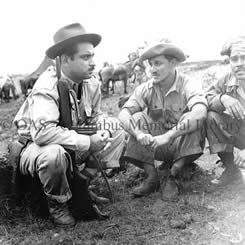 
“An armed attack by any State against an American State shall be considered as an attack against all the American States and, consequently, each one of the said Contracting Parties undertakes to assist in meeting the attack in the exercise of the inherent right of individual or collective self-defense.” (Inter-American Treaty of Reciprocal Assistance, Article 3)
Signatories must agree by a two-thirds vote before any response can be qualified, and no state is obliged to respond to an attack. Furthermore, signatories commit to achieving a peaceful resolution through the inter-American system before contracting the UN General Assembly or Security Council.
In 2001, the United States invoked the Rio Treaty after the attacks of September 11th. With the exception of four Central American countries, none of the Latin American countries joined the “war on terror” actively. On September 6th 2002, citing the Malvinas example, Mexico withdrew from the Rio Treaty; after the requisite two years, Mexico ceased to be a signatory in September 2004
In the face of the terrorist attacks against the United States in September 2001, many Latin American nations expressed their solidarity and commitment to peace by reaffirming the importance of the Treaty. In March of 2008, Colombia and Ecuador made reference to the peace-based tenets of the Rio Treaty when coming to a solution for Colombia’s bombing of FARC on Ecuador’s territory.
Signed and ratified
Rio Treaty |
Date Ratified |
| Argentina |
Jul 19th 1950 |
| Bahamas |
Nov 12th 1982 |
| Bolivia |
Sep 18th 1950 |
| Brazil |
Mar 5th 1948 |
| Chile |
Jan 28th 1949 |
| Colombia |
Jan 10th 1948 |
| Costa Rica |
Nov 20th 1948 |
| Cuba |
Dec 4th 1948 |
| Ecuador |
Oct 30th 1950 |
| El Salvador |
Feb 19th 1948 |
| Guatemala |
Mar 18th 1955 |
| Haiti |
Oct 30th 1947 |
| Honduras |
Jan 15th 1948 |
| Nicaragua |
Nov 1st 1948 |
| Panama |
Dec 31st 1947 |
| Paraguay |
Jul 7th 1948 |
| Peru |
Oct 9th 1950 |
| Dominican Republic |
Nov 7th 1947 |
| Trinidad and Tobago |
Jun 2nd 1967 |
| United States |
Dec 12th 1947 |
| Uruguay |
Sep 7th 1948 |
| Venezuela |
Sep 9th 1948 |
RELEVANT DOCUMENTS
- Rio Treaty “Inter-American Treaty of Reciprocal Assistance”. Download: English | Español
NEWSPAPER CLIPPINGS
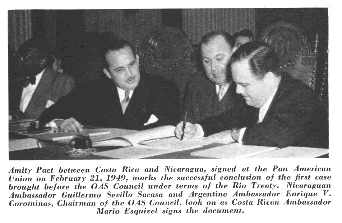
Signing of the Amity Pact between Costa Rica and Nicaragua, February 21st 1949
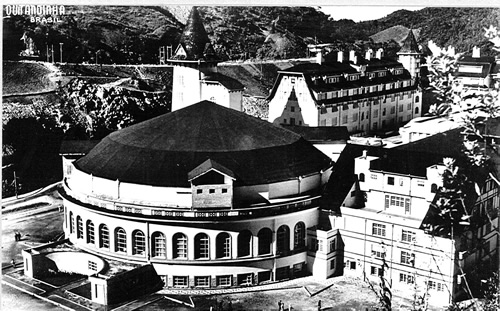
Petropolis, Quintandinha Hotel, meeting place of the Conference
¹ G. Pope Atkins Encyclopedia of the Inter-American System (Westport, Connecticut and London: Greenwood Press, 1997) 235.
|
1948 |
NINTH INTERNATIONAL CONFERENCE OF AMERICAN STATES |
Bogota, Colombia
May 30th - May 2nd 1948
Originally scheduled for 1943, but delayed due to World War II, the Ninth International Conference of American States was held in Bogota, Colombia on May 30th - May 2nd 1948. All twenty-one Latin American countries and the United States were represented at this milestone meeting, which reorganized the Inter-American system and created the OAS and its founding Charter. The conference was held in accordance with resolutions adopted at the Inter-American Conference on Problems of War and Peace held in Mexico in 1945. The conference signed five conventions and adopted forty-six resolutions.¹
The principal instrument adopted at the Bogota Conference was the Charter of the Organization of American States, which was prepared on the basis of an organic draft pact in accordance with Resolution IX adopted at the 1945 Mexico Conference. The Charter serves as the basic constitution for the American regional organization. It entered into force on December 13th 1951, after sufficient ratifications had been deposited, although in practice its provisions were adhered to soon after the meeting.²
The Pact of Bogota, also known as the American Treaty on Pacific Settlement, codified the previous eleven instruments for peaceful settlement that appeared in earlier treaties. It imposed a general obligation on the signatories to settle their disputes through peaceful means and required them to exhaust regional dispute-settlement mechanisms before bringing matters before the United Nations Security Council. It conferred jurisdiction on the International Court of Justice. Arbitration would only be obligatory when the court declared to have no jurisdiction in the dispute. The treaty was signed on behalf of twenty-one American States on April 30th, 1948 and ratified by fourteen states.³
“ …to refrain from the threat or the use of force, or from any other means of coercion for the settlement of their controversies, and to have recourse at all times to pacific procedures.” (Pact of Bogota, Article I)
The Bogota Conference marked the consolidation of nearly 60 years of trial and practice in the development of Inter-American cooperation and provided the institutional framework that had been lacking up until that point.
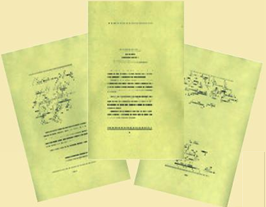
Charter of the Organization of American States
| PACT OF BOGOTA |
| OAS MEMBER STATE |
SIGNED |
RATIFIED |
| Argentina |
Apr 30, 1948 |
|
| Bolivia |
Apr 30, 1948 |
|
| Brazil |
Apr 30, 1948 |
Nov 9, 1965 |
| Chile |
Apr 30, 1948 |
Aug 21, 1967 |
| Colombia |
Apr 30, 1948 |
Oct 14, 1968 |
| Costa Rica |
Apr 30, 1948 |
Apr 27, 1949 |
| Cuba |
Apr 30, 1948 |
|
| Dominican Republic |
Apr 30, 1948 |
Aug 4, 1950 |
| Ecuador |
Apr 30, 1948 |
Mar 3, 2008 |
| Guatemala |
Apr 30, 1948 |
|
| Haiti |
Apr 30, 1948 |
Aug 21, 1950 |
| Honduras |
Apr 30, 1948 |
Jan 13, 1950 |
| Mexico |
Apr 30, 1948 |
Nov 23, 1948 |
| Nicaragua |
Apr 30, 1948 |
Jun 21, 1950 |
| Panama |
Apr 30, 1948 |
Apr 17, 1951 |
| Paraguay |
Apr 30, 1948 |
May 23, 1967 |
| Peru |
Apr 30, 1948 |
Feb 28, 1967 |
| United States |
Apr 30, 1948 |
|
| Uruguay |
Apr 30, 1948 |
Aug 17, 1955 |
| Venezuela |
Apr 30, 1948 |
|
RELEVANT DOCUMENTS
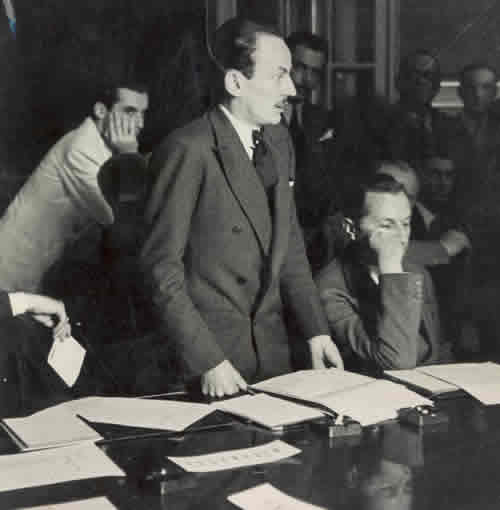
Alberto Lleras Camargo, First OAS Secretary General
¹ Encyclopedia of the Inter-American System (Westport, Connecticut and London: Greenwood Press, 1997) 290.
² Ibid, 291.
³ Ibid.
|
1959 |
FIFTH MEETING OF CONSULTATION OF MINISTERS OF FOREIGN AFFAIRS |
Santiago, Chile
August 12th - 18th 1959
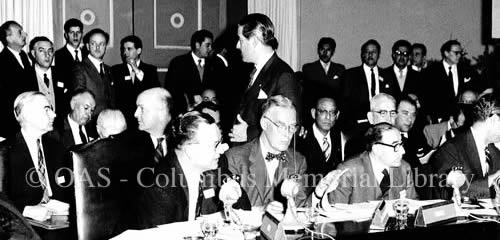
The Fifth Meeting of Consultation of Ministers of Foreign Affairs met in Santiago, Chile, from August 12th - 18th 1959. It was convoked in accordance with Articles 39 and 40 of the Charter of the Organization of American States, to address the extensive revolutionary activity and growing tensions in the Caribbean region. The meeting sought to find a balance between the growing demand for democratic progress and human rights and the Inter-American principle of non-intervention in the internal affairs of other states. The meeting adopted resolutions designed to promote human rights and representative democracy, the centerpiece of which was the Declaration on the Principles of Representative Democracy and Human Rights, commonly known as the "Declaration of Santiago". The Declaration of Santiago outlined that American governments should be the result of free elections, with fixed terms.
Another milestone of the Santiago Meeting was the creation of the Inter-American Commission on Human Rights as an OAS advisory group to carry out the provisions of the 1948 American Declaration of the Rights and Duties of Man. The Commission was based in Washington DC and began to operate in 1960.¹ The meeting also adopted Resolution IV, which strengthened the powers of the Inter-American Peace Committee (IAPC) and authorized it to act at the request of governments or on its own initiative.²

RELEVANT DOCUMENTS
- Declaration on the Principles of Representative Democracy and Human Rights (Declaration of Santiago). English
- Resolution I. English
- Resolution II. English
- Resolution IV. English
- Resolution VIII. English
- Resolution XIII. English
SPEECHES
- Address Delivered by the President Jorge Alessandri Rodriguez of Chile at the Inaugural Session, August 12th 1959 English
- Address by the Honorable Christian A. Herter, Secreatry of the United States, in Response, On Behalf of the Foreign Ministers, to the Address of Welcome by His Excellency the President of Chile English
¹ G. Pope Atkins Encyclopedia of the Inter-American System (Westport, Connecticut and London: Greenwood Press, 1997) 329.
² The Inter-American System: Its Development and Strengthening (Dobbs Ferry, New York: Oceana Publications, Inc., 1966), 83.
|
1959 |
INTER-AMERICAN COMMISSION ON HUMAN RIGHTS |
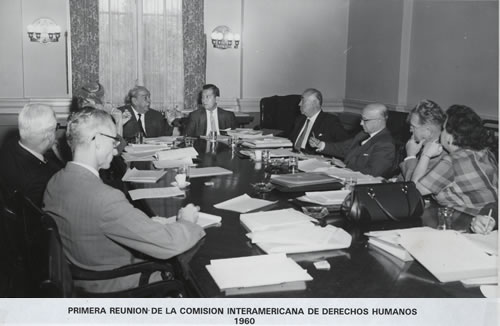 First meeting of the Inter-American Commission on Human Rights, 1960
First meeting of the Inter-American Commission on Human Rights, 1960
The creation of the Inter-American Commission on Human Rights (IACHR) was approved in 1959, following the adoption of Resolution VI by the Fifth Meeting of Consultation of Ministers of Foreign Affairs held in Santiago, Chile. Initially, the Commission was assigned the limited mandate of furthering the observance of human rights and assisting the OAS on such matters. Seven members, elected by the Council of the OAS, were to comprise the Commission and serve four-year terms. The IACHR was formally installed in Washington, D.C. in October 1960 as one of the Special Agencies and Commissions of the OAS. The Second Special Inter-American Conference in 1965 expanded the Commission’s mandate to take cognizance of claims of human rights violations in the American states. The IACHR was actively involved in the Dominican Republic crisis of 1965-1966 following suit with investigations in Honduras, El Salvador, and Haiti. The 1967 OAS Charter amendments further raised the status of the IACHR to that of a high-ranking agency directly under the new supreme General Assembly. In 1978, the American Convention on Human Rights was finally installed, transforming the IACHR’s system and expanding its functions and jurisdiction. In 1979, the Ninth Regular Session of the General Assembly approved a new statute.
The IACHR issues annual reports which have had significant impact on the actions of the Inter-American system with regards to interventions and conflict resolution efforts. It was instrumental in challenging human rights abuses carried out during the period of dictatorial regimes. As military regimes disappeared in the 1980s, the IACHR conducted investigations, reviewed individual petitions and received testimonies of survivors, and family and friends of those who had disappeared. The IACHR drafted and adopted two new conventions: The Inter-American Convention to Prevent and Punish Torture, which entered into force in 1987, and the Inter-American Convention on the Prevention of Forced Disappearances, which the General Assembly signed in June 1994.¹
RELEVANT DOCUMENTS
- Statutes of the Inter-American Commission on Human Rights. Download: English | Español
- Inter-American Convention to Prevent and Punish torture. Download: English | Español
- Inter-American Convention on the Prevention of Forced Disappearances. Download: English | Español
RELATED LINKS
¹ G. Pope Atkins Encyclopedia of the Inter-American System (Westport, Connecticut and London: Greenwood Press, 1997) 229-232.
|
1960 |
SIXTH MEETING OF CONSULTATION OF MINISTERS OF FOREIGN AFFAIRS |
San José, Costa Rica
August 16th - 21st 1960
The Sixth Meeting of Consultation of Ministers of Foreign Affairs met in San José, Costa Rica from August 16th - 21st 1960. It was convoked under the provisions of the Inter-American Treaty of Reciprocal Assistance (Rio Treaty) at the request of Venezuela, to address the conflict between it and the Dominican Republic. Venezuela alleged that the regime of Dominican President Rafael Trujillo was plotting to assassinate President Romulo Betancourt of Venezuela. The Inter-American Peace Committee investigated and reported back to the Meeting of Consultation in San José, on August 17th 1960. The ministers thus found that there was sufficient evidence to condemn the Dominican Government’s actions, called for a breaking of diplomatic relations, and imposed serious economic sanctions. These were not lifted until after the collapse of the Trujillo regime and his assassination.¹
RELEVANT DOCUMENTS
¹ O. Carlos Stoetzer The Organization of American States (Westport, Connecticut and London: Praeger, 1993) 46.
|
1960 |
SEVENTH MEETING OF CONSULTATION OF MINISTERS OF FOREIGN AFFAIRS |
San José, Costa Rica
August 26th 1960
The Seventh Meeting of Consultation of Ministers of Foreign Affairs was held in San Jose, Costa Rica from August 22nd - 29th 1960, immediately following the Sixth Meeting of Consultation. It was convoked at the request of Peru under the provisions of the OAS Charter to examine whether external communist influence and the Cuban government were contributing to several violent actions in circum-Caribbean nations. As a result of the concerns expressed by several OAS member states, and also due to the findings of a report submitted by the Inter-American Peace Committee, the ministers passed the “Declaration of San José”. The Declaration condemned all forms of “extra-continental intervention” that could endanger inter-American solidarity, reaffirmed the principles of non-intervention and declared that no American state could impose its ideologies or political and economic principles on another.¹
RELEVANT DOCUMENTS
¹ G. Pope Atkins Encyclopedia of the Inter-American System (Westport, Connecticut and London: Greenwood Press, 1997) 330.
|
1961 |
ALLIANCE FOR PROGRESS |
Punta del Este, Uruguay
August 1961
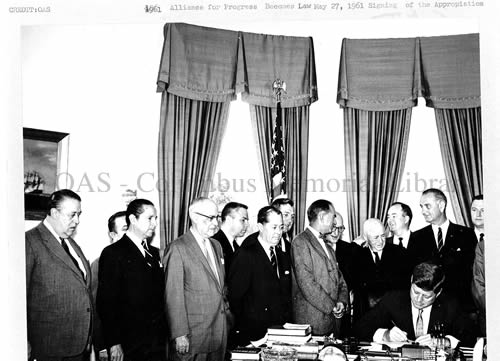
Alliance for Progress becomes Law, May 27, 1961. Signing of the Appropriation. President J.F. Kennedy, OAS Secretary General, José A. Mora
The Alliance for Progress was a ten year, $20 billion dollar cooperative program proposed by President John F Kennedy, intended to stimulate Latin American economic, political and social development. On January 20th 1961, in his inaugural address, President John F. Kennedy made a pledge to Latin America to translate US “good words into good deeds, in a new alliance for progress, to assist free men and free governments in casting off the chains of poverty”. In August 1961, a special meeting of the Inter-American Economic and Social Council (IAECOSOC) in Punta del Este enacted the Charter of the Alliance for Progress, which was accompanied with the Declaration to the Peoples of America, which outlined objectives and procedures for multilateral action. Specific goals included: sustained growth in per capita income of 2.5% per annum, more equitable income distribution, agrarian reform, stabilization of export prices and domestic price stability, elimination of adult illiteracy by 1970 and improvement of health and welfare. The Alliance for Progress faced many problems but despite criticism, the program made some very important contributions; in the early 1960s and 1970s, Latin American average economic growth rates ranged from 5% to 7%, significant training of government, business and grass roots leaders took place, and foundations were built for public education, health, community institution building and other social programs. More importantly, it introduced the concept of social and human resource development as a fundamental component of development programs and transformed approaches to international assistance. The OAS dissolved the program in 1973.
RELEVANT DOCUMENTS
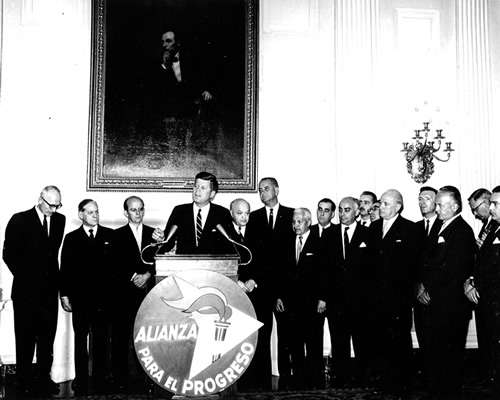
US President John F. Kennedy inaugurating the Alliance for Progress
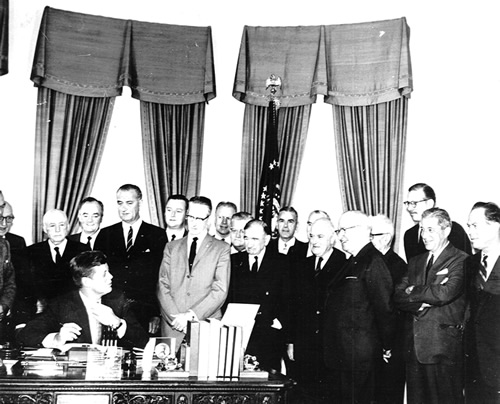
US President John F. Kennedy signing the Alliance for Progress
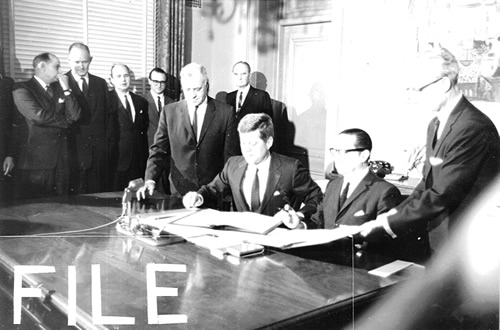

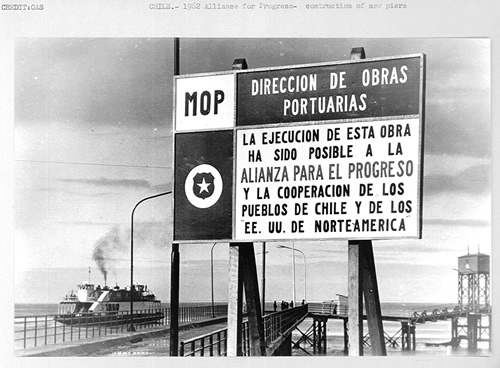
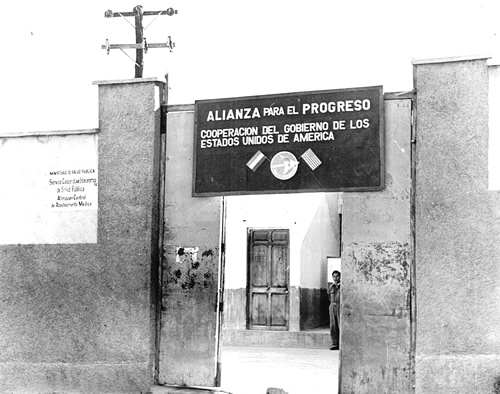


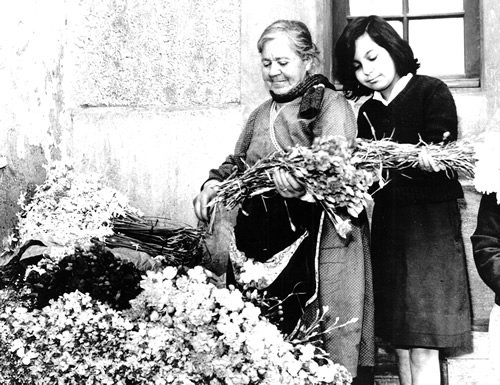

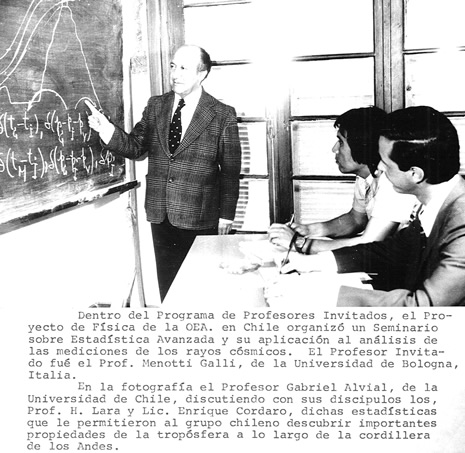
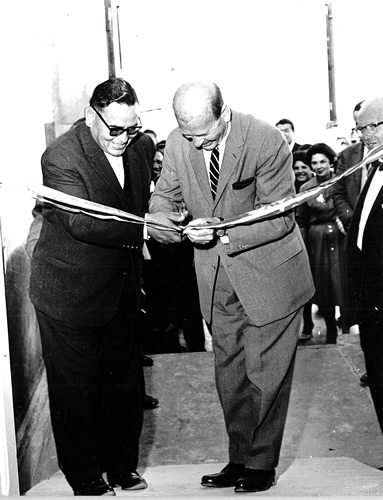
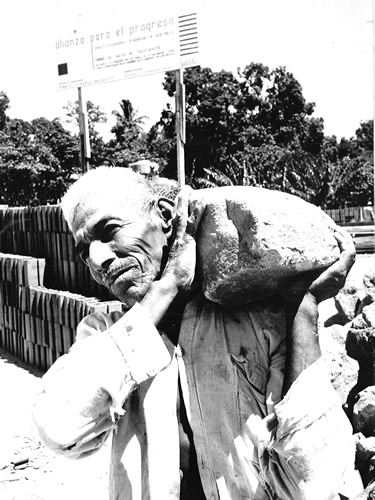
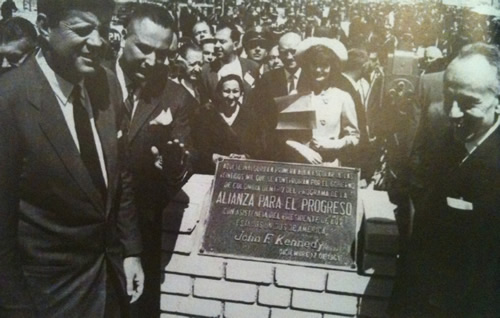
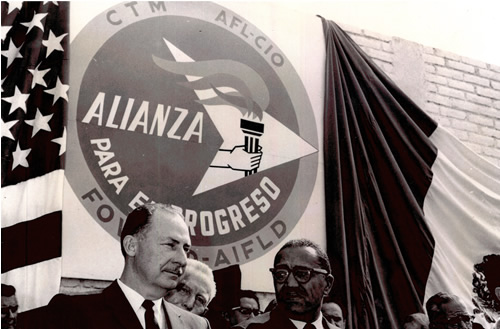
|
1965 |
TENTH MEETING OF CONSULTATION OF MINISTERS OF FOREIGN AFFAIRS |
Washington DC, United States
May 1965 - March 1970

Ecuadoriian General Telmo Vargas, military advisor to the OAS, greets officer of the Paraguayan contingent
The Tenth Meeting of Consultation of Ministers of Foreign Affairs was held in Washington DC, in May 1965 and closed formally in March 1970. The meeting was requested by Chile to deal with the Dominican Republic Civil War. The ministers approved a resolution calling on Dominicans to conclude a cease-fire and allow the creation of an international neutral zone for refugees in the area surrounding the foreign embassies. On May 1st , the meeting named a Special Committee of ambassadors made up of representatives from five member states, Argentina, Brazil, Colombia, Guatemala and Panama. The Committee was to depart at once for Santo Domingo and offer its good services to negotiate a cease-fire, evacuate refugees and foreign residents who wanted to leave, and lead an investigation of the Dominican situation. The Committee arranged talks to obtain a ceasefire, established a security zone, evacuated refugees and diplomatic personnel, and distributed food and medical care. On May 5th , members of the OAS Special Committee met with members of the Military Junta of Government and the Constitutional Government and signed the Act of Santo Domingo, which outlined the operational details. On May 6th , the ministers passed resolutions authorizing the establishment of the Inter-American Peace Force (IAPF). The IAPF was tasked with restoring peace, safeguarding the rights of civilians, and fostering a climate conducive to free elections. On May 11th, the ministers of foreign affairs extended the mandate to maintain the cease-fire and offer good offices to aid in the return to democratic institutions.¹
RELEVANT DOCUMENTS

Santo Domingo, Dominican policeman reads the appeal directed at the Dominican people by the Ad Hoc Committee of the OAS. The ‘Declaration to the Dominican People’ was printed in full in a special issue of the “Voice of the OAS”, a three-weekly publication appearing for several weeks in Santo Domingo to put across the point of view of the OAS Secretariat to the people.

Dominicans reading the ‘Declaration to the Dominican People’

Secretary General Jose Mora visits a wounded IAPF soldier

Young Evacuee-A child is placed aboard a Guatemalan Air force flight for evacuation to San Juan, Puerto Rico. The plane had earlier brought in a Guatemalan team of doctors and emergency medical supplies. Doctors working with OAS officials and the Dominican Red Cross made a general survey of the situation.

General Hugo Panasco Alvin of Brazil, Commander of the inter-American Peace Force, inspects mobile maintenance equipment during a tour of the 5th logistical command installation at San Isidro, DR



¹ G. Pope Atkins Encyclopedia of the Inter-American System (Westport, Connecticut and London: Greenwood Press, 1997) 134-138.
|
1967 |
TREATY FOR THE PROHIBITION OF NUCLEAR WEAPONS IN LATIN AMERICA AND THE CARIBBEAN (TREATY OF TLATELOLCO) |
Mexico City, Mexico
February 14th 1967
 |
| Alfonso Garcia Robles, Nobel Peace Laureate and Architect of the Treaty of Tlatelolco |
The Treaty for the Prohibition of Nuclear Weapons in Latin America and the Caribbean, conventionally named “Treaty of Tlateloco”, was signed in Mexico City on February 14th 1967. It is embodied by the Agency for the Prohibition of Nuclear Weapons in Latin America and the Caribbean (OPANAL). The Treaty stipulates that its signatories agree to prohibit and prevent the "testing, use, manufacture, production or acquisition by any means whatsoever of any nuclear weapons" and the "receipt, storage, installation, deployment and any form of possession of any nuclear weapons". Two additional Protocols were made to the Treaty: Protocol I, which obligates non-American countries with territories in the region to the terms of the Treaty, and Protocol II, which requires declared nuclear weapons states of the world to agree not to take any action that could undermine the nuclear-free status of the hemisphere. In addition, the Treaty provides for a comprehensive control and verification mechanism, overseen by OPANAL.
RELEVANT DOCUMENTS
RESOLUTIONS
- AG-RES. 1355 (XXV-O-95). English
- AG-RES. 1499 (XXVII-O-97). English
- AG-RES. 1571 (XXVIII-O-98). English
- AG-RES. 1622 (XXIX-O-99). English
- AG-RES. 1903 (XXXII-O-02). English
- AG-RES. 1414 (XXVI-O-96). English
- AG-RES. 2377 (XXXVIII-O/08). English
- OEA-Ser.P AG-RES. 1748 (XXX-O-00) OEA-Ser. AG-RES. 1748 (XXX-O-00) English
PRESS RELEASE
|
1967 |
PROTOCOL OF AMENDMENT TO THE CHARTER OF THE ORGANIZATION OF AMERICAN STATES (PROTOCOL OF BUENOS AIRES) |
Buenos Aires, Argentina
February 15th - 27th 1967
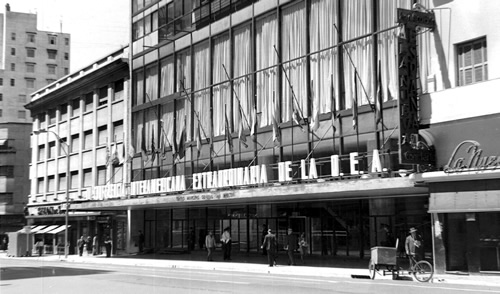
The Third Special Inter-American Conference met in Buenos Aires, Argentina from February 15th through the 27th and approved the Protocol of Amendment to the Charter of the Organization of American States, designated the Protocol of Buenos Aires. The amendments sought to place an increased emphasis on social and economic functions, relative to political ones. The Protocol states that the Permanent Council is to keep constant vigilance over the maintenance of friendly relations among Member states and effectively assist them in the peaceful settlement of their disputes. The Protocol entered into force on February 20, 1970, after the necessary ratifications.
RELEVANT DOCUMENTS
|
1969 |
THIRTEENTH MEETING OF CONSULTATION OF MINISTERS OF FOREIGN AFFAIRS |
Washington DC, United States
July 26th 1969 - November 17th 1980
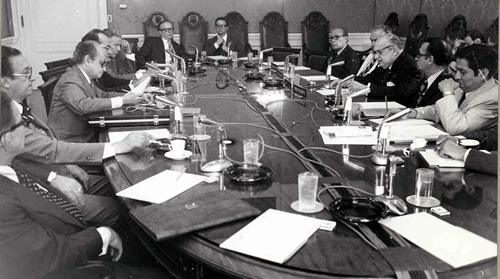
The Thirteenth Meeting of Consultation of Ministers of Foreign Affairs was held in Washington DC, from 1969-1980. It dealt entirely with the El Salvador-Honduras War. The conflict was the result of longstanding border and migration disputes, which, catalyzed by a soccer match dispute, escalated into full-scale war.
The first session was convened on July 26th - 30th 1969 and passed a resolution calling for the immediate withdrawal of Salvadoran troops from Honduran territory, which would be monitored by an investigating committee. The ministers called on the Inter-American Commission on Human Rights to work with the committee and made several recommendations aimed at easing tensions between the two countries. They made recommendations for a census to be carried out in both countries to ascertain the degree of trans-border migration. The special committee organized military and civilian observers from the OAS to assist in peacekeeping efforts and prisoner exchanges. The ministers achieved troop withdrawals and guarantees for Salvadoran citizens living in Honduras. Additionally, the Meeting called on all international organizations to cooperate with both disputants to find solutions for boundary and population problems. Over eleven years, the special committee made regular reports to the Meeting of Consultation.
The foreign ministers and the five Central American states met from June 2-4, 1970 in San José, Costa Rica and adopted the Pact of San José. The Pact of San José established a demilitarized security zone on both sides of the border. However, since there was no agreement on the border, the pact did not go into effect.
In May 1971, the OAS sent officers to patrol the border and on October 6th 1976, the foreign ministers from El Salvador and Honduras signed an agreement to submit disputes to mediation. Finally, in 1980, the disputants, working with former President Bustamente of Peru, came to a resolution of the border dispute. On October 30th, in Lima, the two states signed a General Treaty of Peace. The Treaty entered into force on December 10th in Tegucigalpa when the two governments exchanged instruments of ratification. Finally, on November 17th 1980, the Thirteenth Meeting of Consultation was closed.¹
RELEVANT DOCUMENTS
¹ G. Pope Atkins Encyclopedia of the Inter-American System (Westport, Connecticut and London: Greenwood Press, 1997) 169-172.
|
1969 |
INTER-AMERICAN SPECIALIZED CONFERENCE ON HUMAN RIGHTS |
San José, Costa Rica
November 22nd 1969
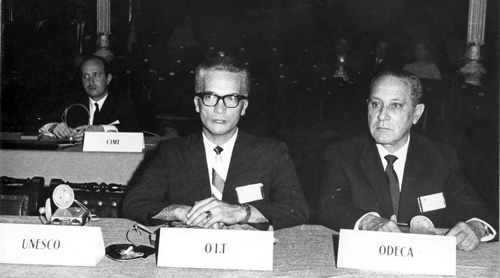
The Inter-American Specialized Conference on Human Rights was held in November 1969, in San José. The American Convention on Human Rights, also known as Pact of San José, was issued on November 22nd 1969 and was an extension of the American Declaration on the Rights and Duties of Man (1948) and other related acts. The Convention re-created the Inter-American Commission on Human Rights and its procedures and established the Inter-American Court of Human Rights. The Convention outlined basic human rights such as the right to life, liberty, personal security, fair trials, equality before the law, freedom of speech, religion, political participation and right of due process. It entered into force on July 18th, 1978.
On November 17th 1988, at the Eighteenth Regular Session of the OAS General Assembly, fourteen states signed the Additional Protocol to the American Convention on Human Rights in the Area of Economic, Social and Cultural Rights, also known as Protocol of San Salvador. It entered into force on November 16th 1999, after the necessary ratifications.
|
1971 |
FOURTEENTH MEETING OF CONSULTATION OF MINISTERS OF FOREIGN AFFAIRS |
Washington DC, United States
January 30th - 31st 1971
The Fourteenth Meeting of Consultation of Ministers of Foreign Affairs was convened on January 30th - 31st 1971, in Washington DC, and met concurrently with the Third Special Session of the OAS General Assembly. It dealt entirely with the Ecuador-United States Conflict. The conflict was rooted in a longstanding territorial sea issue between the United States and Chile, Peru and Ecuador. In 1952, the three South American west coast states had signed a joint declaration establishing a two hundred-mile maritime zone, over which they asserted their sole sovereignty and jurisdiction. The United States conformed to the traditional three-mile territorial limit and an adjacent twelve-mile zone for exclusive fishing rights. Ecuador began to seize boats flying the US flag on the grounds of illegal fishing in Ecuadorian waters. The United States then stopped selling military equipment to Ecuador. Ecuador requested a Meeting of Consultation of Ministers of Foreign Affairs. The Ministers adopted a resolution urging the disputants to refrain from activities that could further exacerbate tensions and to work towards a solution for their differences. At this point, the United Nations Conference on the Law of the Sea was in development and Ecuador ceased arresting foreign fishing vessels. The United States supported several measures of the UN Treaty in practice and the conflict between the two countries ended.¹
RELEVANT DOCUMENTS
¹ G. Pope Atkins Encyclopedia of the Inter-American System (Westport, Connecticut and London: Greenwood Press, 1997) 168-169.
|
1978 |
SEVENTEENTH MEETING OF CONSULTATION OF MINISTERS OF FOREIGN AFFAIRS |
Washington DC, United States
September 21st 1978
The Seventeenth Meeting of Consultation of Ministers of Foreign Affairs was first convened at the request of Venezuela, on September 21st, 1978, in Washington DC to address the deteriorating situation in Nicaragua and the increased civil strife there. The meeting adopted a resolution urging various governments to refrain from actions that might further rouse tensions, and also a second resolution to deploy the Inter-American Commission of Human Rights (IACHR). The IACHR visited Nicaragua in October 1978 and issued a highly critical report of the Somoza dictatorship, describing human rights violations and the repression of Nicaraguan civilians. The meeting was reconvened in June 1979 to consider the “critical” situation in Nicaragua. Based on the IACHR report, the ministers adopted an unprecedented resolution which called for the immediate and definite replacement of the Somoza regime and the establishment of a pluralist representative government.¹
RELEVANT DOCUMENTS
¹ G. Pope Atkins Encyclopedia of the Inter-American System (Westport, Connecticut and London: Greenwood Press, 1997) 336.
|
1978 |
EIGHTEENTH MEETING OF CONSULTATION OF MINISTERS OF FOREIGN AFFAIRS |
Washington DC, United States
December 30th 1978
The Eighteenth Meeting of Consultation of Ministers of Foreign Affairs was convoked by the Permanent Council of the OAS under the provisions of the Inter-American Treaty of Reciprocal Assistance. It was held in Washington DC on December 30th 1978 and dealt entirely with the Costa Rica-Nicaragua conflict. Costa Rica charged that Nicaragua’s cross-border activities constituted acts of aggression. The ministers counseled both parties to refrain from any actions that could worsen the situation and appealed to Nicaragua to refrain from any actions against Costa Rica. A Committee of Civilian Observers was established and tasked with patrolling the border between the two countries and with reporting the situation.
RELEVANT DOCUMENTS
|
1985 |
PROTOCOL OF AMENDMENT TO THE CHARTER OF THE ORGANIZATION OF AMERICAN STATES (PROTOCOL OF CARTAGENA DE INDIAS) |
Cartagena de Indias, Colombia
December 5th 1985
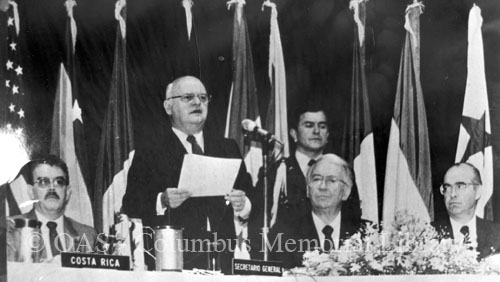
In 1985, the Fourteenth Special Session of the General Assembly approved the Protocol of Cartagena de Indias, which amended the OAS Charter and gave the Secretary General greater authority. Specifically, the Protocol provides that any party to a dispute in which one of the peaceful procedures provided for in the Charter is underway, may resort to the Permanent Council to examine the situation. Also, the Secretary General of the OAS could now bring to the attention of the General Assembly or the Permanent Council any matter that in his opinion might threaten the peace and security of the Hemisphere.
RELEVANT DOCUMENTS
|
1987 |
ESQUIPULAS II ACCORDS |
August 7th 1987

The “Procedure for the Establishment of a Firm and Lasting Peace in Central America”, known informally as the Esquipulas II Accords, evolved from a ten-point plan proposed by then President of Costa Rica, Oscar Arias. The Esquipulas II plan defined a number of measures to promote political reconciliation within each of the Central American States, an end to hostilities, democratization of their domestic political processes, and negotiations on arms control and assistance to refugees. The Agreement appealed to outside states to cease assisting the irregular and insurgent forces and to prevent the use of their territories to support aggression against other states. Both the Organization of American States and the United Nations played important roles in the Central American Peace Process. The Esquipulas II Accords laid the foundations for international verification procedures and supported a timetable for implementation of the Plan.¹

 ¹ G. Pope Atkins Encyclopedia of the Inter-American System (Westport, Connecticut and London: Greenwood Press, 1997) 172-173.
|
1990 |
CIAV-NICARAGUA |
|
1990 - 1997
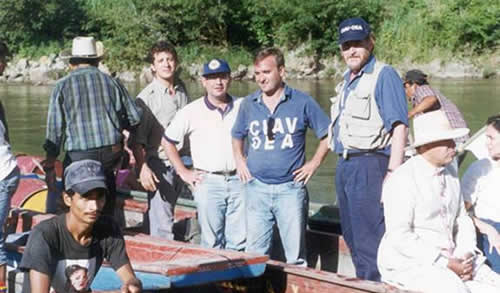
The International Commission for Support and Verification (CIAV/OAS) was a joint effort by the Secretary Generals of the Organization of American States and the United Nations in support of the Esquipulas II Peace Plan with the purpose of demobilizing and reinserting into society illegal armed groups. It was created on August 25, 1989, in Tela, Honduras. Despite the United Nation’s brief military role during the disarmament phase, CIAV was the only peace mission in the Hemisphere that was almost exclusively run by the OAS and represents the first true civilian-led peace-building mission.
Between 1990 and 1997, CIAV demobilized 22,500 fighters and repatriated 18,000 Nicaraguans from Honduras and Costa Rica. CIAV helped facilitate the disarmament process in three stages: in the 1st stage (1991-1992) CIAV carried out a gradual demobilization of more than 20,000 combatants through methods such as the repurchasing of weapons; the second stage saw the demobilization of 600 individuals belonging to the armed group Northern Front 3-80, and in the third stage (1996-1997) CIAV disarmed approximately 1,000 fighters.
Additionally, CIAV provided humanitarian assistance, distributing food, clothing and tools to approximately 120,000 people, providing medical assistance to the disabled and administering social re-integration programs for people affected by the conflict. The Mission monitored the security rights and guarantees that had been given to the former Nicaraguan Resistance combatants, and verified the implementation of the peace agreements. It also mediated between the Government and the Roman Catholic Church in a commission to investigate human rights abuses. In the end, CIAV made significant contributions to the strengthening of the Nicaraguan government and grassroots institutions dedicated to human rights, conflict mediation and dialogue.
Because for most of its life CIAV was entirely composed of civilians, it proved to be very cost effective. The experience gained from this mission significantly reinforced the OAS’s standing in the Hemisphere as the lead agency for the peaceful resolution of conflicts and settlement of disputes.
Photo Gallery
20th Anniversary of the CIAV-Nicaragua (International Support and Verification Commission)
View gallery
SPEECHES
- César Gaviria Trujillo’s speech at the Ceremony of Termination of Activities in CIAV Español
RELATED RESOLUTIONS
|
1991 |
SANTIAGO COMMITMENT TO DEMOCRACY AND THE RENEWAL OF THE INTER-AMERICAN SYSTEM |
Santiago, Chile
June 4th 1991
The Santiago Commitment to Democracy and the Renewal of the Inter-American System, also known as Resolution 1080, was adopted on June 4th 1991, at the Twenty-first Annual Regular session of the General Assembly of the Organization of American States. Resolution 1080 represents established procedures to respond collectively to any disruption of the constitutional order. It gives the Secretary General of the OAS the power to convene the Permanent Council to study and investigate any constitutional breakdown, and if necessary, to convoke an ad hoc meeting of the Ministers of foreign affairs or an extraordinary session of the General Assembly to examine the facts and intervene diplomatically to respond to a threat to representative democracy.
| APPLICATIONS OF RESOLUTION 1080 |
| Haiti |
1991 |
Military forces overthrew democratically elected President Jean-Bertrand Aristide |
| Peru |
1992 |
President Alberto Fujimori illegally shut down the National Congress |
| Guatemala |
1993 |
President Jorge Serrano suspended the constitution in a self-coup |
| Paraguay |
1996 |
Army Commander, General Lino Oviedo refused to resign when asked by President Juan Carlos Wasmosy to step down from that position, sparking a constitutional crisis |
|
RELEVANT DOCUMENTS
RELATED RESOLUTIONS
|
1992 |
COOPERATION FOR SECURITY AND DEVELOPMENT IN THE HEMISPHERE-REGIONAL CONTRIBUTIONS TO GLOBAL SECURITY |
|
May 23rd 1992
Adopted at the eighth plenary session, held on May 23rd 1992, the Resolution for Cooperation for Security and Development in the Hemisphere-Regional Contributions to Global Security, recognizes the opportunity and need for increased dialogue in security matters and reaffirms that the pacific settlement of disputes is a central tenet to both the OAS charter and international law. The Resolution urges Member States to accept as a guiding principle regional disarmament and security/stability enhancement. Various measures are urged to implement the resolution, from maintaining a minimal military to restricting foreign nationals from using domestic territory to destabilize governments or violate the rule of law.
RELEVANT DOCUMENTS
|
1992 |
MISSION TO PERU |
Peru
April 13th 1992
 |
| Alberto Fujimori, President of Peru (1990 – 2000) |
On April 5th 1992, the Peruvian Government dissolved and shut down the Congress and assumed full legislative powers and “reorganized” the Judicial branch of the Government. One week later, the Foreign Ministers met and adopted Resolution 1, “Support for the Restoration of Democracy in Peru.” The OAS condemned the action and sent a mission headed by the Foreign Minister of Uruguay, Héctor Gross Espiel and the OAS Secretary General, João Clemente Baena Soares, in order to promote dialogue between Government authorities and opposition groups. After three visits to the country, it was agreed that elections would be held to establish a Constituent Assembly. The elections took place and were monitored by an OAS electoral observation mission.
|
1992 |
SPECIAL MISSION IN SURINAME |
Suriname
1992 – 2000

Edgardo Reis, Chief of the OAS Special Mission in Suriname
On July 22nd 1992, the Government of Suriname and the Organization of American States signed an agreement for the establishment of the “Special Mission for the Strengthening of Democracy and Promotion of Peace in Suriname”. The OAS was instrumental in the negotiations that led to the peace agreement signed in Lelydorp, and in offering legal assistance to amnesty efforts. The OAS also played a significant role in aiding the Government in the disarmament and demobilization of illegal armed groups in the country. It coordinated and assisted the demining of war zones and destroyed a total of 211 weapons, 3, 154 ammunitions, 266 chargers, 38 explosive devices and 116 military materiel. During 1994-1995, the OAS provided technical and financial support to the Independent Electoral Counsel, to reform and restructure the electoral process in preparation for the 1996 elections. During its presence in Suriname, the OAS Special Mission made many contributions towards strengthening of the country’s democratic framework.
|
1993 |
INTERNATIONAL CIVILIAN MISSION IN HAITI (MICIVIH) |
|
Haiti
1993 – 2000
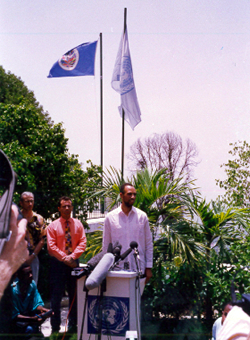 |
| Colin Granderson, Chief of the MICIVIH |
The International Civilian Mission in Haiti (MICIVIH) was the first fully integrated field mission between the United Nations and the Organization of American States. It was established in February 1993, at the request of the legitimate government of Haiti to monitor the observance of human rights, in the aftermath of the coup d’état in which the military ousted the democratically elected President Aristide.
The Mission monitored the human rights situation via several field offices and produced regular reports, as required by the Secretary Generals of both organizations.
The Mission verified the registries of jails and detention centers and trained police officers and wardens in the respect for human rights and just treatment of prisoners. Furthermore, MICIVIH gave technical assistance to the judiciary and promoted reforms to the criminal system. To this end, it trained magistrates and judges to meet the demands of a large backlog of open cases so that they could be brought to trial. The Mission enabled the Ministry of Education and NGO representatives with civic and human rights education programs.
The Mission initiated a large-scale project to create a civil registry, which until that point had been virtually non-existent or very precarious. This enabled the 1995 elections to take place. The process of registry in Haiti began as an electoral but ultimately evolved into a civil registry. This process gave origin to the creation of national identification documents.
|
1993 |
PROTOCOL OF AMENDMENT TO THE CHARTER OF THE ORGANIZATION OF AMERICAN STATES (PROTOCOL OF MANAGUA) |
Managua, Nicaragua
June 10th 1993
On June 10th 1993, the Nineteenth Special Session of the General Assembly met in Managua, Nicaragua and approved the “Protocol of Amendment to the Charter of the Organization of American States”. The Managua Protocol improved the organizational structure to bolster economic cooperation and development. It created the Inter-American Council for Integral Development (CIDI) to replace the Economic and Social Council and the Council for Education, Science, and Culture. The key objectives of CIDI are to serve as a forum for technical policy-level discussions on matters related to development, to be a catalyst and promoter of development activities in response to mandates from the Summits of the Americas, and to strengthen a hemispheric partnership among OAS countries to promote cooperation for development and to help eliminate extreme poverty in the hemisphere. The Protocol of Managua went into force on January 29th 1996.
RELEVANT DOCUMENTS
|
1995 |
DECLARATION OF SANTIAGO ON CONFIDENCE-AND SECURITY-BUILDING MEASURES |
Santiago, Chile
November 10th 1995
On November 10th 1995, at the fourth plenary session, OAS Member State governments agreed to utilize confidence- and security- building measures, such as: previous notice of military operations; exchanging information on defense-related policies; considering a consulting process which would limit conventional weapons; cooperative programs for natural disasters; general civilian and military interchange to promote an environment of trust; and educational programs for peace.
RELEVANT DOCUMENTS
|
1996 |
INTER-AMERICAN SPECIALIZED CONFERENCE ON TERRORISM |
Lima, Peru
April 23rd-26th 1996
The Inter-American Specialized Conference on Terrorism arose out of the Plan of Action of the Summit of the Americas, in which the heads of state and government referred to the elimination of "the threat of national and international terrorism" and expressed their desire that the governments of member states convene a special OAS conference on the prevention of terrorism. On April 26th 1996, the Conference adopted the Declaration of Lima to Prevent, Combat and Eliminate Terrorism and the Plan of Action on Hemispheric Cooperation to Prevent, Combat and Eliminate Terrorism.
RELEVANT DOCUMENTS
- Declaration of Lima to Prevent, Combat and Eliminate Terrorism English
- Plan of Action on Hemispheric Cooperation to Prevent, Combat and Eliminate Terrorism English
- Final Report including list of adopted agreements, list of participants and list of documents English
RESOLUTIONS
FOLLOW-UP RESOLUTIONS
|
1996 |
SPECIAL PROGRAM TO SUPPORT GUATEMALA |
Guatemala
1996-2003

In 1996 the OAS launched the Special Program to Support Guatemala with the overarching goal of assisting the country in its path towards a consolidated democracy and peace. The program lasted 7 years and adapted itself to the dynamics of the implementation of the historic peace accords of December 1996, which put an end to 36 years of civil war. This wide-ranging program focused on promoting a culture of dialogue, reinserting former combatants, supporting the demining process, providing legal assistance to the National Congress, strengthening the democratic institutions and providing electoral assistance.
A crucial component in the Guatemalan peace process was the reinsertion of the demobilized members of the Guatemalan National Revolutionary Unit. Capitalizing on the demobilization and reintegration experience gained in the CIAV-OAS peace mission in Nicaragua (1990-1997), the OAS led an extremely successful reinsertion project. From 1996 to 1998, it reinserted, alphabetized and trained over 3000 former combatants between the ages of 15 and 22, from 132 communities.
Another highly successful project of the Special Program to Support Guatemala was the Culture of Dialogue: Development of Resources for Peacebuilding in Guatemala, more commonly known as PROPAZ-OAS. This conflict prevention and management program helped Guatemalans address ongoing social and political tensions by providing them with training on negotiation, mediation and conflict resolution skills.
RELATED RESOLUTIONS
|
1997 |
PROTOCOL OF AMENDMENT TO THE CHARTER OF THE ORGANIZATION OF AMERICAN STATES (PROTOCOL OF WASHINGTON) |
Washington DC, United States
September 26th 1997
Adopted at the Sixteenth Special Session of the General Assembly of the Organization of American States on December 14th 1992, the Protocol of Amendment to the Charter of the Organization of American States: Protocol of Washington, adds provisions for the temporary suspension of member states in which the democratic process has been illegally halted. Any member state, whose democratically elected government has been disestablished by force, may be suspended and prohibited from participating in meetings of the General Assembly and other OAS bodies. The Protocol recommends negotiation prior to suspension and requires a two-thirds vote. It entered into force on September 26th 1997.
RELEVANT DOCUMENTS
|
1997 |
INTER-AMERICAN CONVENTION AGAINST THE ILLICIT MANUFACTURING OF AND TRAFFICKING IN FIREARMS, AMMUNITION, EXPLOSIVES, AND OTHER RELATED MATERIALS (CIFTA) |
November 14th 1997

On November 14th, 1997, at the First Plenary Session, the OAS took a significant step toward reining in the illegal trade of small arms and light weapons by adopting CIFTA-the first legally binding regional agreement on illicit firearms trafficking. The Convention raises regional standards for firearms export controls. By creating a mechanism for exchanging information, cooperating on investigations, and ensuring that law enforcement personnel are adequately trained it also increases the regional capacity to identify, investigate and prosecute illicit firearms manufacturers and traffickers.
RELEVANT DOCUMENTS
RELATED RESOLUTIONS
|
1998 |
DECLARATION OF SAN SALVADOR ON CONFIDENCE AND SECURITY-BUILDING MEASURES |
San Salvador, El Salvador
February 28th 1998
On February 28th, 1998, the OAS member states met at the Fifth Plenary session to follow up on the 1995 Santiago Conference and signed the Declaration of San Salvador. The Declaration adds additional measures to the Declaration of Santiago, promoting the role of legislators in confidence-building measures, extending the role of diplomatic training institutes, military and academic academies in the creation of peace-based coursework and conferences; promoting a culture of peace in border regions; and many other transparency-and confidence-building measures.
RELEVANT DOCUMENTS
- Declaration of San Salvador. English
|
1999 |
POLITICAL DECLARATION OF MERCOSUR, CHILE AND BOLIVIA AS A ZONE OF PEACE
|
| Ushuaia, Argentina
July 24th 1999
Issued in Ushuaia, Argentina, on July 24th, 1999, the Political Declaration of MERCOSUR, proclaims MERCOSUR countries, Chile and Bolivia to be a zone of peace, free from weapons of mass destruction. Signatories also commit to claiming peace as indispensable to the continuation and developing of MERCOSUR integration.
RELEVANT DOCUMENTS
- Political Declaration of MERCOSUR, Bolivia and Chile as a Zone of Peace English
|
2000 |
FUND FOR PEACE: THE PACIFIC SETTLEMENT OF TERRITORIAL DISPUTES |
Windsor, Canada
June 6th 2000
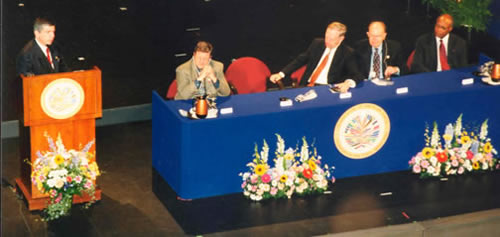
Border and territorial disputes present a serious risk to hemispheric security and have been for too long a contentious and unnecessary barrier to economic and social development in the Western Hemisphere. They regularly frustrate international cooperation on trade, environment protection, security, and law enforcement, are a drain on budgets and resources, and occasionally lead to armed conflict.
 In June 2000, recognizing the need to strengthen the Organization’s capacity in peace-building and conflict resolution, the OAS Foreign Ministers, meeting at the General Assembly in Windsor, Canada, adopted Resolution 1756 (XXX-O/00) and formally established The Fund for Peace: Peaceful Settlement of Territorial Disputes. In June 2000, recognizing the need to strengthen the Organization’s capacity in peace-building and conflict resolution, the OAS Foreign Ministers, meeting at the General Assembly in Windsor, Canada, adopted Resolution 1756 (XXX-O/00) and formally established The Fund for Peace: Peaceful Settlement of Territorial Disputes.
The Peace Fund, as it is most commonly known, is a mechanism designed to provide financial resources to OAS Member States that so request in order to enable the Organization to react swiftly to an unforeseen crisis resulting from a territorial dispute, as well as to strengthen the General Secretariat’s knowledge and experience in the field of territorial dispute settlements. The Fund consists of a General Fund, which functions like a seed fund for unanticipated conflicts, and subfunds established for specific disputes. It is open to contributions from OAS Member States, Permanent Observers, other states, as well as other entities, including companies and individuals. Since its inception the Fund has received over 5 million dollars, in contributions ranging from 3,000 to 1 million US dollars.
The Peace Fund, however, is more than a simple financing tool. By jointly appealing to the OAS for assistance in peacefully resolving a territorial dispute, the Parties can avail themselves of a range of conflict resolution mechanisms contemplated under the OAS Charter, including direct negotiation, good offices, mediation, investigation and conciliation, judicial settlement, arbitration and any other mechanism which the Parties jointly agree.
The Parties can also access the technical expertise of the OAS in territorial dispute resolution, including expertise in diplomacy; international law, including the Law of the Sea; geographic, cartographic and geospatial expertise, through the membership of the Pan-American Institute of History and Geography; and a range of outside technical experts with whom the OAS General Secretariat maintains relationships.
In June 2009, at the OAS General Assembly in San Pedro Sula, Honduras, the Foreign Ministers of the Americas adopted Resolution AG/RES.2525 “Fund for Peace: Peaceful Settlement of Territorial Disputes” to acknowledge both the work of the Peace Fund and the Inter-American Peace Forum and in an effort to encourage OAS Member States, Permanent Observers, and other potential donors to continue to support the fund financially in view of its effectiveness in peacefully resolving conflicts.
Since its creation, the OAS Peace Fund has helped resolve tensions between Honduras and Nicaragua, which arose out of a maritime dispute in the Caribbean Sea; and supported the demarcation of the international border between Honduras and El Salvador. Currently, the OAS is providing technical and political assistance to Belize and Guatemala with regard to their longstanding territorial differendum. Through the Peace Fund, the Organization is facilitating the negotiations between the two countries and promoting confidence-building measures in the Adjacency Zone, while also maintaining a peacekeeping office on the ground.
Learn More about the OAS Peace Fund.
|
2000 |
BELIZE AND GUATEMALA DIFFERENDUM |
 |  |
OAS Secretary General, José Miguel Insulza, meets with the President of Guatemala, Alvaro Colom (left),
and with the Foreign Minister of Belize, Wilfred Elrington (right) |
In March 2000, the governments of Belize and Guatemala restarted talks on their longstanding territorial differendum, under the auspices of the Secretary General of the Organization of American States. On November 8, 2000, Belize and Guatemala signed the first Agreement on Confidence Building Measures, through which the two parties agreed to respect an “Adjacency Line” between each country and an "Adjacency Zone" extending one kilometer east and west from this line. On February 7, 2003, the Foreign Ministers of Belize and Guatemala signed a second Agreement to Establish a Transition Process and Confidence-Building Measures, which was later amended in September 2005 through "Agreement on a Framework for Negotiations and Confidence-Building Measures between Belize and Guatemala”. Central to the second agreement was the establishment of the OAS Office in the Adjacency Zone for the purpose of fostering community-to-community contacts across the Adjacency Line and verifying any transgression of the established confidence-building measures and any incidents which may occur in that Zone. The Agreement also called for the establishment of a Group of Friends of the Belize-Guatemala Transition Process (the “Group of Friends”), consisting of OAS Member and Observer States, and others interested in supporting a peaceful resolution to the territorial differendum. The Group of Friends acts as an advisory body to the Secretary General and provides political and operational support for undertaking the various activities contemplated under the agreement on confidence-building measures in force.
Following signature of the 2005 Agreement, two ministerial meetings took place. At the second such meeting, in February 2006, the Secretary General proposed that the negotiation process concerning the territorial differendum begin with the maritime zone. For this aspect of the differendum, the Government of Honduras was invited to participate. A Negotiating Group was formed, which met on several occasions at both the ministerial and technical level, coordinated and facilitated by the Secretary General’s Special Representative. Unfortunately, after almost two years of negotiations, in which a certain degree of rapprochement was achieved, the Parties failed to reach an agreement. The Secretary General therefore recommended that the most appropriate venue for resolving the differendum would be the International Court of Justice. Both countries assented and on December 8, 2008, the Foreign Ministers of Belize and Guatemala signed, at OAS headquarters, the “Special Agreement between Guatemala and Belize to submit the territorial, insular and maritime claim of Guatemala to the International Court of Justice.”
On April 27, 2012, the Ministers of Foreign Affairs of Belize and Guatemala met with the OAS Secretary General in Washington, D.C., and agreed that the simultaneous referenda to submit Guatemala’s claim to the International Court of Justice would be held on Sunday, October 6, 2013. On that occasion, both governments requested the support of the General Secretariat for the education and sensitization campaigns that will be launched to inform the people of both Belize and Guatemala about the up coming differendum process as well as the advantages of submitting the dispute to the ICJ and the disadvantage if it is not submitted.
The final decision to take the case to the ICJ must be confirmed through national referenda in both countries. Following a failed attempt at holding the referenda in 2013, the countries agreed to create the appropriate conditions so that a new date for holding the referenda could be fixed. To this end, on January 24th, 2014, the Foreign Ministers of Belize and Guatemala, together with the Secretary General of the OAS, signed the Roadmap Agreement for Strengthening Bilateral Relations and established the Belize- Guatemala Joint Commission to explore and develop projects and programs between the two countries, with the goal of strengthening the ties of friendship and cooperation between them. The objective of the Road Map was to disengage the issue of the differendum from the urgent need to consolidate the bilateral relationship for the sake of regional cooperation and integration. Under this framework, sixteen bilateral agreements (thirteen formal and three informal) were negotiated and dozens of bilateral meetings among different sectors of society took place. This was a historic step that was accomplished within less than 12 months, which culminated in December 2014. For the first time in history, Belize and Guatemala sat down to normalize their good neighborly relations by formalizing how they will work together in the future on a vast number of issues of common interest and concern. The success of these efforts was key to continue to move the process forward. As a result, on May 25, 2015 the Foreign Ministers of Belize and Guatemala signed the Protocol to the Special Agreement with the OAS Secretary General as witness. This Protocol enables Belize and Guatemala to hold the referenda either simultaneously or separately on the date that is more convenient to each of the Parties.
Thanks to the support of the OAS through the Peace Fund, Belize and Guatemala are closer than ever to finding a permanent solution to their centuries-old conflict.
RELEVANT TREATIES
- Heads of Agreement – Trilateral agreement between Belize, Guatemala and the UK (1981) Español
- Aycinena-Wyke (1859) Español
- Dallas-Clarendon Treaty (1856) English
- Clayton-Bulwer Treaty (1850) Español
- Treaty of Amiens (1801) Español
- London Convention (1786) Español
- Paris Peace Treaty (1783) English
- Treaty of Paris (1763) English
AGREEMENTS
- Special Agreement to Submit Guatemala’s Territorial, Insular, and Maritime Claim to the International Court of Justice (December 2008) English | Español
- Agreement on a Framework for Negotiations and
Confidence-Building Measures (September 2005) English | Español
- Agreement to Establish a Transition Process and Confidence
Building Measures Between Belize and Guatemala (February 2003) English | Español
- Plan of Action to Implement the November 8, 2000 Agreement on Confidence-Building Measures (January 2001) English | Español
- Agreement on Confidence Building Measures between Belize and Guatemala (November 8, 2000) English | Español
- Protocol to Amend the Special Agreement (May 25, 2015) English | Español
Agreements signed on December 17th in Placencia, Belize
-
Agreement Between Belize And The Republic Of Guatemala On The Harmonization Of Operating Hours At Legal Terrestrial Entry Points
English |
Español
-
greement Between Belize And The Republic Of Guatemala For The Protection, Conservation, Recovery And Return Of Items Of Cultural And Natural Patrimony Which Have Been Stolen, Pilfered, Looted, Exported, Imported Or Trafficked Unlawfully
English |
Español
-
Agreement Between Belize And The Republic Of Guatemala On The Mutual Recognition Of Driver’S Licence
English |
Español
-
Agreement Between Belize And The Republic Of Guatemala On Equivalency Of Studies And The Recognition Of Educational Documents
English |
Español
-
Agreement Between Belize And The Republic Of Guatemala On Electric Power Trade, Transmission Interconnection And Grid Connectivity
English |
Español
-
Agreement Between Belize And The Republic Of Guatemala For The Protection Of The Environment And The Sustainable Use Of Resources
English |
Español
-
Agreement Between Belize And The Republic Of Guatemala On Expedited Deportation
English |
Español
-
Agreement Between Belize And The Republic Of Guatemala On The Movement Of Students Through Terrestrial Ports Of Entry
English |
Español
-
Agreement Between Belize And The Republic Of Guatemala For The Serving Of Penal Sentences
English |
Español
-
Agreement Between Belize And The Republic Of Guatemala On Programme For Seasonal Workers
English |
Español
-
Agreement Between Belize And The Republic Of Guatemala On The Recovery And Return Of Vehicles Stolen, Confiscated Or Impounded Illegall Y Or Inappropria Tel
English |
Español
-
Agreement Between Belize And The Republic Of Guatemala To Facilitate The Issuance Of Student Visas
English |
Español
-
Agreement Between Belize And The Republic Of Guatemala For Sustainable Tourism
English |
Español
OFFICIAL POSITIONS OF THE PARTIES
- Letter from Guatemala to the OAS Secretary General (August 25th, 2003) Español
- Belize refutes Guatemala's claim (May 2001) English
- Guatemala’s response to Belize’s note of April 30th 2001 (May 15th 2001) Español
- Belize’s response to Guatemala’s statement of March 30th 2001 (April 30th 2001) Español
- Guatemala’s Territorial, Insular and Maritime Claim (March 30th 2001) Español
- Note from Guatemala to the Government of Belize and Belize’s response (October 18th 1999) Español
PANEL OF FACILITATORS AND MEDIATORS
- Proposals from the Facilitators (2002) English | Español
- Recommendations of the Panel of Facilitators regarding an incident in the Adjacency Zone (2001) Español
- Letter and recommendations of the Panel of Facilitators on the issue of settlements (2001) Español
- Proposal to the United Kingdom and Guatemala by mediator Webster (1965) Español
GENERAL ASSEMBLY RESOLUTIONS
PERMANENT COUNCIL RESOLUTIONS
UNITED NATIONS RESOLUTIONS
REPORTS
- Report on the Situation of the Belize and Guatemala Territorial Dispute (January-October, 2011) English
- Report on the Fund for Peace, pursuant to Resolution CP/RES. 781 (January 1st, 2009, to February 28, 2011) English
- Report on the closing of the program Promoting a Culture of Peace (October 16th, 2009) English
- Second Report on the program Promoting a Culture of Peace (August, 2009) English
- First Report on the program Promoting a Culture of Peace (May 12th, 2009) English
- Activity Report of the Office of the OAS General Secretariat in the Belize-Guatemala Adjacency Zone (2008) English
- Report on the Project for Resettlement of the Santa Rosa Community (2008) English
- Graphic Report on the Resettlement Project – The New Santa Rosa Community, Poptun ( April 21st 2008) English
- Report on the Implementation of Confidence-Building Measures between Belize and Guatemala (2008) English
- Evaluation on the Implementation of Confidence-Building Measures between Guatemala and Belize (2008) English
RELEVANT DOCUMENTS
- 16 Declarations (December 17, 2014) English | Español
- Meeting of the Joint Commission (November 16, 2014)
- Joint commission adopts key agreements (October 10, 2014) English | Español
- Joint press release of the governments of Belize and Guatemala (March 30, 2014) English | Español
- Roadmap for the strengthening of bilateral relations (January 24, 2014) English
- Joint Communique (January 9, 2014) English | Español
- Resultados del Ejercicio Precensal (09 of May, 2002) only available in Spanish Español
- Diagnostico de Poblacion 19 of Feb, 2001) only available in Spanish Español
- IPG – 06 of February 2001 English
- Report, the Pan American Institute of Geography and History (06 of February 2001) English
PUBLICATIONS
- Report on the Resettlement Project - The New Santa Rosa Community, Poptun. Apri 21, 2008 English
- Bulletin of Activities 2008: Office of the General Secretariat of the Organization of American States (OAS) in the Adjacency Zone, Belize-Guatemala English
SPEECHES
- Speech by Molina and Barrow on 16 declarations (December 17, 2014) Español
- Speech by Elrington on Order of Distinction of Belize (December 17, 2014) English
- Speech of Jose Miguel Insulza, Secretary General of the OAS at the
Permanent Council of the Organization for Security and Cooperation in Europe. Vienna, Austria (October 28th, 2010) English
- Address to the Permanent Council Inter-American Democratic Charter, Washington, DC (May 6, 2010) English
- Speech by the Secretary General of the OAS, Mr. José Miguel Insulza at the Inaugural Ceremony of the Thirty-Ninth Regular Session of the General Assembly. San Pedro Sula, Honduras (June 2, 2009) English
- OAS Secretary General, José Miguel Insulza, at the Signing of the Special Agreement (December 8th, 2008) English
- Speech of the Secretary General of the OAS, José Miguel Insulza at the
Opening Session of the Thirty-Eighth Regular Session of the General Assembly, Medellín, Colombia (June 1, 2008) English
- César Gaviria Trujillo, OAS Secretary General at the Closing Ceremony of the Facilitation Process between Belize and Guatemala (September 30th 2002) Español
- Roberto Tovar Faja, Minister of Foreign Affairs of Costa Rica, representing the pro tempore presidency of the Central American Integration System (SICA) at the Closing Ceremony of the Facilitation Process between Belize and Guatemala (September 30th 2002) Español
- Jorge Castañeda, Secretary of Foreign Affairs of Mexico at the Closing Ceremony of the Facilitation Process between Belize and Guatemala (September 30th 2002) Español
- Guillermo Pérez Cadalzo Arias, Secretary of State of Honduras at the Closing Ceremony of the Facilitation Process between Belize and Guatemala (September 30th 2002) Español
- Gabriel Orellana Rojas, Foreign Minister of Guatemala at the Closing Ceremony of the Facilitation Process between Belize and Guatemala (September 30th 2002) Español
- Ulrik Federspiel, Permanent Observer to the OAS on behalf of the European Union at the Closing Ceremony of the Facilitation Process between Belize and Guatemala (September 30th 2002) English
- Enrique Iglesias, President of the Inter-American Development Bank at the Closing Ceremony of the Facilitation Process between Belize and Guatemala (September 30th 2002) Español
- Ambassador Eduardo Gutierrez, Permanent Observer of Spain to the OAS at the Closing Ceremony of the Facilitation Process between Belize and Guatemala (September 30th 2002) Español
- Ambassador Humberto de la Calle, Colombia, representing the pro tempore presidency of the Andean Community of Nations at the Closing Ceremony of the Facilitation Process between Belize and Guatemala (September 30th 2002) Español
- Denis MacShane, Parlamentary Under-Secretary of State of the United Kingdom at the Closing Ceremony of the Facilitation Process between Belize and Guatemala (September 30th 2002) English
- Colin L. Powell, US Secretary of State at the Closing Ceremony of the Facilitation Process between Belize and Guatemala (September 30th 2002) English
- María Eugenia Brizuela de Avila, Foreign Minister of El Salvador at the Closing Ceremony of the Facilitation Process between Belize and Guatemala (September 30th 2002) Español
- Assad Shoman, Minister of Foreign Affairs and Cooperation of Belize at the Closing Ceremony of the Facilitation Process between Belize and Guatemala (September 30th 2002) English
- Ambassador Paul Durand, Permanent Representative of Canada to the OAS at the Closing Ceremony of the Facilitation Process between Belize and Guatemala (September 30th 2002) English
- Ambassador Odeen Ishmael of Guyana, representing the presidency pro tempore of CARICOM at the Closing Ceremony of the Facilitation Process between Belize and Guatemala (September 30th 2002) English
PRESS RELEASES
- Secretario General de la OEA visitará Belice tras viajar a Guatemala (22 de octubre, 2012) Español
- Encabeza Insulza reuniones por diferendo territorial Guatemala-Belice (22 de Octubre) Español
- Secretario General de la OEA dialogará con primer ministro beliceño (October 23, 2012) Español
- Insulza y cancilleres de Guatemala y Belice inician reunión sobre referendo (22 de octubre) Español
- Cancilleres de Belice y Guatemala analizarán con Insulza referendo Español
- Foreign Ministers of Belize and Guatemala Meet to Refine Details of Referendum (Oct 22, 2012) English
- Foreign Minister & Insulza In Guatemala (October 22, 2012) English
- Guatemala y Belice piden apoyo para referendo de 2013 (23 de octubre, 2012) Español
- Guatemala y Belice piden apoyo a la comunidad internacional para referendo (23 de octubre) Español
- Países promoverán consulta popular para diferendo (23 de octubre) Español
- Guatemala y Belice piden apoyo externo para superar conflicto territorial (23 de octubre) Español
- Exponen ventajas de solucionar diferendo Guatemala-Belice Español
- OAS Secretary General Insulza In Belize (October 23, 2012) English
- Belize Prime Minister Dean Barrow Holds Talks With OAS’ Jose Miguel Insulza (October 23, 2012) English
- Belize’s awareness campaign for ICJ referendum will be in 2013 (Oct 23, 2012) English
- OAS Secretary General Speaks With Belize's Foreign Minister (October 24, 2012) English
- Guatemala y Belice acuerdan referéndum (10/24/2012) Español
- Is Diplomacy Turning the BDF Into Toy Soldiers? (October 25, 2012) English
- What About Boco? (October 25, 2012) English
“Government has said it is putting ten thousand US dollars to the OAS Peace Fund for disbursement to his family. Foreign Minister Elrington told us that the consequence of not giving a grant to Boco-T's family is far less grave than not giving the Guatemalan family.”
- The Opposition On Important Issues (October 30, 2012) English
- Cancilleres de Guatemala y Belice inician reunión sobre referendo con Insulza (+VIDEO) (31 de octubre) Español
- Guatemala y Belice piden apoyo a comunidad internacional para referendo sobre litigio territorial Español
- Statement by the Office of the General Secretariat of the OAS in the Belize-Guatemala Adjacency Zone (July 27, 2012) English | Español
- Consulta popular por diferendo de Belice será en octubre de 2013.
Guatemala, (April 28, 2012) Only Available in SpanishEspañol
- Ministros de Relaciones Exteriores de Guatemala y Belice acuerdan fecha para consultas populares (April 27, 2012)English
- October 6, 2013 is Referendum Day in Belize and Guatemala (April 27, 2012)English
- Habrá Consulta. Busca solucionar diferendo con Belice (April 27, 2012) Español
- Ministers of Foreign Affairs of Belize and Guatemala Agree on Date for Simultaneous Referenda (April 27, 2012) English
- Belize and Guatemala Foreign Ministers Meet with OAS Secretary General (November 28, 2011) English | Español
- Peaceful Settlement of Territorial Disputes (June 2011) English
- First Meeting of the High Level Working Group (March 9th 2010) English
- New measures bringing closer Belize And Guatemala taken at the OAS (December 17th 2009) English
- Culture of Peace Program (June 8th 2009) Español
- Belize and Guatemala highlight the OAS Role in the Adjacency Zone and urge collaboration from donor countries (February 25th 2009) Español
- Removal of Facilities in the Adjacency Zone (February 19th 2009) Español
- Guatemala and Belize sign historic agreement on territorial differendum (December 8th 2008) English
- Belize and Guatemala agree to OAS Secretary General’s proposal to begin negotiation process with maritime issues (February 10th 2006) English
- Belize and Guatemala sign agreement on negotiation framework and confidence-building measures (September 7th 2005) English
- Belize-Guatemala discussions continue (May 10th 2004) English
- Foreign Ministers of Belize and Guatemala (May 3rd 2004) English | Español
- Belize-Guatemala territorial differendum (August 29th 2003) English | Español
- OAS Permanent Council renews support for peaceful settlement of Belize-Guatemala dispute (February 12th 2003) English | Español
- Belize and Guatemala sign agreement at OAS (February 7th 2003) English | Español
- Belize-Guatemala process (November 5th 2002) English | Español
- Death of Guatemalan citizen not related to territorial differendum (October 11th 2002) English | Español
- Proposals for resolving Belize-Guatemala territorial dispute win broad international support (October 1st 2002) English | Español
- Belize-Guatemala facilitation process (September 30th 2002) English | Español
- Belize-Guatemala territorial differendum: Secretary General presents completed proposals (September 17th 2002) English | Español
- Belize-Guatemala facilitation process (August 30th 2002) English
- Belize and Guatemala delegations meet (February 7th 2001) Español
- Joint communiqué of Belize and Guatemala (August 31st 2000) Español
- Panel of Facilitators installed (August 31st 2000) Español
- Panel of Facilitators for Belize-Guatemala dispute to be installed at OAS (August 30th 2000) English | Español
- Belize and Guatemala to sign agreement (July 20th 2000) English
NEWS CLIPPINGS
- Promoting a Culture of Peace in the Adjacency Zone - The Reporter of Belize (October 25th 2009) English
- Belize and Guatemala security forces discuss border crime - LoveFM (December 5th 2008) English
- Belize and Guatemala to sign compromis in Washington next Monday – Amandala (December 3rd 2008) English
|
2001 |
INTER-AMERICAN DEMOCRATIC CHARTER |
| Lima, Peru
September 11th 2001
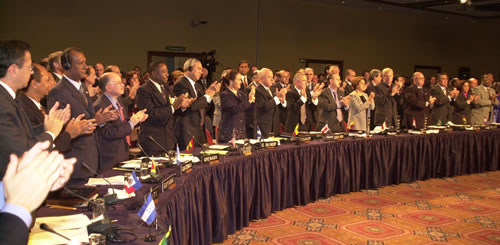
Adopted On September 11th, 2001, in Lima, Peru, by Special Session of the OAS General Assembly, Inter-American Democratic Charter aims to strengthen democratic institutions in the hemisphere and provides the peoples of the Americas the right to democracy, and their Governments’ obligation to promote and defend it. It further claims democracy as essential for the social, political, and economic development of the peoples of the Americas. The Charter has been invoked two times since its adoption: Venezuela in 2002 and Honduras in 2009.
| Applications of the Inter-American Democratic Charter |
| Year |
Country |
Situation |
Application |
| 2002 |
Venezuela |
Coup d’état against President Hugo Chávez |
Article 20 |
2003, 2005
and 2008 |
Bolivia |
Successive political crises and violent street protests |
General invocation |
| 2004 |
Peru |
Confrontation between the State powers |
General invocation |
| 2004 and 2005 |
Nicaragua |
Confrontation between President Enrique Bolaños and the Parliament |
Article 18 |
| 2005 |
Ecuador |
President Lúcio Gutiérrez removed the Supreme Court magistrates and unconstitutionally appointed new members |
Article 18 |
| 2009 |
Honduras |
Coup d’état against President Manuel Zelaya. Honduras is suspended from the OAS |
Article 20
and 21 |
RELEVANT DOCUMENTS
SPEECHES
- Diego García Sayán, Foreign Minister of Peru, September 10th 2001 Español
- César Gaviria, OAS Secretary General, September 11th 2001 English | Español
- César Gaviria, OAS Secretary General, September 16th 2002 EnglishEspañol
- Alejandro Toledo, President of Peru, September 16th 2002 English
- Barbara Mcdougall, President of the Canadian Institute for International Affairs, September 16th 2002 English
- Colin Granderson, Assistant Secretary General, CARICOM, September 16th 2002 English
- Eduardo Stein, former Foreign Minister of Guatemala, September 16th 2002 English
- Fernando Noriega, US Permanent Representative to the OAS, September 16th 2002 English
- Odeen Ishmael, Ambassador of Guyana to the OAS, September 16th 2002 .English
- John Maisto, US Permanent Representative to the OAS, September 12th 2006 English
- José Miguel Insulza, OAS Secretary General, September 10th 2009 Español
PRESS RELEASES
September 10th 2009
- OAS Secretary General highlights strength and potential of IADC.pdf
September 11th 2001
- Foreign Ministers of the Americas adopt IADC English | Español
- Statement from the OAS General Assembly English | Español
- Colin Powell thanks Foreign Ministers' solidarity English | Español
- OAS Secretary General condemns acts of terrorism Español
September 10th 2001
September 6th 2001
- OAS Permanent Council approves draft Inter-American Democratic Charter English | Español
August 9th 2001
- OAS and Peru sign agreement for Special General Assembly English
|
2002 |
DECLARATION OF SOUTH AMERICA AS A ZONE OF PEACE AND COOPERATION |
Guayaquil, Ecuador
July 26th-27th 2002
At the Second Meeting of Presidents of South America on July 26 and 27, 2002; South American countries agreed to ban the use or threat of force among them selves, maintaining the principles of the OAS and UN Charters. Participating states are also urged to combat the dissemination and selling of small arms and light weapons throughout South America.
RELEVANT DOCUMENTS
- Declaration Regarding South America to be a Zone of Peace and Cooperation English
- UN General Assembly Press Release English
|
2002 |
INTER-AMERICAN CONVENTION AGAINST TERRORISM |
| Bridgetown, Barbados
June 3rd 2002

Official Photo of the XXXII OAS General Assembly
The Inter-American Convention Against Terrorism was adopted at the Thirty-second regular session of the General Assembly on June 3rd 2002 in Bridgetown. The Convention commits state parties to take certain measures to prevent, combat, and eradicate the financing of terrorism and to deny safe haven to suspected terrorists. The Convention provides for enhanced cooperation in a number of areas, including exchanges of information, border control measures, and law enforcement actions.
It entered into force on July 10th 2003, The OAS member states commemorated its entry into force on July 14th, during a meeting of anti-terrorism experts convened at the OAS headquarters by the Inter-American Committee Against Terrorism (CICTE).

OAS Secretary General, César Gaviria, with Dame Billie Miller, President of the XXXII General Assembly, and OAS Assistant Secretary General, Luigi Einaudi, at the closing ceremony
RELEVANT DOCUMENTS
PRESS RELEASES
|
2002 |
ANDEAN CHARTER FOR PEACE AND SECURITY |
| Lima, Peru
June 17th 2002
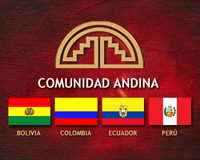
On June 17th 2002, The Ministers of Foreign Affairs and of Defense of Bolivia, Colombia, Ecuador, Peru and Venezuela, met in Lima, Peru to analyze the proposal put forward by President Alejandro Toledo to promote a shared sense of security and security and to expand confidence-building measures and implement initiatives designed to help limit foreign defense spending.
RELEVANT DOCUMENTS
- Andean Charter for Peace and Security and the Limitation and Control of the Expenditure of Foreign Defense English
|
2002 |
SPECIAL MISSION FOR THE STRENGTHENING OF DEMOCRACY IN HAITI |
|
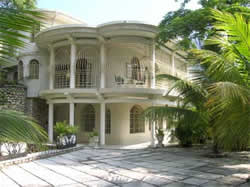 In December 2001, an attempt of coup d’état triggered a deep political crisis, causing numerous deaths and violent repression of dissidents, electoral difficulties and serious breaches of the rule of law. In January 2002, the Permanent Council of the OAS adopted Resolution 806, which urged the Government of Haiti to immediately address the recurring acts of violence and human rights violations. The OAS deployed a Special Mission for the Strengthening of Democracy in Haiti, with the mandate to support the Government and people of Haiti in bolstering democratic institutions, especially in the areas of security, justice and human rights and to carry out an independent investigation of the violent deaths of December 17th, 2001. In December 2001, an attempt of coup d’état triggered a deep political crisis, causing numerous deaths and violent repression of dissidents, electoral difficulties and serious breaches of the rule of law. In January 2002, the Permanent Council of the OAS adopted Resolution 806, which urged the Government of Haiti to immediately address the recurring acts of violence and human rights violations. The OAS deployed a Special Mission for the Strengthening of Democracy in Haiti, with the mandate to support the Government and people of Haiti in bolstering democratic institutions, especially in the areas of security, justice and human rights and to carry out an independent investigation of the violent deaths of December 17th, 2001.
The Investigation Committee recommended the prosecution of all persons involved in the violence and to grant reparations/remedies to the victims. It further recommended the reform of the judicial system as well as of all measures related to law enforcement actions, human rights and the media. Public security experts arrived in 2003 as observers and reported on the behavior of law enforcement in the country and provided technical assistance to Haitian agencies. In April 2004, The United Nations Security Council adopted Resolution 1542, which created the United Nations Mission for Haiti’s Stability (MINUSTAH). MINUSTAH worked jointly with the OAS Special Mission.
Democratic consolidation was strengthened with a program of electoral technical assistance in 2005, which supported Haiti’s provisional electoral council to create a public registry of voters.
The mandate of the Electoral Technical Assistance Program launched a massive campaign of voter registration and helped develop the technology and the logistics needed to produce and distribute identification documents. Through this program, 4.2 million Haitians were registered. The electronic database created served as the foundation for a permanent public registry, an important step in the institutional development of the country.
The Program was especially helpful from the point of view of the technology transfer, which brought about the optimization of all activities such as electronic ballots, electoral lists, minutes, and their online publication. Since 2007, more than 650,000 new citizens have been registered, which added to the number of 2005, translates to a total of 4.15 million identified people.
The OAS mission has helped the Haitian government by providing training to more than 250,000 Haitian public officers, which has significantly strengthened the civil registry. The inter-American commission on human rights and the office of the Special Rapporteur for freedom of expression worked jointly with the United Nations and provided support to the special mission in the field of human rights.
The OAS mission helped the Haitian government by providing training to more than 250,000 Haitian public officers, which significantly strengthened the civil registry. The inter-American commission on human rights and the office of the Special Rapporteur for freedom of expression worked jointly with the United Nations and provided support to the special mission in the field of human rights.
From 2007 onwards, the work of the Special Mission was incorporated into the OAS’ Country Office in Haiti.
RELEVANT DOCUMENTS
|
2002 |
FACILITATION MISSION TO VENEZUELA |

In April 2002, the OAS Secretary General led a mission to Venezuela to investigate the alteration of the constitutional order and acts of violence which resulted in the loss of human lives. In a climate of confrontation and extreme political polarization, the OAS, together with the Carter Center and the United Nations Development Program, facilitated a national dialogue to promote a peaceful resolution to the political crisis. The negotiations between the Government and the opposition groups culminated in August 2003 with the signing of the “Agreement of the Forum for Negotiation and Agreement” which proposed a constitutional solution through an electoral process. The OAS offered its technical assistance and in 2004 sent an Electoral Observation Mission for the Presidential Revocatory Referendum, which took place in a peaceful and orderly manner.
RESOLUTIONS:
SPEECHES:
PRESS RELEASES:
REPORTS:
|
2003 |
RECOGNITION OF THE SOUTH AMERICAN ZONE OF PEACE AND COOPERATION |
| Santiago, Chile
June 10th 2003

On June 10th 2003, the OAS General Assembly recognized and underscored the benefits of the Declaration of South America as a Zone of Peace and Cooperation of 2002. Member states are encouraged to conduct seminars, courses, and studies on the maintenance of the Zone of Peace.
RELEVANT DOCUMENTS
|
2003 |
DECLARATION OF SECURITY IN THE AMERICAS |
Mexico City, Mexico
October 28th 2003
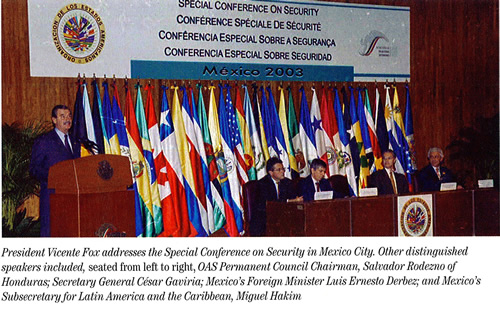
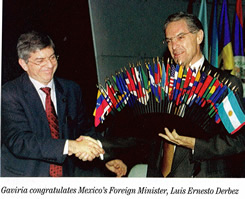 The Hemisphere’s Ministers of Foreign Affairs and other high-level delegates from the 34 member countries of the OAS convened at the Special Conference on Security in Mexico City and adopted this wide-ranging document that affirms shared values and outlines commitments and measures for cooperative action in maintaining peace and security. The Declaration also addresses new types of security threats, concerns, and challenges, such as natural disasters and pandemics, as cross-cutting problems that require close cooperation between governments, as well as with the private sector, and civil society. The Hemisphere’s Ministers of Foreign Affairs and other high-level delegates from the 34 member countries of the OAS convened at the Special Conference on Security in Mexico City and adopted this wide-ranging document that affirms shared values and outlines commitments and measures for cooperative action in maintaining peace and security. The Declaration also addresses new types of security threats, concerns, and challenges, such as natural disasters and pandemics, as cross-cutting problems that require close cooperation between governments, as well as with the private sector, and civil society.
RELEVANT DOCUMENTS
- OEA/Ser.K/XXXVIII English
- Declaration on Security in the Americas English
|
2003 |
CONSENSUS OF MIAMI ON CONFIDENCE AND SECURITY BUILDING MEASURES |
| Miami, United States
February 4th 2003
OAS General Assembly resolution AG/RES.1880 (XXXII-O/02) convened the Meeting of Experts as follow-up to the first Meeting of Experts in Buenos Aires (1994) and the regional conferences of Santiago (1995) and San Salvador (1998) on confidence- and security-building measures in order "to evaluate implementation and consider next steps to further mutual confidence," and "to transmit the conclusions and recommendations of the Meeting of Experts to the preparatory body of the Special Conference on Security as a contribution to the preparation of that Conference."
Member countries agreed on both general and military measures designed to promote a culture of peace, which include a program of notification to joint military exercises, participation in arms monitoring and disposal, the exchange of various types of military-related information, the establishment of confidence-building measures in border zones, and the intensification of cooperation within the OAS framework to combat terrorim, drug trafficking, arms distribution, and piracy.
RELEVANT DOCUMENTS
|
2004 |
MISSION TO SUPPORT THE PEACE PROCESS IN COLOMBIA MAPP/OEA |
|
January 23rd, 2004

On January 23rd, 2004, the Government of Colombia and the OAS Secretary General signed an agreement to establish a Mission to Support the Peace Process in Colombia (MAPP/OEA), which included the verification and monitoring of the cease-fire and cessation of hostilities, demobilization, disarmament and reintegration activities and accompaniment to the communities’ victims of violence. The Mandate of the Mission was formulated in broad terms, under the principles of autonomy, neutrality, and flexibility, allowing it to work on different areas that contribute to peace-building, including: verification of the handover, custody and destruction of weapons from illegal armed groups, supporting the efforts of the Government and civil society, and also local initiatives in conflict zones to build trust, reduce tensions, strengthen democracy and promote reconciliation. In 2009, the Mandate of MAPP/OEA was extended until 2011.
RELEVANT DOCUMENTS
- Condemnation of Terrorist Acts in Colombia CP/RES. 837 (1354/03)
- Support to the Peace Process in Colombia CP/RES. 859 (1397/04)
- Mandato: Convenio entre el Gobierno de la República de Colombia y la secretaria general de la OEA para el acompañamiento al Proceso de Paz en Colombia con los Grupos Armados Ilegales (Only available in Español)
- Presentación Proceso de Paz ante la OEA: Presentación del avance del proceso de Paz ante la OEA (Orly available in Español)
- Speech of Marcelo Álvarez, Chief of the MAPP/OAS, at the Inter-American Peace Forum 2010 (Only available in Español)
Learn More http://www.oas.org/sap/peacefund/PeaceMissions/
Mapp official website: http://www.mapp-oea.net/
|
2005 |
POLITICAL CRISIS MISSIONS: SPECIAL MISSION TO BOLIVIA |
|
 In the case of Bolivia, the OAS provided their services to the electoral process, creating a Special Mission to support presidential, legislative, and local elections, elections of a constituting assembly, and an autonomous referendum. The participation of the OAS as observer during the tense election period, helped guarantee transparency of the elections and thus, engendered more confidence in the authorities and candidates. In the case of Bolivia, the OAS provided their services to the electoral process, creating a Special Mission to support presidential, legislative, and local elections, elections of a constituting assembly, and an autonomous referendum. The participation of the OAS as observer during the tense election period, helped guarantee transparency of the elections and thus, engendered more confidence in the authorities and candidates.
|
2005 |
POLITICAL CRISIS MISSIONS: SPECIAL MISSION TO ECUADOR |
|
 In Ecuador, the Secretary General established a Special Mission to support the selection process of the Supreme Court members during the months from July to November. The Organization helped the country during the difficult process of restoring the Supreme Court after a long political and institutional crisis, which sparked the demise of President Lucio Gutierrez and the assent to power of President Alfredo Palacio. In Ecuador, the Secretary General established a Special Mission to support the selection process of the Supreme Court members during the months from July to November. The Organization helped the country during the difficult process of restoring the Supreme Court after a long political and institutional crisis, which sparked the demise of President Lucio Gutierrez and the assent to power of President Alfredo Palacio.
Since the country had been without a Supreme Court for over a year, when the Special Mission arrived in Ecuador, their priority to restore confidence in the country. This was achieved through a media campaign. The work done in restructuring governmental institutions, was possible thanks to the coordinated actions of the OAS, the United Nations and the Andean Community of Nations, as well as the national agencies and civil society.
|
2005 |
POLITICAL CRISIS MISSIONS: SPECIAL MISSION TO HAITI |
|
 A year later, In Haiti, national elections were finally held after many delays and challenges. In light of the events of 2004, which saw the ousting of former President Aristide, it is important to underscore that the Haitian electoral process should be seen as a vital step in the democratization of the country. The OAS program had to overcome many obstacles such as the high degree of political polarization, the lack of security in many areas of the country, and the limited infrastructure. The success achieved was due not only to the technical ability of the OAS officers, but rather, to more than seventeen years of acquired knowledge, experience and commitment in Haiti, as well as to the excellent coordination and cooperation among the national and international actors. A year later, In Haiti, national elections were finally held after many delays and challenges. In light of the events of 2004, which saw the ousting of former President Aristide, it is important to underscore that the Haitian electoral process should be seen as a vital step in the democratization of the country. The OAS program had to overcome many obstacles such as the high degree of political polarization, the lack of security in many areas of the country, and the limited infrastructure. The success achieved was due not only to the technical ability of the OAS officers, but rather, to more than seventeen years of acquired knowledge, experience and commitment in Haiti, as well as to the excellent coordination and cooperation among the national and international actors.
|
2005 |
POLITICAL CRISIS MISSIONS: SPECIAL MISSION TO NICARAGUA |
|
 The OAS supported the Government of Nicaragua and the various political and social actors to facilitate a dialogue between the Government and the main Nicaraguan parties. These accomplishments took place in a political crisis that jeopardized the governability of the country. The Framework Law, which was a result of the negotiations between the different actors, incorporated the agreements reached and succeeded in institutionalizing the dialogue and creating a roundtable with the presence of the Catholic Church and the OAS as Guarantors, thus facilitating the legislative task. The OAS supported the Government of Nicaragua and the various political and social actors to facilitate a dialogue between the Government and the main Nicaraguan parties. These accomplishments took place in a political crisis that jeopardized the governability of the country. The Framework Law, which was a result of the negotiations between the different actors, incorporated the agreements reached and succeeded in institutionalizing the dialogue and creating a roundtable with the presence of the Catholic Church and the OAS as Guarantors, thus facilitating the legislative task.
2005 proved to be a positive year for the Americas, as many political crisises were overcome, thanks to the combined assistance of the OAS and other actors. Member states have increasingly more frequent and diverse demands and as a consequence, the OAS will have to continue to adapt to changing situations in order to continue to play a vital role in the hemisphere.
|
2008 |
INTER-AMERICAN PEACE FORUM |
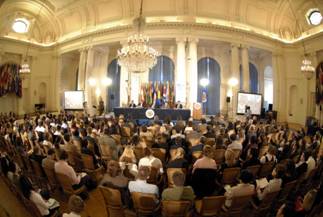
The Inter-American Peace Forum was launched by Secretary General of the Orgaization of American States, Jose Miguel Insulza and Nobel Peace Laureate and former President of Costa Rica, Oscar Arias on September 23rd, 2008 and operates under the Peace Fund. The Forum operates within the framework of the Peace Fund and is dedicated to developing a series of activities such as conferences, seminars on the subject of peace and conflict management, specialized reports and publications; the promotion of leadership, as well as other initiatives with special emphasis on the peaceful reolution of conflict and aimed at promoting a culture of peace among the various sectors of inter-American society.
Inter-American Peace Forum 2010
Inter-American Peace Forum 2009
Inter-American Peace Forum 2008
Photo gallery
|
2008 |
III FORUM ON CONFIDENCE AND SECURITY-BUILDING MEASURES |
|
Washington DC, United States
April 15th 2008
These forums originated at the First Summit of the Americas in 1994, when it was agreed to hold what turned out to be the “First Regional Conference on Confidence- and Security- Building Measures” in Santiago, Chile, 1995. In April 2008, the OAS hosted the III Forum to review, evaluate and analyze the implementation of confidence- and security- building measures (CSBMs) in the region.
RELEVANT DOCUMENTS
- Draft Calendar CSH/FORO-III/doc.1/07 rev. 3
- Rules of Procedure CSH/FORO-III/doc.2/08
- Roster of Experts in Confidence- and Security-Building Measures (In fulfillment of operative paragraph 8 of resolution AG/RES. 2270 (XXXVII-O/07) - Confidence and Security Building in the Americas-) CSH/FORO-III/doc.3/08 rev. 2
- Draft Agenda CSH/FORO-III/doc.4/08
- Summary table of Member States' reports on the application of Confidence- and Security-Building Measures for the period 1995 to 2007 CSH/FORO-III/doc.5/08
- Statement by the head of the Delegation of Chile at the Third Meeting of the Forum on Confidence- and Security-Building Measures CSH/FORO-III/INF. 3/08
- Oral Presentation by Ambassador Alexandre Addor-Netto, Secretary of Multidimensional Security, at the Third Forum on Confidence- and Security-Building Measures CSH/FORO-III/INF. 4/08
- Rapporteur’s report (Presented by Second Secretary Gonzalo Talavera Alvarez, Alternate Representative of Peru to the OAS) CSH/FORO-III-6/08 rev. 1
|
2008 |
VIII CONFERENCE OF MINISTERS OF DEFENSE |
| Banff, Canada,September 6th - 8th, 2008
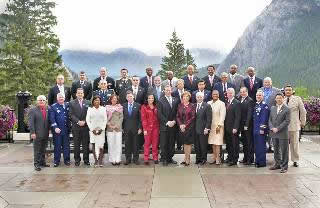 The Conferences of Ministers of Defense of the Americas trace their origins to the Summits of the Americas. During the First Summit of the Americas, the need emerged to organize and connect Defense Ministers to press for further economic and international security. A mandate from that Summit of the Americas led to the first Conference held in Williamsburg, Virginia. In all the subsequent Summits of the Americas, Heads of State and Governments reaffirmed the value of discussing international security and defense themes. The VIII Conference of Ministers of Defense took place in Banff, Canada on September 6th - 8th, 2008. The Conferences of Ministers of Defense of the Americas trace their origins to the Summits of the Americas. During the First Summit of the Americas, the need emerged to organize and connect Defense Ministers to press for further economic and international security. A mandate from that Summit of the Americas led to the first Conference held in Williamsburg, Virginia. In all the subsequent Summits of the Americas, Heads of State and Governments reaffirmed the value of discussing international security and defense themes. The VIII Conference of Ministers of Defense took place in Banff, Canada on September 6th - 8th, 2008.

RELEVANT DOCUMENTS
|
2008 |
FIRST CONFERENCE OF MINISTERS OF PUBLIC SECURITY |
Mexico City, Mexico
October 7th - 8th, 2008
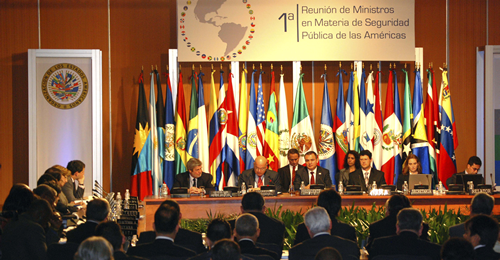
On October 7th - 8th, 2008, the OAS Convened the First Meeting of Ministers of Public Security in Mexico City with Crime and violence as its main theme. The meeting took place in follow-up to the Declaration on Security in the Americas of 2003.
RELEVANT DOCUMENTS
WORKING DOCUMENTS
- Lista de Documentos MISPA/doc. 1/08 (only available in spanish) Español
- Agenda MISPA/doc. 2/08 rev. 1 English
- Schedule MISPA/doc. 3/08 rev. 2 English
- Order of precedence of the delegations MISPA/doc. 4/08 English
- Order of precedence of the permanent observers MISPA/doc. 5/08 English
- Rules of Procedure MISPA/doc. 6/08 rev. 1 English
- Commitment to Public Security in the Americas (Adopted at the seventh plenary session held on October 8, 2008) MISPA/doc. 7/08 rev. 4 English
- Lista de Participantes MISPA/doc. 9/08 English
- Rapporteur’s Report (Presented by Counselor Denys Toscano Amores, Alternate Representative of Ecuador to the OAS) “First meeting of Ministers Responsible for Public Security in the Americas” Mexico city, October 7 and 8, 2008 MISPA/doc. 10/08 rev. 1 English
INFORMATIVE DOCUMENTS
- Preparatory Meeting for the First Meeting of Ministers responsible for Public Security in the Americas Crime and Violence: Civil Society perspectives Guatemala City, Guatemala, August 6 and 7, 2008 MISPA/INF. 1/08 English
- Preparatory Meeting for the First Meeting of Ministers responsible for Public Security in the Americas: Input from Latin American Academics and Experts Santiago, Chile, November 26 and 27, 2007 MISPA/INF. 2/08 English
- Preparatory Meeting for the First Meeting of Ministers of the Americas responsible for Public Security: Input from Caribbean Academics and Experts Montego Bay, March 6-7, 2008 MISPA/INF. 3/08 English
- Some considerations regarding the proposal to create an Inter-American Police Academy (Document prepared by the General Secretariat) MISPA/INF. 4/08 English
- UN-Habitat Statement at the First Meeting of the Ministries responsible for Public Security in the Americas Organization of America States MISPA/INF. 5/08 English
- Address by the President of the United Mexican States, Felipe Calderón, at the inaugural session of the First Meeting of Ministers Responsible for Public Security in the Americas MISPA/INF. 8/08 English
- Address by the Secretary of Public Security of the United Mexican States, Genaro García Luna, at the inaugural session of the First Meeting of Ministers Responsible for Public Security in the Americas MISPA/INF. 9/08 English
- Shorthand version of the closing session of the First Meeting of Ministers of Public Security of the Americas OAS Secretary General Dr. José Miguel Insulza MISPA/INF. 12/08 English
- Transcription of the closing session of the First meeting of Ministers Responsible for Public Security in the Americas Secretary of State Security of the United Mexican States – Genaro García Luna MISPA/INF. 13/08 English
- Statement by Civil Society Organizations on the First Meeting of Ministers Responsible for Public Security in the Americas MISPA/INF. 14/08 English
- Remarks by the Secretary General of the OAS, José Miguel Insulza. Opening ceremony of the First Meeting of Ministers Responsible for Public Security in the Americas October 7, 2008, Mexico MISPA/INF. 15/08 English
- Remarks by Attorney General Michael B. Mukasey at the opening of first meeting of Ministers Responsible for Public Security in the Americas Mexico City October 7, 2008 MISPA/INF. 16/08 English
PHOTO GALLERY
- First Inter-American Meeting of Ministers Responsible for Public Security Visit Gallery
MEETING'S OFFICIAL WEBSITE
|
2009 |
DECLARATION OF SAN PEDRO SULA: TOWARD A CULTURE OF NON-VIOLENCE |
San Pedro Sula, Honduras
June 4th 2009
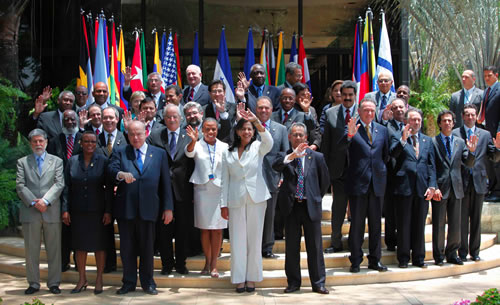
The Declaration of San Pedro Sula: Toward a Culture of Non-Violence was passed on June 4th 2009 at the Thirty-ninth Regular Session of the OAS General Assembly in San Pedro Sula, Honduras. The Declaration seeks to strengthen the efforts already developed, and emphasizes the important role that Governments have to play in the promotion of a culture of peace and the disastrous consequences that violence has on vulnerable groups such as women, children and the elderly. Furthermore, the Declaration underscores the need to safeguard the rights of and respect for indigenous peoples, persons of African descent, migrants and their families, and individuals in vulnerable situations. Member states stressed the need to strengthen cooperation on efforts to combat drug trafficking, alcohol abuse, criminal gangs, problems in prison systems and commercial sexual exploitation of children and adolescents.
RELEVANT DOCUMENTS
PRESS RELEASE
VIDEOS
|
2009 |
SPECIAL MISSION TO HONDURAS |

On June 28th 2009, a coup d'état was staged against the constitutionally established Government of Honduras, and President José Manuel Zelaya was arbitrarily detained and forcibly sent into exile. The OAS General Assembly convened a special session that condemned the events as a coup d’état, which produced an unconstitutional alteration of the democratic order, and demanded President Zelaya’s immediate, safe, and unconditional return to his constitutional functions. The Honduran state was also suspended from the exercise of its right to participate in the OAS, in accordance with Article 21 of the Inter-American Democratic Charter. To date, the OAS continues to exert diplomatic efforts for the full restoration of democracy and the rule of law in Honduras, through the High-Level Commission created by the OAS General Assembly in June 2010, in view of the need by member States of more information on the current status of the political process in Honduras and to analyze the evolution of the situation.
Resolution and Reports:
REPORT OF THE OAS HIGH-LEVEL COMMISSION ON THE SITUATION IN HONDURAS
English
Presented pursuant to resolution AG/RES. 2531 (XL-O/10)
RESOLUTION ON THE SITUATION IN HONDURAS June 8th 2010
English
RESOLUTION ON THE POLITICAL CRISIS IN HONDURAS July 1st 2009
English
SITUATION IN HONDURAS June 26th 2009
English
CURRENT SITUATION IN HONDURAS June 28th 2009
English
REPORT OF THE OAS SECRETARY GENERAL, JOSE MIGUEL INSULZA, ON THE INITIATIVES CARRIED OUT IN THE FRAMEWORK OF THE RESOLUTION OF THE THIRTY-SEVENTH SPECIAL SESSION OF THE OAS GENERAL ASSEMBLY ON THE POLITICAL CRISIS IN HONDURAS, JULY 1st 2009
English
SUSPENSION OF THE RIGHT OF HONDURAS TO PARTICIPATE IN THE ORGANIZATION OF AMERICAN STATES July 4th 2009
English
Learn more: The OAS Commitment to Honduras
|
2010 |
DECLARATION OF LIMA |
Lima, Peru
June 8th, 2010
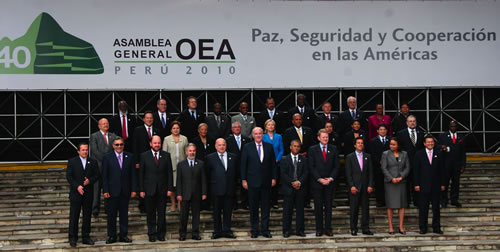
The Declaration of Lima was created on June 8th, 2010 at the Fortieth Regular Session of the OAS General Assembly in Lima, Peru. The Member States reaffirmed their commitment to peace, security and cooperation as the sole mechanisms to confront threats to hemispheric peace. The declaration underscored the Member states’ obligation to avoid the use of force except in cases of legitimate self-defense; the strengthening of inter-American cooperation for integral development; weapons control, resolution of tensions and disputes; and other aspects related to the theme of the Annual Assembly, “Peace, Security and Cooperation.”
RELEVANT DOCUMENTS
- Resolution AG DEC 63 (XL-O/10) English
PRESS RELEASE
VIDEOS
|
2010 |
GOOD OFFICES MISSION TO COSTA RICA AND NICARAGUA |

OAS Photo | Border Zone between Costa Rica and Nicaragua
Following a border issue between Costa Rica and Nicaragua over Calero Island in the San Juan River, the Permanent Council of the Organization of American States met in an emergency session on November 3, 2010 at the request of the Government of Costa Rica. Both countries expressed their desire to resolve the dispute swiftly and pacifically and invited the Secretary General to lead a Mission to the disputed area and report back to the Permanent Council on November 9, 2010 with its findings. During his trip from November 5th-8th 2010, OAS Secretary General, José Miguel Insulza met with the President of Costa Rica, Laura Chinchilla, and Nicaragua, Daniel Ortega, as well as with their respective Foreign Ministers, René Castro and Samuel Santos, and other authorities. Secretary Insulza also flew over both sides of the area involved.
 Photo: Presidency Costa Rica
Photo: Presidency Costa Rica
OAS Secretary General Meets with The President of Costa Rica |
|
 Photo: OAS
Photo: OAS
Above, OAS Secretary General with the President of Nicaragua |
|
|
On November 9th Secretary Insulza presented before the Permanent Council of the Organization his report on the visit conducted, which includes four recommendations on possible points of agreement between the two parties:
1) to hold a meeting of the Binational Committee foreseen for November 27th;
2) to immediately renew conversations on the demarcation of the border;
3) to avoid the presence of the armed or security forces in the area; and
4) to instruct the pertinent authorities to review the mechanisms of bilateral cooperation to combat drug trafficking, organized crime and arms trafficking in the border area.
On November 12th a Special Meeting of the Permanent Council was convened to discuss the adoption of a Resolution based on the four recommendations made by the Secretary General to the Permanent Council. Following an extended debate, CP/RES. 978 (1777/10) was put to vote, and passed with 21 votes for the Resolution, 1 against and 3 abstentions.
On November 18th the Permanent Council met again to discuss a Resolution which would refer the border issue to a Meeting of Consultation of Ministers of Foreign Affairs of the Organization of American States. Costa Rica was exercising its right as stipulated in the Charter of the Organization of American States (1948), Chapter X, Articles 61-65. Following debate in the Permanent Council, a vote was taken in which 22 countries voted in favor of Costa Rica's Resolution, 1 against whilst 7 abstained. On December 7, 2010, at the Meeting of Consultation of Ministers of Foreign Affairs of the Organization of American States (OAS), the delegations of the Member States approved Resolution RC.26/RES. 1/10 on the situation between Costa Rica and Nicaragua with 24 votes in favor, two votes against and five abstentions, whereby they called upon the parties to implement, simultaneously and without delay, the recommendations adopted through resolution CP/RES. 978 (1777/10), "Situation in the Border Area between Costa Rica and Nicaragua," of November 12th 2010.
RELEVANT DOCUMENTS
- Permanent Council Resolution: CP/RES. 978 (1777/10) English | Español
- Permanent Council Resolution: CP/RES. 979 (1780/10) English | Español
- Note from the Mission of Costa Rica English | Español
- Meeting of Consultation of Ministers of Foreign Affairs Resolution: RC.26/Res. 1/10 English | Español
REPORTS
- OAS Secretary General's report on his visit to Costa Rica and Nicaragua English | Español
- OAS Secretary General's report to the 26th Meeting of Consultation of Ministers of Foreign Affairs English | Español
SPEECHES
- José Miguel Insulza, OAS Secretary General, November 18th 2010Español
PRESS RELEASES
March 8th 2011
December 16th 2010
- OAS Secretary General welcomes attempts to renew dialogue bewteen Costa Rica and Nicaragua English | Español
December 12th 2010
- OAS Secretary General regrets it was not possible to restart dialogueEnglish | Español
December 7th 2010
- OAS Meeting of Consultation of Foreign Ministers approves resolution English | Español
- OAS Secretary General delivers report to Foreign MinistersEnglish | Español
November 13th 2010
- OAS Permanent Council approves resolution on Costa Rica-Nicaragua situation English | Español
November 9th 2010
- OAS Secretary General presents recommendations following visit to Costa Rica and Nicaragua English | Español
November 8th 2010
- OAS Secretary General concludes visit to Costa Rica and Nicaragua English | Español
- OAS Secretary General flies over border zone on Costa Rican side English
- OAS Secretary General meets again with President of Costa Rica English
November 7th 2010
- OAS Secretary General visited border zone between Costa Rica and Nicaragua English
November 6th 2010
- OAS Secretary General arrives in Nicaragua English
- OAS Secretary General meets with Costa Rica's President, Laura Chinchilla English
- OAS Secretary General meets with Nicaragua's President, Daniel Ortega English
November 4th 2010
- OAS Secretary General to travel to Costa Rica and Nicaragua to facilitate dialogue English | Español
November 3rd 2010
- OAS Permanent Council Session on the situation beetwen Costa Rica and Nicaragua to reopen tomorrow English | Español
|
2011 |
DECLARATION OF SAN SALVADOR ON CITIZEN SECURITY IN THE AMERICAS |
|
San Salvador, El Salvador
June 5th-7th 2011

On June 5th-7th 2011, the OAS member states met in San Salvador, El Salvador for the 41st General Assembly to create a common platform with which to combat organized crime, drug trafficking and also address the social factors which promote crime. To this end, they approved the “Declaration of San Salvador on Citizen Security in the Americas”, laying the foundation for a common security plan.
The Declaration of San Salvador on Citizen Security in the Americas highlights the need to continue strengthening bilateral, sub-regional, regional, and international cooperation mechanisms, to address, prevent, and combat, in a comprehensive and effective manner, transnational organized crime, illicit arms trafficking, and other forms of crime. Member States also agreed on the need to focus on programs that combat social conditions which promote crime such as poverty and social exclusion, and committed to improving their judicial, prison and rehabilitation systems.
RELEVANT DOCUMENTS
- Declaration of San Salvador on Citizen Security in the Americas English | Español
PRESS RELEASES
|
2012 |
THE DECLARATION OF COCHABAMBA ON “FOOD SECURITY WITH SOVEREIGNTY IN THE AMERICAS” |
|
Cochabamba, Bolivia
June 6th 2012
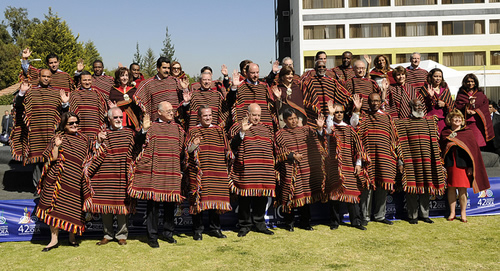
On June 6th 2012, the forty-second regular session of the OAS General Assembly was hosted in Cochabamba, Bolivia to discuss issues on food in the region. From the Session evolved the Declaration of Cochabamba on “Food Security with Sovereignty in the Americas”, which acknowledges the challenges in regards to food, and proposes measures to address the problem. The Assembly recognizes that approximately 53 million people in the region experience chronic hunger or suffer from malnutrition, and that steps need to be taken to strengthen commitments to the right to food; a right that is also outlined in the Universal Declaration of Human Rights and the International Covenant on Economic, Social, and Cultural Rights.
The right to food is vital in maintaining peace as food security helps guarantee that the basic needs of people are met. When basic human needs are met, people are better equipped to prosper and quality of life is significantly improved. The Declaration notes the importance of boosting the production, access and utilization of food, as well as investing in small famers to help eradicate poverty. Member States recognize the need for food research and educational programs to achieve nutrition for all. The concept of “food sovereignty” is discussed, and the Declaration continues by acknowledging that Member States should be able to determine their own food security strategies and that the implementation of these policies in a national responsibility. Food sovereignty plays an important role in preserving international peace as each Member State can choose the methods of securing food that are most appropriate to fit their needs. The Session at Cochabamba stressed the commitment of the Member States to increasing access to clean drinking water and sanitation, but also to the overall advancement of environmental protection in the Americas. The OAS recognizes that food security is necessary in maintaining democracy and promoting peace throughout the region.
 |
|
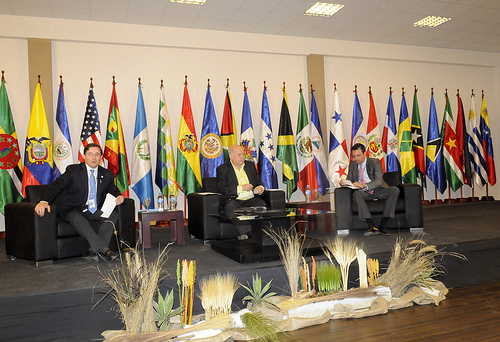 |
| Inauguration of 42nd General Assembly |
|
From left to right: Alfonso Quiñónez, OAS Secretary for External Relations; José Miguel Insulza, OAS Secretary General; Jorge Sanin, Director of the OAS Department of International Affairs |
|
|
RELEVANT DOCUMENTS
- Declaration of Cochabamba on “Food Security With Sovereignty In The Americas” English
Media
|
2015 |
SPECIAL MISSION TO THE DOMINICAN REPUBLIC AND HAITI BORDER |
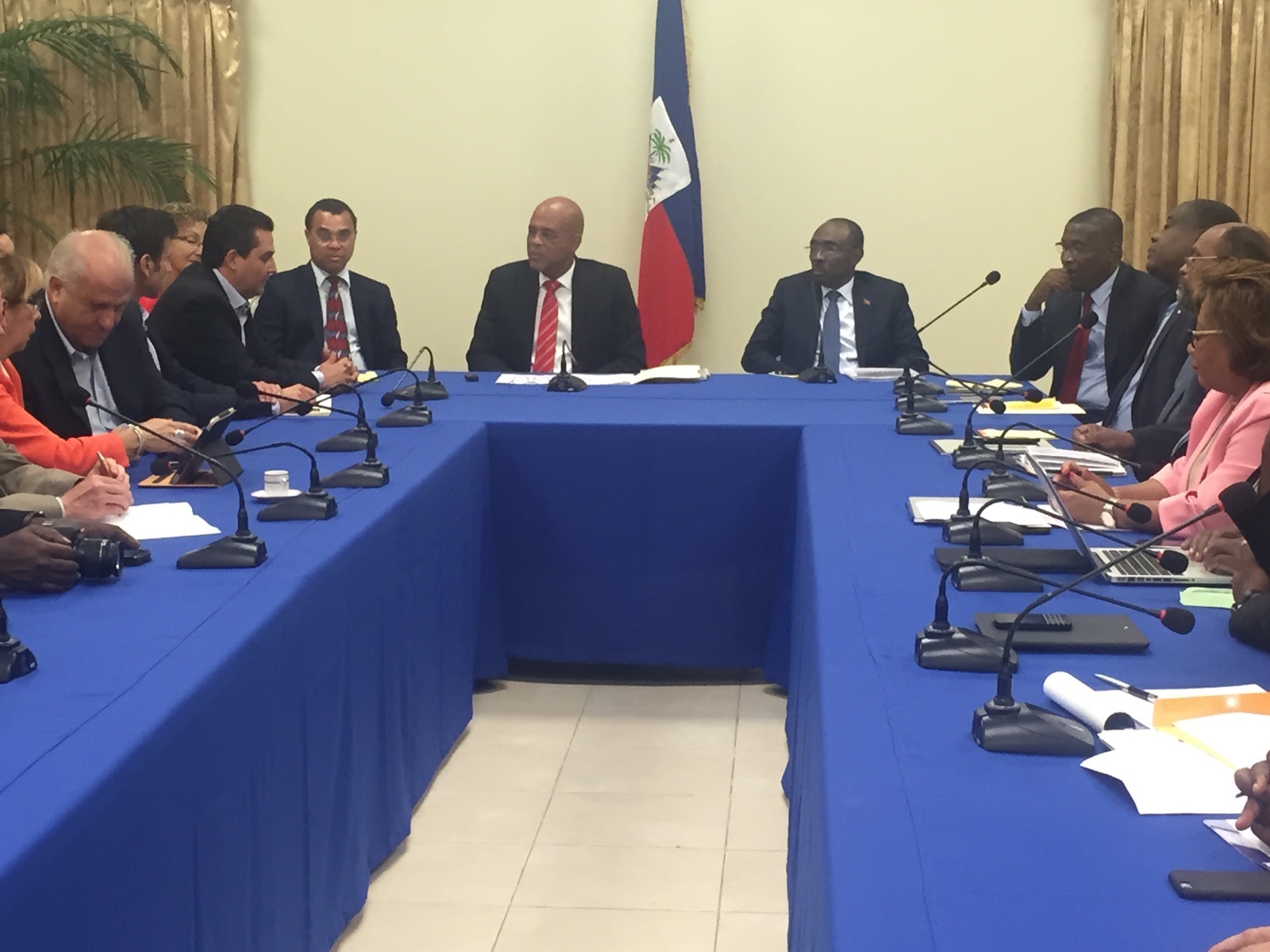 In 2014 the Dominican Republic launched a program to regularize foreigners who were in their territory without legal status. According to current estimates, 87% of the migrants in the Dominican Republic (458,233) were of Haitian origin.
The National Plan for the Regularization of Foreigners (PNRE) was in force between June 2014 and June 2015, and in that period 288,466 people were registered. At the end of the PNRE, the possibility of massive deportations of Haitian citizens from the Dominican Republic to Haiti provoked international concern and intensified diplomatic tensions between the two countries.
As a result, on July 9, 2015, the OAS sent a technical mission headed by the Secretary for Political Affairs and his advisor in order to gather information on the movement of people from the Dominican Republic to Haiti; hear the views of government and non-governmental players in both countries about the situation;, gather available data on the number of persons affected by the new law and their migrant status; and ultimately present the Secretary General of the OAS with a report containing observations and recommendations on what support the Organization of American States could provide to both countries.
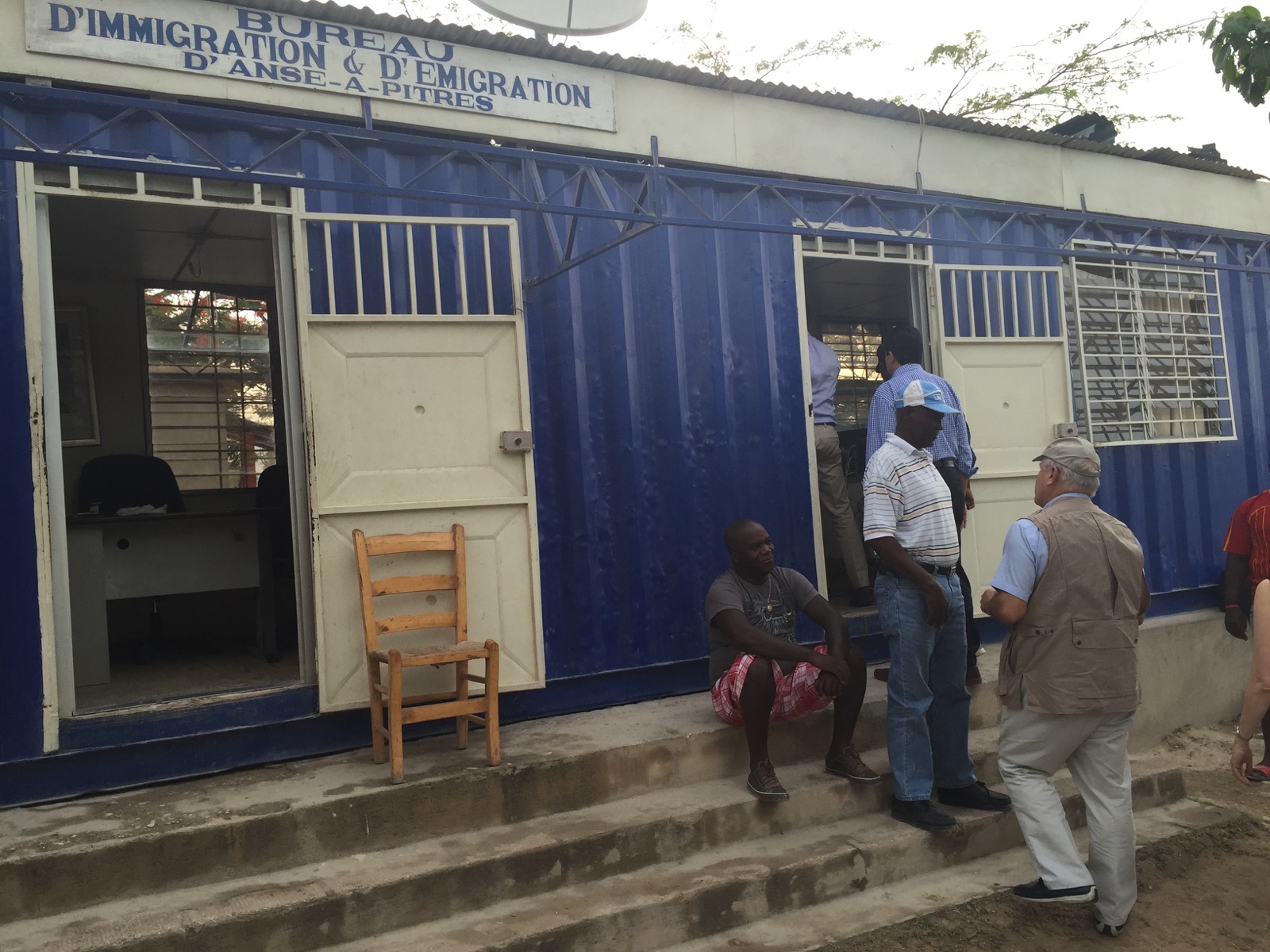
One of the recommendations of the report was to use
the good offices of the OAS to strengthen the
registration and identification processes in Haiti
through the OAS Program for the Universal Civil Identity
Program in the Americas (PUICA by its Spanish acronym).
Between 2016 and 2018 PUICA implemented a technical cooperation
project to provide the Haitian government with
recommendations to improve the delivery of identification
services to Haitian citizens living in the Dominican
Republic.
RELEVANT DOCUMENTS
In 2008, the OAS General Assembly adopted resolution AG/RES. 2362 (XXXVIII-O/08) Inter-American Program for Universal Civil Registry and the “Right to Identity.” This program entrusts the General Secretariat of the OAS to assist Member States in their efforts to achieve universality and accessibility of civil registration.
PRESS RELEASES
- OAS Deploys Mission to Assess Situation of Haitian Migrants (July 9, 2015) English | Español
- Report of the Technical Fact-Finding Mission on the Situation in the
Border Region Between the Dominican Republic and Haiti (July 29,
2015) English | Español
|
2015 |
MISSION TO SUPPORT THE FIGHT AGAINST CORRUPTION AND IMPUNITY IN HONDURAS (MACCIH) |
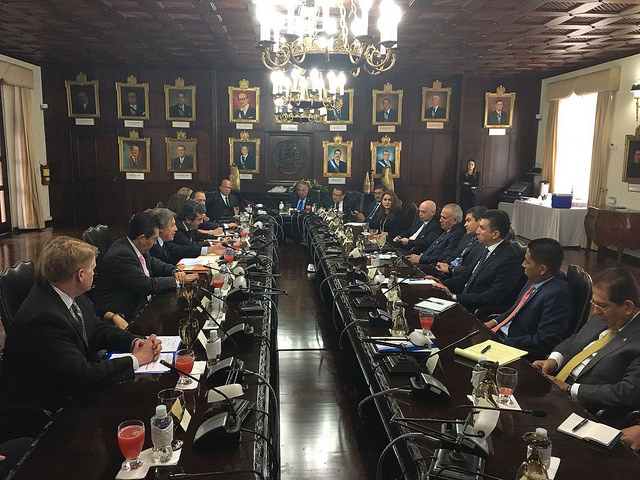
In response to a request made by the Government of Honduras after several conversations with representatives of the Secretary General, the OAS was asked to prepare a long term mission to improve the quality of services provided by the justice system in Honduras, through active cooperation, technical advice, supervision and oversight of the state institutions responsible for preventing, investigating, and punishing acts of corruption.
Corruption and its perception, despite several efforts made by Honduran institutions to stop it, is still one of the main problems this country faces, consistently so, according to public opinion. One of MACCIH main objectives in Honduras is to strengthen institutions and existing personnel. Though it will act as a facilitator and will support investigative processes and the persecution of corruption cases, it will do this in big part by selecting, training and certifying lawyers, judges and experts in Honduran institutions.
A group of international experts, judges and prosecutors will be designated to support authorities and officials in their mission to strengthen the work of the judicial system in the country through consensual work and the assessment of country officials.
Another important line of work established by the MACCIH is its work in collaboration with Civil Society. Working with their expertise in the country, the MACCIH sets out to install an observatory to monitor and evaluate the progress of the Honduran justice system.
The MACCIH will perform its work under the following principles: independence, autonomy, professionalism, neutrality, and transparency. On January 19th 2016, the Agreement to install MACCIH in Honduras was signed at OAS headquarters by the President of Honduras, Juan Orlando Hernández, and the Secretary General of the OAS.
RELEVANT DOCUMENTS
|
2016 |
FINAL AGREEMENT FOR THE TERMINATION OF THE CONFLICT AND THE CONSTRUCTION OF A STABLE AND LASTING PEACE |

The Colombian government and guerrilla group FARC have signed an agreement committing both to end the country’s armed conflict.
Mapp official website: http://www.mapp-oea.net/
RELEVANT DOCUMENTS
- FINAL AGREEMENT FOR THE TERMINATION OF CONFLICT AND THE CONSTRUCTION OF A STABLE AND DURABLE PEACE Español
PRESS RELEASE
- Colombia: OAS Secretary General Calls Final Agreement “Historic Step toward Peace” English | Español
|
|
